immigration reform
description: change to the current immigration policy of a country
133 results
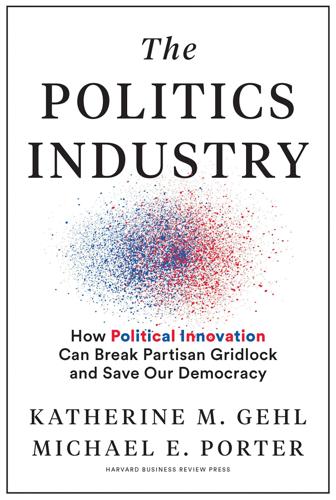
The Politics Industry: How Political Innovation Can Break Partisan Gridlock and Save Our Democracy
by
Katherine M. Gehl
and
Michael E. Porter
Published 14 Sep 2020
Kennedy, knowing that the amendment’s passage would tank the bill, again attacked his fellow Democrat: “Who is the senator from North Dakota trying to fool?” See Orman, Declaration of Independents. 20. Greg Orman, “Debaters Should Press Biden on Killing Immigration Reform in ’07,” RealClearPolitics, October 14, 2019, https://www.realclearpolitics.com/articles/2019/10/14/debaters_should_press_biden_on_killing_immigration_reform_in_07_141490.html. 21. On the campaign trail, months after sinking the deal, Obama pledged he would push for immigration reform in his first year. See Orman, Declaration of Independents. 22. Republicans had hoped that next president would be Mitt Romney, but the 2012 elections did not go according to plan, in no small part because of Hispanic voters.
…
Fortunately, the amendment was rejected.18 But Obama quickly backed another poison pill supported by organized labor to sunset a popular Republican idea to expand the guest-worker program.19 The amendment ultimately passed—by just one vote.20 Immigration reform was dead. Both parties had killed it. While it was a major defeat for the country, the failure of immigration reform was a tactical win for Obama. In today’s politics, taking ideological stands at the expense of actual legislative action can be smart strategy. Obama pandered to his Democratic base, blocked a major legislative victory for future opponent McCain, and kept a highly partisan wedge issue on the table to rally support for the elections.
…
Despite a Democratic supermajority in Congress during his first term, there was no action.21 By the time the Democrats attempted immigration reform in 2013 in the Senate, the Republicans had retaken control of the House and blocked it. The Republicans followed the successful Democratic tactic employed in Bush’s final years: wait for the next president, avoid compromise, and run out the clock.22 The duopoly has continued to fail to solve this critical issue facing the country. Today, in 2020, after more than a decade, there is still no comprehensive immigration reform. Instead, the only steps taken have been partisan decisions by executive action that are challenged by the other side in the courts.
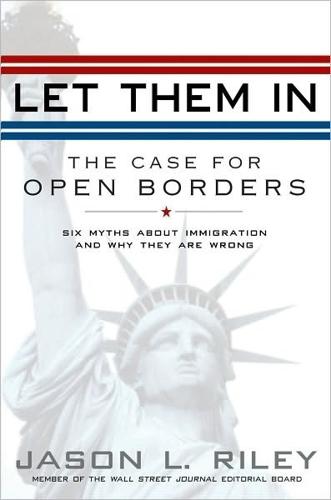
Let Them In: The Case for Open Borders
by
Jason L. Riley
Published 14 May 2008
At such times, we count on our elected leaders to have the courage of their convictions, even when it’s unpopular. Especially when it’s unpopular. The driver’s license brouhaha revealed that when it comes to immigration reform, Senator Clinton and Governor Spitzer lack either courage or conviction. It also revealed that the GOP isn’t the only party struggling with the issue. A Democrat in the White House won’t automatically (or necessarily) fare any better on immigration reform than a Republican. My primary goal in writing this book was to offer a rebuttal to some of the more common anti-immigrant arguments that I’ve come across while covering the issue as a Wall Street Journal editorialist.
…
(“The Sierra Club may not want to touch the immigration issue, but the immigration issue is going to touch the Sierra Club,” he once vowed.) And Tanton-linked groups and individuals have played major roles in drumming up faux grassroots anti-immigration sentiment nationwide. The head of one of Tanton’s major organs, the Federation for American Immigration Reform (FAIR), claims to have testified before Congress more than fifty times. Tanton’s extensive network shows how activists from across the political spectrum and with different agendas—population control, abortion rights, economic protectionism, racial purity— have coalesced around the issue of restricting immigration.
…
The same Colorado study also inflated the costs of educating immigrants by assuming that all illegals between the ages of five and seventeen were in public schools, not accounting for the fact that some were enrolled in private schools and others did not attend school at all. Strayhorn references a report by the nativist Federation for American Immigration Reform that stacks the deck by including as an illegal alien “cost” the education of their American-born children, who are, in fact, U.S. citizens—until a constitutional amendment says otherwise. That’s significant because some two-thirds of the children of illegal immigrants, and 80 percent of the children of legal immigrants, are U.S. born.

The State and the Stork: The Population Debate and Policy Making in US History
by
Derek S. Hoff
Published 30 May 2012
As we have seen throughout this study, historians have focused so intensely on issues of population “quality” (that is, on the racist motivations of population movements) that they have neglected the very real anxiety about population quantity—even among racial liberals. Southern segregationists who opposed immigration reform may have deployed a disingenuous Malthusianism. But more importantly, many liberal advocates of reform, consistent with the unease with demographic change permeating the Great Society, not only argued that immigration reform would and should be demographically neutral but also expressed opposition to domestic population growth from any source. The prospect of population increase was the third rail of the 1960s immigration-reform debate: the range of options considered was limited by the prevailing sense that America already had too large a population.
…
In the 1940s and 1950s, Congress “opened the door a little” in managing the great society’s population growth 159 piecemeal fashion, eroding the quotas through special legislation and increasing the number of refugees from communist states allowed into the United States.152 A coalition of immigration reform advocates coalesced among congressional liberals, religious leaders, and interest groups. Reformers were rejuvenated by the election of John F. Kennedy, a descendant of Irish immigrants and the author of the celebratory Nation of Immigrants (1959).153 But Kennedy moved cautiously on the issue while his bureaucracy crafted a reform package, and immigration reform stalled in the 87th Congress (1961–63). In early 1963, the president announced that immigration reform would be a priority,154 and soon thereafter a major barrier to reform was cleared by the death of Francis Walter (D-Pa.), the virulently anti-reform chair of the House Subcommittee on Immigration and author of the restrictive 1952 McCarran-Walter Act, which became law over President Truman’s veto.
…
The support of reform by lawmakers with a demonstrated aversion to domestic population growth reveals the extent to which reformers believed in the numeric insignificance of immigration. Sen. Tydings was so confident of the demographic unimportance of immigration reform, which he deemed a civil rights measure, that he actually co-sponsored some of the legislation. Tydings argued, “The immigration reform bill will not increase the number of migrants to this country. It will not open the flood-gates or swamp our labor market.”177 Beyond the small group of leaders on population issues, many liberal reformers not only sought reassurances that immigration reform would be net population neutral but also believed the domestic population growth rate was already too high.
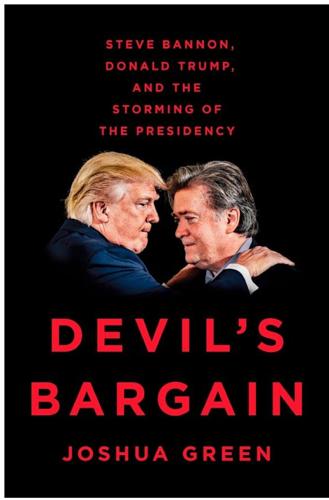
Devil's Bargain: Steve Bannon, Donald Trump, and the Storming of the Presidency
by
Joshua Green
Published 17 Jul 2017
Periodically, these tensions flared up, as they had in 2007 when President George W. Bush, hailing the United States as “a nation of immigrants,” tried to pass an immigration reform bill that would have allowed 12 million undocumented immigrants to become U.S. citizens. His effort was soundly defeated by conservatives in his own party who attacked the “amnesty” Bush was offering to people who had broken the law. As the Republican Party turned once again to immigration reform following Romney’s poor showing with Hispanic voters, these same tensions rose to a boil, even as leaders in both parties, including President Obama, agreed it was time to get something done.
…
“He had a crazy policy”: Ronald Kessler, “Donald Trump: Mean-Spirited GOP Won’t Win Elections, Newsmax, November 26, 2012, http://www.newsmax.com/Newsfront/Donald-Trump-Ronald-Kessler/2012/11/26/id/465363/ “I believe that if we’re successful”: Byron Tau, “Obama: Republican ‘Fever’ Will Break After the Election,” Politico.com, June 1, 2012, www.politico.com/blogs/politico44/2012/06/obama-republican-fever-will-break-after-the-election-125059. Rupert Murdoch, the CEO of News Corp.: Rupert Murdoch, “Immigration Reform Can’t Wait,” Wall Street Journal, June 18, 2014, www.wsj.com/articles/rupert-murdoch-immigration-reform-cant-wait-1403134311. “God bless Fox”: Ryan Lizza, “Getting to Maybe,” New Yorker, June 24, 2013, www.newyorker.com/magazine/2013/06/24/getting-to-maybe. “We have to make America strong again”: Transcript of Donald Trump’s Remarks (2013 Conservative Political Action Conference, March 15, 2013, Washington, DC), Democracy in Action, www.p2016.org/photos13/cpac13/trump031513spt.html.
…
Craighill, “Poll: Trump Surges to Big Lead in GOP Presidential Race,” Washington Post, July 20, 2015, www.washingtonpost.com/politics/poll-trump-surges-to-big-lead-in-gop-presidential-race/2015/07/20/efd2e0d0-2ef8-11e5-8f36-18d1d501920d_story.html?tid=a_inl. over a private dinner in 2013: Jason Horowitz, “Marco Rubio Pushed for Immigration Reform with Conservative Media,” New York Times, February 27, 2016, www.nytimes.com/2016/02/28/us/politics/marco-rubio-pushed-for-immigration-reform-with-conservative-media.html?_r=0. a story published in: Brandy Zadrozny and Tim Mak, “Ex-Wife: Donald Trump Made Me Feel ‘Violated’ During Sex,” Daily Beast, July 27, 2015, www.thedailybeast.com/articles/2015/07/27/ex-wife-donald-trump-made-feel-violated-during-sex.html.
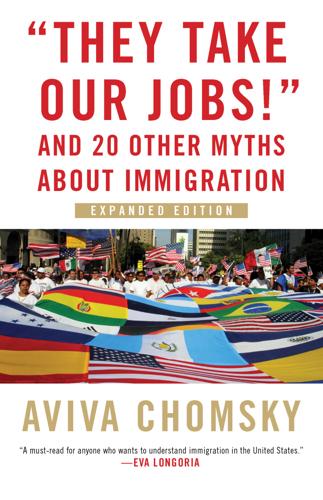
"They Take Our Jobs!": And 20 Other Myths About Immigration
by
Aviva Chomsky
Published 23 Apr 2018
The results were also comparable: increased deportations, the pushing of migrants into more remote and dangerous routes, greater risk of abuse and violence, yet little slowing of migrant flows.6 As journalist Manuel Bojórquez reported, “The Obama administration wants to stem the flow of children entering the United States illegally by highlighting the perils of the journey. But many young immigrants say they know the dangers. They believe the risk at home is greater.”7 DONALD TRUMP, IMMIGRATION, AND THE WORKING CLASS It wasn’t that big a jump from President Bill Clinton’s criminalization of immigrants with the 1996 Illegal Immigration Reform and Immigrant Responsibility Act (IIRIRA) to Obama’s recriminalization with humanitarian exceptions, to candidate and then president Donald Trump’s repeated references to immigrants as “rapists,” “criminals,” “bad hombres,” and “bad dudes.” Nativism had become one arm of a multifaceted project of the criminalization of people of color, with mass incarceration, expansion and militarization of the police, and the creation of a climate of fear so as to justify the growth and institutionalization of a repressive apparatus at home and abroad.
…
Keeping some people outside of the bounds of equality and citizenship served employers’ need for cheap labor in the past, and continues to do so today. So let’s return to the original question: do immigrants compete with low-skilled workers for low-paying jobs? Yes. But the reason that this competition exists is because too many people are deprived of rights. The proposals for immigration reform that are circulating today do nothing to expand the rights of those currently excluded—in fact they do just the opposite. Further restrictions on immigration will not lower the numbers of immigrants—as long as the demand for labor is there, history has shown that immigrants will keep coming.
…
Even those who had been in the United States for ten years or more in 2003 had a family income of only $29,900—as compared to natives, whose family incomes averaged $45,900, refugees at $45,200, legal permanent residents at $44,600, and naturalized citizens at $56,500.7 It’s not surprising, then, that 39 percent of undocumented immigrant children live below the poverty line, and 53 percent lack health insurance.8 The results of the 1986 Immigration Reform and Control Act, which granted amnesty to a significant portion of the undocumented population then in the United States, are also clear. Once they achieved legal status, migrants were able to improve their levels of education and income.9 By maintaining arbitrary status differences and excluding millions of people from legal rights, and by ensuring that immigrants will continue to arrive, and that some will continue to be classed as “illegal,” U.S. policies guarantee the existence of a permanent underclass.
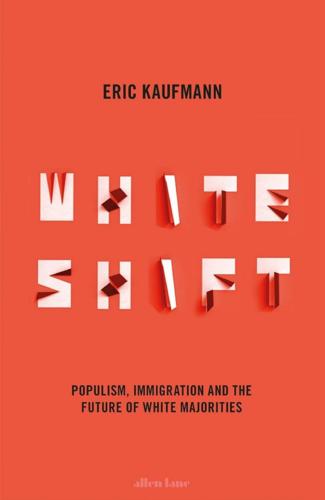
Whiteshift: Populism, Immigration and the Future of White Majorities
by
Eric Kaufmann
Published 24 Oct 2018
But in the 1996 election campaign Dole made immigration one of his issues, and vowed to outdo Clinton on border security and deportation. Meanwhile, in 1994, a bipartisan Commission on Immigration Reform chaired by African-American Congresswoman and Democrat Barbara Jordan tabled its long-awaited report. Its remit involved travelling the country to take soundings from ‘Town Hall’-style meetings. The commission recommended increasing money for the border patrol, setting up a computerized registry, enacting employer sanctions and reducing legal immigration to 550,000. The report’s findings informed President Clinton’s Illegal Immigration Reform and Immigrant Responsibility Act (IIRIRA) of 1996. Though border enforcement was beefed up, employer sanctions were never properly enforced, which reduced the effectiveness of the measures.
…
The RNC, Karl Rove, Grover Norquist, 100 conservative economists, the CATO Institute and the Wall Street Journal urged congressmen to pass the bill.92 All Democrats were now onside, but when the bill came to the Republican-controlled House it suffered a crushing defeat. Why did immigration reform fail? In a perceptive analysis, Christopher Parker of the University of Washington argues: ‘House Republicans aren’t motivated by true conservatism. Rather, they represent constituencies haunted by anxiety associated with the perception that they’re “losing their country” to immigrants from south of the border.’ Parker noted that over a quarter of Republican legislators won seats due to endorsement from the Tea Party. Parker identified a 70 per cent overlap between the Congressional Immigration Reform Caucus, which Tancredo had founded, and congressmen supported by the Tea Party.
…
Surveys also showed that the proportion of Americans calling for fewer immigrants had declined from 40 per cent in 1953 to 32 per cent in 1965. In that year, 51 per cent of the public approved of the shift to a ‘colour-blind’ policy based on job skills, while just 32 per cent wished to retain the National Origins quota system.55 Institutional barriers and public opinion had budged enough to permit immigration reform. This came with the 1965 Hart–Celler Act, which passed overwhelmingly in Congress, with support from both parties. However, during debates over the Act, sponsors of the bill deemed it necessary to reassure Congress that cultural change would be minimal. Since the bill was based on family reunification, they argued, it favoured existing groups.
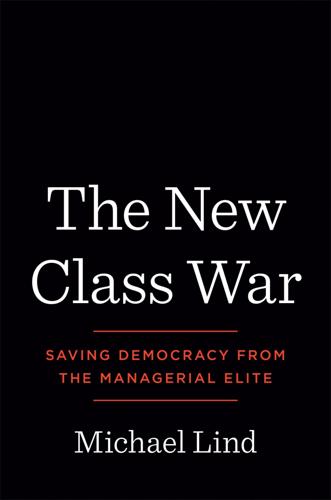
The New Class War: Saving Democracy From the Metropolitan Elite
by
Michael Lind
Published 20 Feb 2020
“Germany’s Green Party Finds a Haven in Heidelberg,” DW.com, July 24, 2017. 6. Vernon Briggs, “Illegal Immigration and the Dilemma of American Unions,” History News Network, March 7, 2011. 7. U.S. Commission on Immigration Reform, “Legal Immigration: Setting Priorities” (Washington, DC: U.S. Commission on Immigration Reform, 1996); U.S. Commission on Immigration Reform, “Becoming an American: Immigration and Immigrant Policy” (Washington, D.C.: U.S. Commission on Immigration Reform, 1997). 8. Quoted in Rhonda Fanning, “What Barbara Jordan & Current GOP Rhetoric Have in Common,” Texas Standard, February 16, 2016. 9. Erik Ruark, “Misuse of Barbara Jordan’s Legacy on Immigration is Wrong, No Matter Who Does It,” NumbersUSA, January 17, 2019. 10.
…
The historian of organized labor Vernon Briggs observed that “it is not surprising that at every juncture and with no exception prior to the 1990s, the American labor movement either directly instigated or strongly endorsed every legislative initiative by the US Congress to regulate and to restrict immigration. It also supported all related efforts to strengthen enforcement of these policies.”6 In the 1990s the US Commission on Immigration Reform was appointed by President Bill Clinton, at a time when the Democratic Party was still influenced in part by the historic skepticism of organized labor toward large-scale immigration. While denouncing bigotry against immigrants, the commission called for reducing legal immigration, shifting the basis of immigration away from family relationships toward skills, and promoting the integration of immigrants.7 In the words of the chair of the commission, Barbara Jordan, the first African American woman from the South to be elected to Congress, “The commission finds no national interest in continuing to import lesser skilled and unskilled workers to compete in the most vulnerable parts of our labor force.”8 Jordan also rejected efforts to blur the distinction between legal and illegal immigration: “To make sense about the national interest in immigration, it is necessary to make distinctions between those who obey the law, and those who violate it.
…
Immigration and the Changing Face of Rural America (New Haven, CT: Yale University Press, 2009). 22. Robert Shapiro, “Race, Ethnicity, and the Job Market,” Journal of Democracy, no. 53, Summer 2019. 23. Patricia Cohen, “Is Immigration at Its Limit? Not for Employers,” New York Times, August 22, 2019. 24. Matthew Yglesias, “DREAM On: America Needs Much Bigger, Bolder Immigration Reform—for Low-Skilled Workers, Not Just Supergeniuses—to Boost the Economy,” Slate, June 20, 2012. 25. “The Impact of Illegal Immigration on the Wages and Employment Opportunities of Black Workers: A Briefing Before the United States Commission on Civil Rights” (Washington, DC: U.S. Commission on Civil Rights, August 2010). 26.
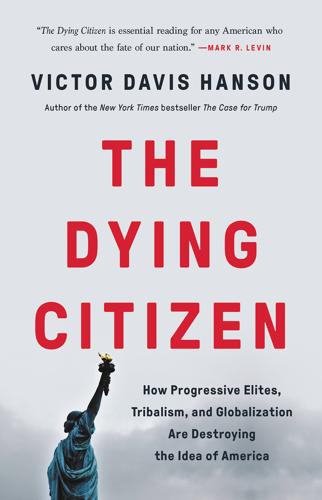
The Dying Citizen: How Progressive Elites, Tribalism, and Globalization Are Destroying the Idea of America
by
Victor Davis Hanson
Published 15 Nov 2021
For the most recent data regarding lawful immigration, see “Yearbook of Immigration Statistics 2017,” US Department of Homeland Security, www.dhs.gov/immigration-statistics/yearbook/2017. 11. On immigration legislation, see Jerry Kammer, “The Hart-Celler Immigration Act of 1965,” Center for Immigration Studies, September 30, 2015, https://cis.org/Report/HartCeller-Immigration-Act-1965; Dan Moffett, “The Immigration Reform and Control Act of 1986,” ThoughtCo., August 26, 2020, https://thoughtco.com/immigration-reform-and-control-act-1986-1951972; P. Schey, “Supply-Side Immigration Theory: Analysis of the Simpson/Mazzoli Bill,” In Defense of the Alien 6 (1983): 53–77. On the explosion of illegal immigration in the years following the bill, see Brad Plumer, “Congress Tried to Fix Immigration Back in 1986.
…
Former President Trump stated that the cost of illegal immigration (i.e., the cost of services received minus their tax contributions) is over $200 billion annually and perhaps as high as $275 billion. This amount exceeds most estimates across the political spectrum. Federation for American Immigration Reform (FAIR) report for 2017 of $116 billion annually: Matt O’Brien and Spencer Raley, “The Fiscal Burden of Illegal Immigration on United States Taxpayers,” Federation for American Immigration Reform, September 27, 2017, www.fairus.org/issue/publications-resources/fiscal-burden-illegal-immigration-united-states-taxpayers. Heritage Foundation report for 2013 of $54 billion annually: Jason Richwine and Robert Rector, “The Fiscal Cost of Unlawful Immigrants and Amnesty to the U.S.
…
Immigrants and the non–native born, as a percentage of the US population, soared during this period from less than 10 percent of the population to over 13 percent.10 The next radical change came mostly from both Democratic and Republican pressures on the Ronald Reagan administration. The 1986 Immigration Reform and Control Act, known better as the Simpson-Mazzoli Act, was a bipartisan effort intended not so much as a compromise as a gifting of concessions to a wide variety of special interests all unhappy with then existing immigration enforcement. Traditional conservatives were, in theory, assured that employers would be required to authenticate their workers’ immigration status and would soon be fined if caught hiring illegal aliens.

Melting Pot or Civil War?: A Son of Immigrants Makes the Case Against Open Borders
by
Reihan Salam
Published 24 Sep 2018
Political Behavior 38:1 (March 1, 2016). cloudfront.escholarship.org/dist/prd/content/qt19m3r9c7/qt19m3r9c7.pdf. 3. Wright, Matthew. “Ahead of government shutdown, Congress sets its sights on not-so-comprehensive immigration reform.” The Conversation, January 18, 2018. theconversation.com/ahead-of-government-shutdown-congress-sets-its-sights-on-not-so-comprehensive-immigration-reform-89998. 4. Krogstad, Jens Manuel, Jeffrey S. Passel, and D’Vera Cohn. “5 facts about illegal immigration in the U.S.” Pew Research Center, April 27, 2017. www.pewresearch.org/fact-tank/2017/04/27/5-facts-about-illegal-immigration-in-the-u-s/. 5.
…
Low-skill immigrants thus find it hard to escape impoverished enclaves to climb into the pan-ethnic middle class. How is our current approach raising the risk of racialization? The most obvious example is that for years, we’ve implicitly tolerated unauthorized immigration, which has arguably been the biggest source of low-skill immigration to the United States in recent decades. Prior to the 1965 immigration reform, migration from source countries in the Western Hemisphere was not subject to numerical limits. Migration flows from Latin America and the Caribbean were only lightly regulated, and so circular migration patterns, in which people traveled back and forth between the United States and their native countries, were fairly common.
…
Reconciling these two camps might seem impossible, not least because amnesty opponents are deeply skeptical that a new large-scale amnesty would be accompanied by resolute enforcement to ensure that there aren’t calls for yet another amnesty in the years to come.4 And I’m sympathetic to this point of view, as it really is true that the last large-scale amnesty—the Immigration Reform and Control Act of 1986 (IRCA), which ultimately granted legal status to three million unauthorized immigrants—was followed by further surges in unauthorized immigration. Nevertheless, I believe there is a way forward. First, we have to acknowledge that the growth of America’s unauthorized immigrant population did not happen by accident.

The Contrarian: Peter Thiel and Silicon Valley's Pursuit of Power
by
Max Chafkin
Published 14 Sep 2021
The policies had been embraced by Bill Clinton and George W. Bush, but Thiel saw a turning point. A year earlier, Bush had attempted to enact comprehensive immigration reform, which would have included a path to citizenship for undocumented immigrants, stepped-up border enforcement, and the addition of a guest worker program. But Bush’s effort failed, which Thiel ascribed to “an unprecedented Internet campaign that had been going on for months.” Thiel was much more familiar with this anti-immigration reform campaign than his letter let on. Over the past few years, he’d been quietly cultivating a new crop of nativist politicians, including Kris Kobach, the chairman of the Kansas Republican Party, who’d served as a lawyer for an anti-immigration group, the Federation for American Immigration Reform, or FAIR, which had been suing state governments for allowing undocumented immigrants to pay in-state college tuition rates.
…
Over the past few years, he’d been quietly cultivating a new crop of nativist politicians, including Kris Kobach, the chairman of the Kansas Republican Party, who’d served as a lawyer for an anti-immigration group, the Federation for American Immigration Reform, or FAIR, which had been suing state governments for allowing undocumented immigrants to pay in-state college tuition rates. FAIR was affiliated with NumbersUSA, a far-right nonprofit dedicated to the idea that the United States should reduce the total number of immigrants allowed into the country each year. The group, which the Southern Poverty Law Center has said is linked to white nationalists through its founder, had been relatively obscure until Bush’s push for comprehensive immigration reform. NumbersUSA automatically sent faxes on behalf of supporters complaining about the dangers of runaway immigration to U.S. senators.
…
nationalists through its founder: Heidi Beirich, “The Nativist Lobby: Three Faces of Intolerance,” Southern Poverty Law Center, February 1, 2009, https://www.splcenter.org/20090131/nativist-lobby-three-faces-intolerance. run-up to the vote: Molly Ball, “The Little Group behind the Big Fight to Stop Immigration Reform,” The Atlantic, August 1, 2013, https://www.theatlantic.com/politics/archive/2013/08/the-little-group-behind-the-big-fight-to-stop-immigration-reform/278252/. “an embrace of freedom”: Owen Thomas, “Billionaire Facebook Investor’s Anti-immigrant Heresy,” Valleywag, November 14, 2008, https://gawker.com/5083655/billionaire-facebook-investors-anti-immigrant-heresy.
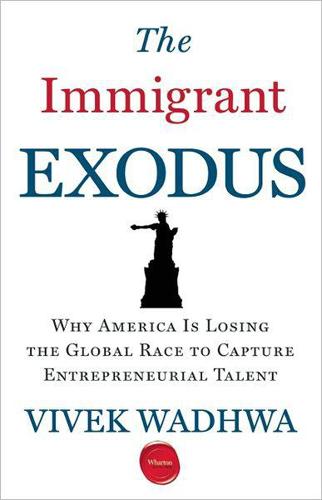
The Immigrant Exodus: Why America Is Losing the Global Race to Capture Entrepreneurial Talent
by
Vivek Wadhwa
Published 1 Oct 2012
Funding distant wars of dubious value to the tune of trillions of dollars is more important. Fundamental yet simple immigration changes that could create a better future for our children and our nation, however, aren’t really worth the trouble and the time, despite there being a strong consensus in Washington, DC, that immigration reform is vital to American competitiveness around the globe. In the political equation, immigration reform is a third-rail issue. A few legislators have introduced bills and pushed hard, but the paucity of results speaks far louder than the press releases or the good intentions of a vocal minority. The skilled immigrants, for their part, have no real voice or influence in the process that controls both them and the destiny of the US economy.
…
The communities of their ethnic peers in America, likewise, do not wield significant political clout and do not represent a unified voting bloc. The only advocates for skilled immigrants of any real influence, the large US multinationals that hire H-1Bs and the US Chamber of Commerce, have not made immigration reform a defining issue or a top priority. The only people who care enough to shout from the rooftops are venture capitalists and those interested in maintaining the United States as the leading incubator for startups—people like venture capitalist Brad Feld, LinkedIn founder Reid Hoffman, Netscape co-founder Marc Andreessen, and Google chairman Eric Schmidt.

The Second Machine Age: Work, Progress, and Prosperity in a Time of Brilliant Technologies
by
Erik Brynjolfsson
and
Andrew McAfee
Published 20 Jan 2014
John Maynard Keynes, The General Theory of Employment, Interest, and Money, October 21, 2012, http://ebooks.adelaide.edu.au/k/keynes/john_maynard/k44g/. 27. Peter B. Dixon and Maureen T. Rimmer, “Restriction or Legalization? Measuring the Economic Benefits of Immigration Reform,” Cato Institute, August 13, 2009, http://www.cato.org/publications/trade-policy-analysis/restriction-or-legalization-measuring-economic-benefits-immigration-reform (accessed December 14, 2012); Robert Lynch and Patrick Oakford, “The Economic Effects of Granting Legal Status and Citizenship to Undocumented Immigrants,” Center for American Progress, March 20, 2013, http://www.americanprogress.org/issues/immigration/report/2013/03/20/57351/the-economic-effects-of-granting-legal-status-and-citizenship-to-undocumented-immigrants/ (accessed August 12, 2013). 28.
…
We’re making our argument for infrastructure investment because of these externalities, independent of any Keynesian stimulus it might provide, and we’re squarely in the economic mainstream when we do so. WELCOME THE WORLD’S TALENT Any policy shift advocated by both the libertarian Cato Institute and the progressive Center for American Progress can truly be said to have diverse support.27 Such is the case for immigration reform, a range of proposed changes with the broad goal of increasing the numbers of legal foreign-born workers and citizens in the United States. Generous immigration policies really are part of the Econ 101 playbook; there is wide agreement among economists that they benefit not only the immigrants themselves but also the economy of the country they move to.
…
Foreign-born people make up less than 13 percent of the country’s population in recent years, but between 1995 and 2005 more than 25 percent of all new engineering and technology companies had at least one immigrant cofounder, according to research by Wadhwa, Saxenian, and their colleagues.32 These companies in total had more than $52 billion in 2005 sales, and employed almost 450,000 people. According to immigration reform advocacy group Partnership for a New American Economy, between 1990 and 2005, 25 percent of America’s highest-growth companies were founded by foreign-born entrepreneurs.33 As economist Michael Kremer demonstrated in a now classic paper, increasing the number of immigrant engineers actually leads to higher, not lower, wages for native-born engineers because immigrants help creative ecosystems flourish.34 It’s no wonder that wages are higher for good software designers in Silicon Valley, where they are surrounded by others with similar and generally complementary skills, rather than in more isolated parts of the world.

This America: The Case for the Nation
by
Jill Lepore
Published 27 May 2019
-Mexico border became more militarized, and more dangerous, with Operation Blockade in Texas in 1993 and Operation Gatekeeper in California in 1994. In 1997, the chair of a congressional Commission on Immigration Reform said that immigration “is about who and what we are as a Nation,” a common refrain. Few had answers. But immigration became, increasingly, the issue on which American politics turned. Between 2005 and 2013, at least one person a day on average died trying to cross into the United States from Mexico. The end of the Cold War didn’t kill nationalism. Global trade didn’t kill nationalism. Immigration reform didn’t kill nationalism. The internet didn’t kill nationalism. Instead, arguably, all of these developments only stoked nationalism.
…
Millions of Mexicans continued to cross the border for temporary work but now began to do so without papers and found themselves unable to cross back and forth easily. Between 1965 and 1986, an estimated twenty-eight million Mexicans arrived in the United States without papers, belonging, as many said, “ni de aquí ni de allá”—from neither here nor there. A 1986 Immigration Reform and Control Act opened a path to citizenship for many undocumented immigrants but also made going back and forth across the border without papers even more difficult, leaving millions of undocumented immigrants who by now had formed families all but trapped in the United States, which they came to call the jaula de oro, the Cage of Gold.

Border and Rule: Global Migration, Capitalism, and the Rise of Racist Nationalism
by
Harsha Walia
Published 9 Feb 2021
Torelli, “Climate-Driven Migration in Africa,” European Council on Foreign Relations, December 20, 2017, www.ecfr.eu/article/commentary_climate_driven_migration_in_africa; Food and Agriculture Organization of the United Nations, “The Magnitude of the Problem,” www.fao.org/3/X5318E/x5318e02.htm; Robert Muggah and José Luengo Cabrera, “The Sahel Is Engulfed by Violence,” World Economic Forum, January 23, 2019, www.weforum.org/agenda/2019/01/all-the-warning-signs-are-showing-in-the-sahel-we-must-act-now/. 79.Tim McDonnell, “The Refugees the World Barely Pays Attention To,” NPR, June 20, 2018, www.npr.org/sections/goatsandsoda/2018/06/20/621782275/the-refugees-that-the-world-barely-pays-attention-to. 80.Ioane Teitiota quoted in Tim McDonald, “The Man Who Would Be the First Climate Change Refugee,” BBC News, November 5, 2015, www.bbc.com/news/world-asia-34674374. Chapter 4 1.Perla Trevizo, “Tribes Seek to Join Immigration Reform Debate,” Arizona Daily Star, June 14, 2013, https://tucson.com/news/local/border/tribes-seek-to-join-immigration-reform-debate/article_d4fe1980-46d4-5e90-b690-ce78c5453bf1.html. 2.Michael Dear, Why Walls Won’t Work: Repairing the US–Mexico Divide (New York: Oxford University Press, 2013), 158. 3.Will Parish, “The U.S. Border Patrol and an Israeli Military Contractor Are Putting a Native American Reservation Under ‘Persistent Surveillance,’” The Intercept, August 25, 2019, https://theintercept.com/2019/08/25/border-patrol-israel-elbit-surveillance/; Todd Miller, “How Border Patrol Occupied the Tohono O’odham Nation,” In These Times, June 12, 2019, https://inthesetimes.com/article/21903/us-mexico-border-surveillance-tohono-oodham-nation-border-patrol. 4.
…
By 2014, Black people represented one-third of the prison population and were five times more likely to be incarcerated than white people.14 Women also made up an increasing share of drug-related incarcerations. Victoria Law reports that the gendered and racialized retreat of the welfare state alongside the criminalization of nonviolent offenses led to a 2,800 percent increase in the number of female prisoners, especially Black women, between 1970 and 2001.15 Provisions in both Reagan’s Immigration Reform and Control Act of 1986 and the Anti–Drug Abuse Act of the same year targeted racialized immigrants through the creation of a new category of “aggravated felony” for noncitizens, including legal permanent residents. In the aftermath of these laws, the deportations of people with criminal convictions increased 1,300 percent.16 Reagan fused the vocabulary of the war on drugs, especially with respect to narco-trafficking, with his unabashed anticommunism to usher in a brutally violent period of counterinsurgency in Central America.
…
Rhetoric of “productive” and “legal” immigrants with the simultaneous demonization of “criminal” and “illegal” immigrants became the cornerstone of the Democratic Party’s immigration platform for the next two decades. Building on Reagan’s legislation, Clinton passed the Antiterrorism and Effective Death Penalty Act of 1996 and the Illegal Immigration Reform and Immigrant Responsibility Act of the same year. These acts expanded the category of aggravated felony convictions and widened the net for detention and deportation of legal permanent residents with minor convictions stemming from stop-and-frisk policing and the war on drugs. The laws also implemented expedited removal (fast-tracked deportation proceedings with limited judicial oversight), imposed criminal penalties for unauthorized entry and reentry, and made detention and deportation retroactively mandatory for certain criminal convictions.70 Within six years, detentions tripled, with the number of female detainees quadrupling.71 Deportations shot up by 37 percent after the passage of these laws, averaging 150,000 annually.72 Tanya Maria Golash-Boza argues that mass deportation, normalized since the passage of these 1996 laws, is a form of racial governance enforced through expulsion of surplus labor.73 The convergence of “tough on crime” and “tough on immigration” sustains racialized control, while also ensuring a compliant labor force through the containment of surplus labor that exists alongside the outsourcing of maquiladora labor and the insourcing of migrant labor.
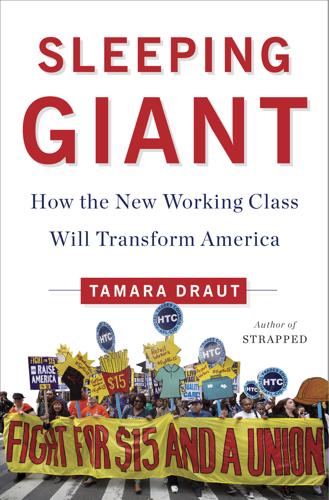
Sleeping Giant: How the New Working Class Will Transform America
by
Tamara Draut
Published 4 Apr 2016
In an investigative report on the corporate-driven campaign to kill EFCA, Ken Silverstein of Harper’s Magazine shared a quote from Glenn Spencer of the Chamber of Commerce about Obama’s position on the issue: “The administration is working on a lot of serious issues, the kind of things that make a legacy—health care, the economy, immigration reform. This is just a distraction. It will split the Senate right down the middle, and you still may not win. [Obama’s] not going to ignore the unions. But will he sink a lot of political capital into a radioactive issue like this? I don’t think so. Congress has noted the lack of engagement. They know what his priorities are.”4 The new compromise version of EFCA, without card check, had a chance of passing the Senate.
…
Violent attacks on antiwar activists by union-card-carrying hard hats—white men all—further eviscerated the prospects of solidarity within these diverging groups of Democratic voters. Adding to the out-of-touch positions of labor, the AFL-CIO maintained an intractable opposition to immigrants and immigration reform until 2000. This battle for the heart and soul of the Democratic Party occurred at precisely the same time that organized business was ascending in power, and unions were inexorably caught in a downward spiral. As America entered the 1980s, this was the context for the shifting allegiances of the working class and the political direction of the Democratic Party.
…
“They” are stealing our jobs, pushing down our wages, straining our schools, and bringing crime to our neighborhoods. In 2015, Donald Trump became the Republican front-runner during the primary season by developing an incendiary anti-immigrant platform, with widespread deportation as his central plank. Even President Obama, who has been a vocal and ardent supporter of comprehensive immigration reform, has succumbed to the political pressure to increase deportations. In fact, more immigrants have been deported under his administration than during George W. Bush’s presidency. Beginning in the mid-1990s, migration of Mexican workers to the United States picked up dramatically. Between 1990 and 2000, the population of Mexican-born people living in the United States doubled, from 4.5 million to 9 million, then grew a bit slower in the new century, to 12.7 million in 2008.
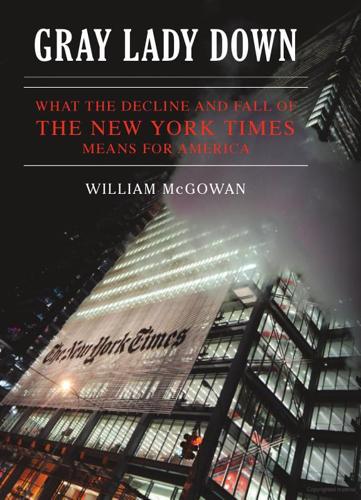
Gray Lady Down: What the Decline and Fall of the New York Times Means for America
by
William McGowan
Published 16 Nov 2010
A New York Times editorial from 1982, “Immigration and Purity,” articulated a realist view of the subject, saying: “Unlimited immigration was a need, and a glory, of the undeveloped American past. Yet no one believes America can still support it. We must choose how many people to admit, and which ones. That can be done only if we can control the borders.” By 2004, when a new push began for tough, enforcement-driven immigration reform, the Times had changed its perspective markedly. When the Comprehensive Immigration Reform Act of 2006 was introduced in Congress, the Times showed its bias by failing to report the bill’s various “hidden bombs,” as one critic called them. For example, it would have replaced the entire immigration bench with activists, since it required that lawyers proposed for immigration judgeships have at least five years practicing immigration law and that existing judges give up lifetime spots on the bench after seven years.
…
A report filed by Robert Pear and David Herszenhorn was headlined “Obama Hails Vote on Health Care as Answering ‘the Call of History.’” The editorial page was effusive too. “Barack Obama put his presidency on the line for an accomplishment of historic proportions,” read “Health Care Reform, at Last.” Obama’s initial steps toward immigration reform in June 2010 also stirred the Times, which opined that “President Obama’s first major speech on immigration had the eloquence and clarity we have come to expect when he engages a wrenching national debate.” In a dig at the majority of Americans who want border enforcement before any legalization of the undocumented, the editorial pronounced Obama correct in maintaining that “sealing off that vast space [the border] with troops and fences alone is a fantasy.”
…
Although the editorial page called for civil discourse, it hardly practiced what it preached, instead issuing juvenile insults far more frequently than dependable insights. Even as it denounced the “demagoguery” of the opposition, it practiced its own form. Conservatives who were concerned about enforcement first were said to hold a view of immigration reform that was equivalent to “pest control.” Editorialists illogically likened opposing amnesty to favoring segregation. Other editorials indulged in victimology that sounded like self-parody: Hispanics are the new gays; Hispanics are the new Willy Horton; sending them home is immoral and a human rights violation.

Rules for Revolutionaries: How Big Organizing Can Change Everything
by
Becky Bond
and
Zack Exley
Published 9 Nov 2016
Bernie Sanders called for them, and he almost won the presidential primary. Our problems are big, so our solutions must be big as well. To achieve them we need a new kind of organizing, and that is big organizing. Big organizing rarely works around a single issue. Our struggles are all connected. We can’t achieve universal health care until we have immigration reform. We can’t fix income equality until we deal with structural racism and the historical legacy of slavery. We can’t resolve national and global security issues or reach full employment without working as hard as possible to stop climate change. Big organizing also needs to have a clear and credible theory of change that explains why organizing matters.
…
RULE 13 If There Are No Nurses, I Don’t Want to Be Part of Your Revolution • becky • Nursing as a profession is based on the values of caring, compassion, and community, and nurses are powerful allies who will attract countless others to your cause. They possess a down-to-earth professionalism that is sincere and authentic, and they have firsthand knowledge of the life-or-death stakes of the most urgent issues of the day, from income inequality to immigration reform to climate change. I’m serious when I say that if there are no nurses, I don’t want to be part of your revolution. In poll after poll, nursing is named by Americans as the most-trusted profession. No other profession is even close. Meanwhile, there’s a four-way tie for the least-trusted professions: lobbyists, members of Congress, telemarketers, and car salespeople.
…
Cesar explained to me that too often campaigns going after the Latino vote thought the only thing they had to talk to Latino audiences about was immigration policy. But in reality, a lot of the families he talked with on the campaign trail cared most about universal health care and free public college. They were also concerned about climate change. Yes, they cared deeply about immigration reform, but Latino families shouldn’t be treated as single-issue voters. They were facing the same challenges as the majority of Americans, and of course, all of our struggles are connected. I heard the same thing from students. Hannah Fertig was a cofounder of Buffs for Bernie, a student group at the University of Colorado Boulder.

Spoiled Brats: Short Stories
by
Simon Rich
Published 14 Oct 2014
I have read books before—a red one and also two blue ones—so I know a little bit about it. But Claire’s books are much larger, with hard covers and pages filled with numbers. “She’s getting a PhD in sociology,” Simon explains when I ask him about it. “Over at Columbia.” “What does she read so much about?” “Something with immigration reform, I think? To be honest, I kind of tune out when she starts blabbing about it. It’s a pretty boring thing to study.” This comment is strange, I think, coming from man who studied English in college—a language he already spoke. But I say nothing. One afternoon, I am mending shirt in living room when Claire enters, wearing pack on back.
…
I find the least disgusting chair and draw it out for Claire. “So,” I say, “tell me, how was the exam?” “It was really hard,” she says. “On the last essay, with five minutes left, I realized I’d forgotten to mention the Perkins Report.” “What is Perkins Report?” “It’s, like, the statistical backbone of immigration-reform theory. Somehow I’d forgotten to incorporate it.” “That’s awesome,” Simon says. We swivel toward him. He is facing the bar, his pupils darting back and forth in obvious search for celebrities. “That’s awesome,” he says again. “Hey—who wants a Manhattan?” “I’ll just have a beer, please,” Claire says.
…
But interning for Herschel has shown me that you don’t have to sell out to succeed.” According to Claire Whitman, the company’s chief spokeswoman, pickles are only the beginning. Sarah’s Statue of Liberty Garlic Pickles with Salt Pickle Company intends to open a political action center in Williamsburg, with a focus on immigration reform. And an art zine is being planned in collaboration with the Vortex Factory, the profits of which will be donated to worthy causes. When I asked Herschel about these developments, he responded with the pithy poeticism that has made him such a cultural icon in Williamsburg. “Everyone must return jar.
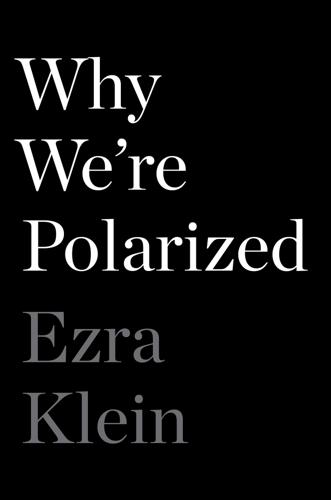
Why We're Polarized
by
Ezra Klein
Published 28 Jan 2020
That would be unthinkable in today’s Republican Party, where almost every elected official has signed a pledge promising to never raise taxes under any circumstances. Bush also signed the Americans with Disabilities Act into law and oversaw a cap-and-trade program to reduce the pollutants behind acid rain. Reagan, for his part, signed an immigration reform bill that today’s Democrats venerate and today’s Republicans denounce. “I believe in the idea of amnesty for those who have put down roots and who have lived here even though sometime back they may have entered illegally,”19 Reagan said. Yes, Reagan said that. President Bill Clinton, meanwhile, launched his administration with a budget designed to reduce the deficit and an all-out effort to pass the North American Free Trade Agreement (NAFTA).
…
In the last election, Governor Romney received just 27 percent of the Hispanic vote. Other minority communities, including Asian and Pacific Islander Americans, also view the Party as unwelcoming. President Bush got 44 percent of the Asian vote in 2004; our presidential nominee received only 26 percent in 2012. The report went on to recommend embracing comprehensive immigration reform, elevating Hispanic leaders inside the Republican Party, and being “inclusive and welcoming” in both “fact and deed.” Otherwise, it warned, “our Party’s appeal will continue to shrink to its core constituencies only.” But there were dissenting voices. The political analyst Sean Trende wrote an influential analysis of the results in Real Clear Politics, arguing that “almost 7 million fewer whites voted in 2012 than in 2008.”24 It was mobilizing these “missing white voters,” Trende said, that offered Republicans a quicker path back to power.
…
“Ending systemic racism requires contributions from all of us, especially those of us who haven’t experienced it ourselves,” Clinton said, becoming the first major-party candidate to use the term “systemic racism” in a speech. Where Obama made a point of increasing deportations in his first term in office as part of a bid to win moderates over to immigration reform, Clinton promised not to deport any undocumented immigrants save for violent criminals or terrorists, a position well to Obama’s left. It’s to cast no judgment on either side to say that the choice between the party of Hillary Clinton and the party of Donald Trump is sharper than the choice between the parties of Bill Clinton and George H.
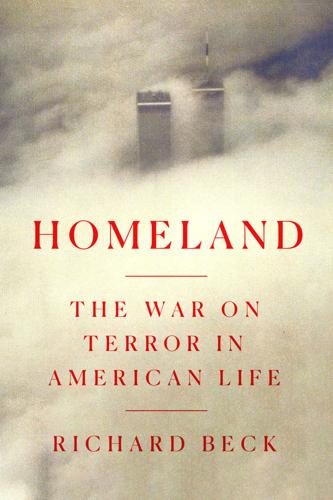
Homeland: The War on Terror in American Life
by
Richard Beck
Published 2 Sep 2024
Major labor unions, Democrats, and self-identified “compassionate conservatives” might have disagreed on the details of the legislation, but all agreed that immigration reform was achievable in one form or another. “The entire political climate seems in hindsight almost unrecognizable,” as Daniel Denvir writes in his book on American nativism. “States like Utah, North Carolina, and Tennessee were issuing driver’s licenses to undocumented immigrants.”[19] This sense of openness and possibility surrounding immigration reform had vanished by the morning of September 12. Among the many painful bits of news to absorb over the following months were two reports that helped to revive immigration as a live issue on a national scale.
…
BACK TO NOTE REFERENCE 51 Scott Shane, “Killings in Norway Spotlight Anti-Muslim Thought in U.S.,” New York Times, July 24, 2011, www.nytimes.com/2011/07/25/us/25debate.html. BACK TO NOTE REFERENCE 52 “Remarks by the President on Comprehensive Immigration Reform in El Paso, Texas,” White House, Office of the Press Secretary, May 10, 2011, obamawhitehouse.archives.gov/the-press-office/2011/05/10/remarks-president-comprehensive-immigration-reform-el-paso-texas. BACK TO NOTE REFERENCE 53 Paik, Bans, Walls, Raids, Sanctuary, 95–98. BACK TO NOTE REFERENCE 54 Gardiner Harris, David E. Sanger, and David M.
…
Eight years later, as Obama ceded the presidency to a man who’d first come to political prominence by promoting conspiracy theories about whether Obama was a natural-born citizen, it would lie in tatters. Obama was wrong about the centrality of racism to American political life. With respect to domestic policy, he was wrong in believing that Republicans would accept the legitimacy of his presidency or cooperate even a little with the implementation of his agenda (e.g., health-care and immigration reform) in exchange for policy concessions, no matter how generous. And with respect to foreign policy, he was wrong in thinking that his administration could continue to fight the war on terror without exacerbating the very racism that made implementing his domestic agenda so difficult. Obama’s misreading of the situation on these two fronts, his belief that America’s racism could be ignored or evaded rather than confronted, would turn out to be the central tragedy of his presidency.

The Great Wave: The Era of Radical Disruption and the Rise of the Outsider
by
Michiko Kakutani
Published 20 Feb 2024
GO TO NOTE REFERENCE IN TEXT “official shoes of white people”: Katie Mettler, “We Live in Crazy Times: Neo-Nazis Have Declared New Balance the ‘Official Shoes of White People,’ ” The Washington Post, Nov. 15, 2016, washingtonpost.com/news/morning-mix/wp/2016/11/15/the-crazy-reason-neo-nazis-have-declared-new-balance-the-official-shoes-of-white-people/; Ben Popken, “New Balance Rebukes White Supremacists for Adopting Its Sneakers as Hate Symbol,” NBC News, Nov. 16, 2016, nbcnews.com/business/consumer/new-balance-rebukes-white-supremacists-adopting-its-sneakers-hate-symbol-n684776; Cam Wolf, “New Balance, Under Armour, and the Year That Sneakers Got Political,” GQ, Dec. 22, 2017, gq.com/story/new-balance-sneakers-politics-2017. GO TO NOTE REFERENCE IN TEXT a comprehensive immigration reform bill: Dan Berman, “Roll Call: Republicans Who Voted for the Bill,” Politico, June 27, 2013, politico.com/story/2013/06/immigration-roll-call-vote-093531; Christopher Parker, “The (Real) Reason Why the House Won’t Pass Comprehensive Immigration Reform,” Brookings, Aug. 4, 2014, brookings.edu/blog/fixgov/2014/08/04/the-real-reason-why-the-house-wont-pass-comprehensive-immigration-reform/. GO TO NOTE REFERENCE IN TEXT A 2021 Gallup poll: Jeffrey M. Jones, “Democratic, Republican Confidence in Science Diverges,” Gallup, July 16, 2021, news.gallup.com/poll/352397/democratic-republican-confidence-science-diverges.aspx.
…
Because we have short memories and because the Trump-era GOP has mutated so dramatically, it’s difficult to remember those not-so-distant days when people complained that the choice between the presidential candidates George H. W. Bush and Bill Clinton was basically a choice between Coke and Pepsi, or those days when fourteen Republican senators (including John McCain, Marco Rubio, and Lindsey Graham) joined Democrats to pass a comprehensive immigration reform bill, 68–32 (the bill ultimately failed in the House). Today, the two parties have so diverged that they can’t even agree upon the usefulness of science. A 2021 Gallup poll showed that while 79 percent of Democrats expressed “a great deal” or “quite a lot” of confidence in science, only 45 percent of Republicans did (an astonishing drop of twenty-seven points since 1975 when 72 percent did)

We Are All Fast-Food Workers Now: The Global Uprising Against Poverty Wages
by
Annelise Orleck
Published 27 Feb 2018
Maria Elena Durazo, child of farmworkers turned UNITE HERE organizer, was trained as an organizer by the UFW. Both unions understand that there can be no labor justice without a path to citizenship for all workers, she says. And that will only come when unions register members to vote and fight for immigration reform. “That was true in the early twentieth century,” Durazo says, “and it’s just as true now.”16 Massimo Frattini believes that workers’ transnational networking is equally important in a global economy. He has organized worldwide weeks of action by hotel housekeepers each year since 2014. Workers from Massachusetts to California, from Manila to Buenos Aires, in the Maldives, Addis Ababa, Reykjavík, Oslo, and hundreds of other locales have participated.
…
Parents were being dragged away and taken someplace their children couldn’t find them. That’s why we started fighting. That’s why we won’t stop. I honestly don’t know how much worse it can get.” For Sanders, Rainer, and many others, the living-wage campaign is inextricably tied to the struggle against police violence and for immigration reform. Fight for $15 activists at a McDonald’s in Ferguson, Missouri, provided safe space during the unrest after police killed teenager Michael Brown in the summer of 2014. Living-wage marchers in New York wore shirts emblazoned with the last words of Eric Garner, father of six, killed by the NYPD that summer.
…
Millions more lost farm jobs. Half a million Mexicans a year were soon fleeing to the US. This was double the number who had left each year before NAFTA.3 Fortunately for the Lopez family, Abelardo was one of 2.7 million undocumented workers granted amnesty and a green card under Ronald Reagan’s 1986 Immigration Reform and Control Act (IRCA). That enabled him to bring his family to the US. One by one he brought his sons. Arcenio waited for word from US authorities that it was his turn. It took ten years. A long backlog makes legal entry into the US painfully slow. A decade-long wait is not unusual. But Arcenio Lopez turned twenty-one while he was waiting.
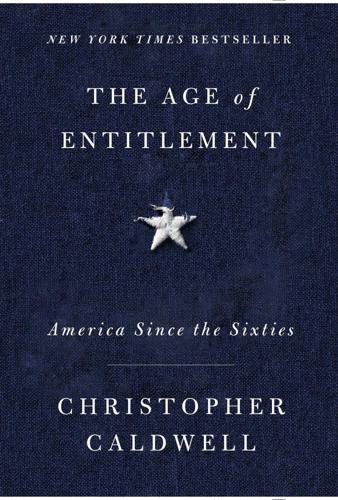
The Age of Entitlement: America Since the Sixties
by
Christopher Caldwell
Published 21 Jan 2020
Reagan was tasked by voters with undoing those post-1960s changes deemed unsustainable. Mass immigration was one of them, and it stands perhaps as his emblematic failure. Reagan flung open the gates to immigration while stirringly proclaiming a determination to slam them shut. Almost all of Reaganism was like that. The Hart-Celler immigration reform of 1965 is sometimes overlooked amid the tidal wave of legislation that flowed through Congress that year. It overturned the “national origins” system, passed under the Immigration Act of 1924 and reaffirmed in 1952, that had aimed to keep the ethnic composition of the United States roughly what it was.
…
In the waning days of the Carter administration, Kennedy proposed a Select Commission on Immigration and Refugee Policy, chose Notre Dame president Father Theodore Hesburgh to head it, and selected the reading materials that would guide it. Two of the Kennedy commission’s members, Republican senator Alan Simpson of Wyoming and Democratic congressman Romano Mazzoli of Kentucky, sponsored the legislation that would become the 1986 Immigration Reform and Control Act (IRCA). Simpson-Mazzoli aimed at a bold compromise. It legalized and offered American citizenship to illegal immigrants who could prove they had been resident in the United States for even the briefest of stays. A Special Agricultural Worker (SAW) program gave permanent residency to workers who could show they had done 60 days of farm work between May 1985 and May 1986, regardless of whether they knew any English or had any understanding of American civics.
…
Kennedy proposed: Edward M. Kennedy, Selected Readings on U.S. Immigration Policy and Law: A Compendium, 96th Congress, 2nd Session (Washington, D.C.: U.S. Government Printing Office, October 1980). A Special Agricultural Worker (SAW) program: Betsy Cooper and Kevin O’Neil, “Lessons from the Immigration Reform and Control Act of 1986,” MPI Policy Brief 3 (August 2005): 4. Simpson-Mazzoli brought with it: Ibid. Cooper and O’Neil called it “the largest expansion of federal regulatory authority since the enactment of the Occupational Safety and Health Act in 1980”—but their date is a typo. In June 1986: Gallup poll, June 19–23, 1986.
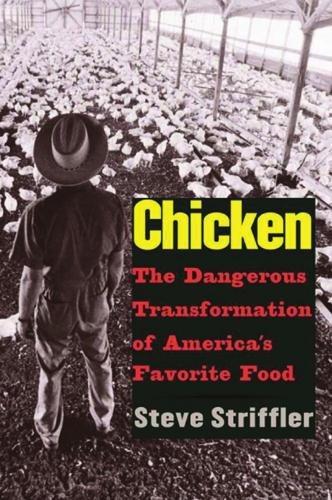
Chicken: The Dangerous Transformation of America's Favorite Food
by
Steve Striffler
Published 24 Jul 2007
I don’t know, maybe the Getting Here 107 INS will pick me up one day, but I don’t think about it. I have almost ten years [in poultry]. Really, there is nothing in Mexico for me. But still, I would like to return.26 Tighter border control, which began in the mid-s, has done little to stop illegal immigration. Between , when the Immigration Reform and Control Act was enacted, and , INS funding increased eightfold and Border Patrol funding sixfold. Yet, the number of illegal immigrants doubled during the same period and is growing by an estimated , a year. What tighter border control did do was make the passage more expensive and more dangerous for immigrants.
…
He has no sympathy for the poultry industry: “If there is a victim here at the moment it’s that young Mexican family that all of the sudden is told by Don Tyson: ‘Come to America. We’ll make you rich.’ Those are damn empty promises.”22 Organized groups such as Project USA and the Federation of American Immigration Reform (FAIR) have fueled these anti-immigration sentiments. In , Project USA erected billboards in eleven states that called immigration a population crisis and cultural problem.23 In some places throughout the United States, antiimmigrant sentiment has come from working people who feel their jobs are being threatened by or lost to immigrants.
…
They need to get paid in a way that is not only transparent, but also reflects the massive investments Toward a Friendlier Chicken 167 they make in the industry. They also need to operate without fear of retaliation from integrators. Workers, regardless of where they are born, must labor under safe conditions, get paid a living wage, and not fear their employers. This will require serious immigration reform. The government—pushed by consumers, workers, farmers, environmentalists, and others—has to help create and support a legal and political climate in which workers and farmers can organize. Friendly Chicken It is difficult to be optimistic about an industry in which power is so concentrated, government involvement so one-sided, and abuses so routine and outrageous.
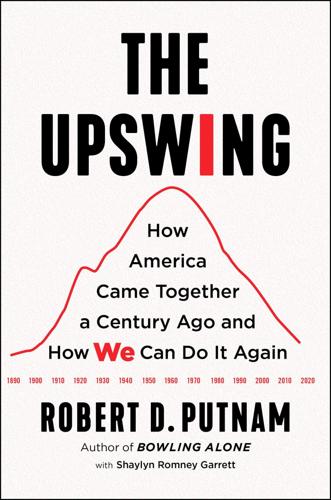
The Upswing: How America Came Together a Century Ago and How We Can Do It Again
by
Robert D. Putnam
Published 12 Oct 2020
But that study added that the linkage works only in the short run.29 In the long run and with proper policies, we argued, social divisions can eventually give way to “more encompassing identities” that create a “new, more capacious sense of ‘we.’ ” Indeed something like that happened in the United States during the four decades between 1924, when immigration was shut off, and 1965, when immigration reform reopened America’s door.30 During the long upswing of the I-we-I curve Americans became increasingly comfortable with ethnic diversity and increasingly open to immigration reform. It is no accident that the bipartisan Immigration and Nationality Act of 1965 was passed by Congress at precisely the peak of the I-we-I curve. At the time of the law’s passage, fully 70 percent of Americans across party lines favored it.31 Far from immigration preventing a rise in social and cultural solidarity, the opposite seems equally likely: The greater the solidarity of a society, the more open it becomes to immigration and diversity.
…
Buoyed by his landslide victory in 1964, LBJ moved to the left on issues of race and inequality, beginning to open an ideological divide that would widen steadily for the next half century. Nevertheless, across LBJ’s far-reaching Great Society initiatives (the War on Poverty, Civil Rights, Voting Rights, Medicare/Medicaid, federal aid to education, and immigration reform—the very issues at the core of intense party polarization in our own period, a half century later), all major bills were supported by majorities or substantial minorities within both parties. On average, these bills were supported by 74 percent of congressional Democrats and 63 percent of congressional Republicans, a fact forgotten by later Republicans who would rail against the leftist extremism of the Great Society programs.38 Behind the scenes LBJ cooperated with Senator Everett Dirksen, the titular head of congressional Republicans, just as he himself had done with Ike a decade earlier.
…
But the areas of agreement among historians of the Sixties are equally important.35 Almost all historians agree that a major historical turning point took place between roughly 1968 and 1974—a “revolution,” a “renaissance,” a “fracture,” a “shock wave,” a point after which “everything changed,” creating a “new America.”36 Maurice Isserman and Michael Kazin, for example, argue that the Sixties ushered in a moment of historical rupture on the scale of the American Civil War, dividing the twentieth century into a pre- and post-Sixties world, a change from which “there is no going back, any more than the lost world of the antebellum South could have been restored after 1865.”37 Most historians also agree on an important distinction between the first half of the 1960s and the second half—“years of hope” and “days of rage,” as Todd Gitlin famously put it.38 Widely shared prosperity, the Civil Rights movement (culminating in the 1964 Civil Rights Act and the 1965 Voting Rights Act), and progress toward equality, democracy, and tolerance (symbolized by the Great Society of 1964–1965 and the immigration reform of 1965) represented the “years of hope.” By contrast, the Vietnam war protests (1966–1970), urban unrest (1965–1969), the rise of the Black Panthers (1966–1968), the “law and order” counterattack (1968–1972), the convulsions of 1968, and the stagflation and rancorous gas lines of the 1970s represented “days of rage.”
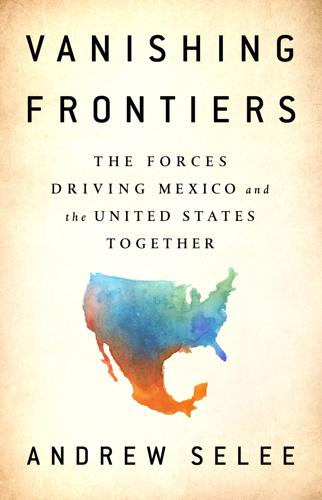
Vanishing Frontiers: The Forces Driving Mexico and the United States Together
by
Andrew Selee
Published 4 Jun 2018
See specific officials, agencies, and issues Gruma, 85, 90 Grupo Alfa, 85, 113–115, 116, 130 Grupo Electra, 77 Guadalajara, Mexico cost of living, 100 expatriates in, 206 innovation culture in, 104–107 manufacturing in, 98, 103 reinvention of, 98–99 technology innovation in, 23, 95, 97, 98–100, 101–102, 103–104, 107, 272 Guerrero, Vicente, 210 Guerrero violence, 19, 180 guest worker program, 36, 39 Guillén, Tonatiuh, 43 Gulf Cartel, 137, 138, 172, 176 gun sales/smuggling, 143, 150, 176 Gutiérrez, José Luis, 219–220, 221 Gutiérrez, Mak, 105 Gutiérrez, Raúl, 73, 74, 75, 86 Guzmán, “Chapo,” 137, 166, 176–177 Ha*Ash, 218, 219 Hackers/Founders, 105 Hadley, Steven, 148 Hayek, Salma, 227, 232, 236, 242, 253 Hazelton, Pennsylvania affiliation with, 7–8 crime in, 10–11 decline of, 8 demographics of, changes in, 9, 12–13, 187 employment in, 8, 9 ethnic history of, 2 immigration and, 1, 2–3, 4, 8, 185, 187 investment in, and nearby communities, 4–5, 9, 14, 76, 84, 85, 89 as a microcosm of US-Mexico relations, 20–21 migrant journey to, from Atzompa, 15–16 population in, 8, 9 public-private partnerships in, 14 restriction of immigration in, 2, 9 revitalization of, 8–9, 13–14, 21, 185, 201 start-ups in, expansion of, 9–10, 185 unifying, attempts at, 11–12, 14 voters in, and national elections, 21 Hazelton Integration Project (HIP), 11–12, 14 health care accessibility of, 18, 66, 205, 206 affordability of, 205 improvement in, 66 investment in, 189, 191 provision of, 204–205 quality of, 205 health-care technology, 103 heavy manufacturing, 63 Heineken, 86–87 Hernández, Roberto, 158–159, 159–160, 161–162, 163, 243 heroin, 19, 74, 137, 143, 158, 178–179, 180 Hewlett Foundation, 160, 162 Hewlett-Packard (HP), 95, 98, 99 high-tech industries attracting, 13–14 pairing low-tech and, 96 supply chains for, 30 See also technology sector hockey leagues, 248 holiday celebrations, 194 Hollywood production/studios, 6, 23, 39, 226, 228, 230, 231–232, 233, 235, 237, 238, 243 home cooking, ethnic, becoming mainstream, 260, 262 Homeland Security, Department of, 45, 134, 269 homicides immigration backlash and, 10, 11 organized crime and, 19, 31, 136, 138, 139, 142, 150, 165, 166, 168, 172, 177, 180 overall rate of, 19, 138, 150, 177, 178, 179 hospitality industry, 185 How to Be a Latin Lover (film), 227 Hughes, Langston, 208–209 Human Development Report, 241 Hunt, Hunter, 125, 127 Hunt Consolidated Energy, 125, 127 Hurricane Katrina assistance, 133–135, 141, 150, 151, 171 hydropower, 123, 126 IBM, 95, 98, 99 IEnova, 120, 122, 124 illegal drugs, demand for, 19, 21, 143, 149–150, 176, 178, 180, 274 See also drug addiction/overdoses; drug trade/trafficking illegal immigration amnesty for, 265 and the border wall, 22 concerns over, 186, 190 crackdown on, 269 decline in, 3–4, 186, 190, 191, 282 deterring, common goal of, 200 documentation issues facing, 193 new flows of, first line of defense in, 199–200 protest against, 2 Imcine, 228, 229 immigrant roots, 209, 210 immigration backlash against, 2, 10, 11 decline in, 3, 20, 187, 190–191, 195, 196, 198, 202, 255 as embedded, 186 fears associated with, 21, 185–186 films involving, 226–227, 228, 230, 232 height of, 190 job loss driving, 63, 190 mass, ending of, 4 new wave of, 1 positive views toward, 22, 186, 283 poverty driving, 2, 15, 189, 198 previous waves of, 9, 13, 186, 188 profound influence of, 282–283 restrictions on, focusing on, 2, 10 shifting face of, 4, 188, 198, 200, 201 and social integration, 186–187 See also illegal immigration; returning migrants immigration debate, 2–3, 4, 22, 188 immigration reform, 147, 265 Immigration Reform and Control Act, 265 imports agricultural, 49–50 border crossing and, 71 natural gas, 119, 124 oil, 124, 131 and tariffs, 36 See also exports; trade incarceration rates, 10 income disparity/inequality, 65, 275, 277 See also poverty income growth, 18, 66, 196, 248 See also economic growth; middle class independent filmmaking, 6, 228, 233, 234, 238, 239, 240, 241–242, 243–244, 254 See also documentary film Independents, 22, 275 India call centers and, 193 emigration from, 4 film industry and, 225, 227 outsourcing IT to, issue with, 94 technology sector in, 98 venture capital and, 107 indigenous roots, 209–210 industrial sector declining employment in, 59, 60, 275 development of, 8–9 shared production in, 58, 282 trade balance in, 51 See also specific industries informal sector, 66 Infosys, 95 infrastructure, 205 innovation culture, 104–107 innovation economy, 21, 23, 30, 39, 67 innovation labs/hubs, 39, 110–111 See also Guadalajara, Mexico; Silicon Valley, California innovation meet-ups, 104, 105–106 institution building, 157, 169, 180 Instructions Not Included (film), 226–227 Intel, 95, 99 intelligence model, 175 International Revolutionary Party (PRI), 114 investment matching, 189–190 as part of overall expansion, 90, 91 portfolio, 76 rise in, 4–5, 9, 74, 75–79, 80–82, 84, 88–89, 270, 271 in San Diego-Tijuana bridge, 28 See also venture capital investment laws, 109–110 investment risk, 111–112 Iraq war, 144, 147, 148 Ireland, emigration from, 2, 9, 13, 186, 197 Italy emigrants from, 1, 2, 8, 9, 13, 33, 39, 43, 186, 197, 260 movie market in, 224 Jalisco New Generation Cartel, 177 Jane the Virgin (TV show), 253 Japan, 5, 28, 47, 50 Jeep, 55, 57 Jesse & Joy, 215–216 Jiménez, Efraín, 188–189, 192, 201 Jinich, Pati, 260 jobs.
…
But as a veteran of congressional and presidential policymaking, Fisk also understood that presidential will was only the beginning. Now came the fight in Congress. Congress was initially skeptical about security cooperation with Mexico. The wars in Iraq and Afghanistan had strained budgets and pitted Democrats against President Bush. And immigration reform legislation, which Bush had supported strongly in both 2006 and 2007, had many Republicans at loggerheads with the White House—another issue they associated with Mexico. Throughout the rest of 2007 and most of 2008, the Merida Initiative would languish on the Hill with little action. Meanwhile, violence in Mexico was starting to make headlines as the trafficking organizations started a series of new mafia wars against each other.
…
He was recruited to be part of the Olympic Development Program but wasn’t selected because he wasn’t yet an American citizen. Kihuen had come to the country with a visa, following his father, a farmworker, but he had overstayed it and spent several years as an unauthorized immigrant. He only legalized his status thanks to the amnesty offered by Ronald Reagan in 1986 as part of the Immigration Reform and Control Act, a deal that brought 3.1 million unauthorized immigrants, a majority of them Mexicans, out of the shadows. It’s “thanks to Ronald Reagan, a Republican, that I’m here in the United States,” says Kihuen, a Democrat. While he didn’t make the US Olympic Team, the owner of one of Mexico’s top teams, Chivas, spotted him and invited him to Guadalajara, the city he’d grown up in as a boy, to try out for the Mexican professional league.
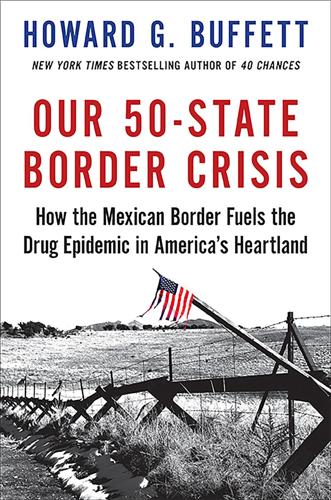
Our 50-State Border Crisis: How the Mexican Border Fuels the Drug Epidemic Across America
by
Howard G. Buffett
Published 2 Apr 2018
We have had a porous border for a long time, and millions of individuals have entered illegally; even more have entered legally but then overstayed their visas and are now living here in violation of immigration rules and are susceptible to deportation. There may be more than 11 million people whose status and fears make them vulnerable to threats and manipulation.12 We can debate how we got here, but this is where we are. Whether or not we attempt a larger, comprehensive immigration reform agenda, regardless of what federal policies are pursued in coming years, the sheer volume and distribution of the undocumented population means the vast majority are going to be here for a very long time. Communities will not be safer if immigrants retreat further into the shadows because predators exploit their fears.
…
Smugglers will shift their tactics from climbing a fence near an urban area to crossing the border on remote, rocky terrain where horseback-mounted teams might be needed. Or a response to political shifts and opportunities may trigger a surge of migrants. That happened in 2014 in Texas. Violence was escalating in Mexico and Central America, and for a brief period there appeared to be growing political support for broad immigration reform. There also were perceptions that unaccompanied minors who turned themselves in after crossing the border would be released to family members.1 Tens of thousands of unaccompanied minors began crossing the Rio Grande, swamping BP’s resources, and it took months to shore up that sector by shifting agents away from other areas that in some cases had high smuggling activity.
…
It’s counterproductive to spend tax dollars to support border security while our personal discretionary funds support the very criminals harming and killing thousands of people on both sides of the border. Labor demand When U.S. employers create an incentive for individuals to cross the border illegally by ignoring labor laws and hiring them “under the table,” they are undermining border security. I think immigration reform must be treated separately from border security, but I do think we have to acknowledge and stop rationalizing this “pull” factor. Breaking the law undermines the rule of law. It’s wrong. As a nation, we have to admit that we have essential work, particularly in agriculture, that we cannot hire sufficient numbers of Americans to perform based on the job requirements and for the amount of money these businesses feel they can pay and still make a profit.
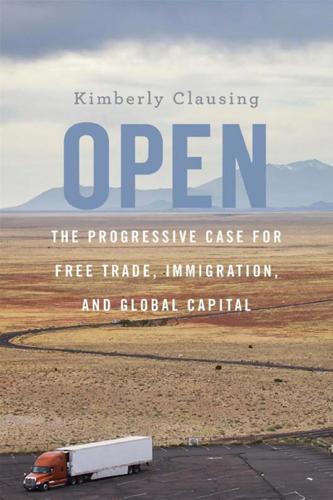
Open: The Progressive Case for Free Trade, Immigration, and Global Capital
by
Kimberly Clausing
Published 4 Mar 2019
About eleven million people, however, reside in the United States who first entered the country illegally or overstayed their visas; this population is a little less than one quarter of all immigrants. Our immigration policy has changed infrequently over the decades. A notable change of priorities occurred in 1965, when a nation-based quota system was repealed in favor of prioritizing family reunification. Two decades later, the 1986 Immigration Reform and Control Act set up a system of employer sanctions for hiring undocomented immigrants, increased resources for border enforcement, and provided amnesty for undocumented immigrants residing in the United States. Since then, changes to our immigration system have been smaller, including changes in visa allotments and the creation of the diversity category of visas in 1990, provisions that made it more difficult for immigrants to access welfare benefits in 1996, and laws that tightened documentation and reporting requirements as well as immigration rights in 2003 and 2005.
…
There are likely more cost-effective ways to discourage undocumented immigration.53 This is especially likely since, in recent years, more undocumented immigrants have overstayed visas than entered without documentation.54 For those undocumented immigrants already in the country, I would suggest providing a path toward citizenship, as suggested by Obama Administration and congressional leaders in prior immigration reform plans such as the DREAM Act. Providing a path to citizenship does not benefit only the undocumented workers; it also benefits the US economy as a whole. Documented workers are likely to pay more in tax revenue than they receive in benefits, helping the federal budget.55 Giving workers legal status also gives them a greater incentive and ability to invest in learning and skill-building, allowing them to contribute more to the economy and reducing wage competition for the lowest-wage workers.
…
See Robert Warren and Donald Kerwin, “The 2,000 Mile Wall in Search of a Purpose: Since 2007 Visa Overstays have Outnumbered Undocumented Border Crossers by a Half Million,” Journal on Migration and Human Security 5:1 (2017), 124-136. 55. Congressional Budget Office, Senate Amendment 1150 to S. 1348, the Comprehensive Immigration Reform Act of 2007, June 4, 2007. 9. Equipping Workers for a Modern Global Economy 1. Of course, countries often have different preferences about the optimal tax rate or level of regulation, and cooperation need not involve harmonization. Cooperation can, however, help countries avoid some of the harmful aspects of tax and regulatory competition. 2.
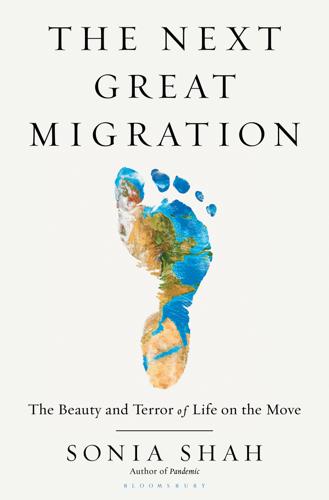
The Next Great Migration: The Beauty and Terror of Life on the Move
by
Sonia Shah
But while the social panic about out-of-control population growth diminished, deflated by demographic shifts and political scandal, the movement to make migration as difficult and deadly as possible not only persisted, it grew. In 1979 the Michigan ophthalmologist John Tanton spun off ZPG’s immigration committee50 into a new group aimed entirely at restricting immigration called the Federation for American Immigration Reform. He and his allies created a slew of associated organizations, all focused on cracking down on the flow of migrants into the country. Within a few years, Tanton’s antimigrant network included the Center for Immigration Studies, an anti-immigration think tank; NumbersUSA, an anti-immigration lobby group; U.S.
…
In the 1980s and ’90s, elements on both sides of the political spectrum aligned both for and against immigration, with corporate interests and their partisan allies broadly aligned in favor of immigration and labor unions and their partisan allies arguing that immigrants drove down wages and had a negative impact on the environment. Garrett Hardin and Anne Ehrlich served on the board of Tanton’s Federation for American Immigration Reform. Like Ehrlich, who primed his readers and viewers to accept the necessity of authoritarian measures, Tanton gently helped his supporters disregard51 those who might call his antimigrant positions “racist.” For too long, he’d tell them, environmentalists had been averse to discussing the truth about immigration because of the “seamy history” of “xenophobia and racism” that surrounded it.
…
The Trump administration tapped people from Tanton’s organizations to oversee immigration policy. The office tasked with helping immigrants whose visas and citizenship applications had been denied or delayed would be overseen by Julie Kirchner, a former executive director of the Federation for American Immigration Reform. The administration’s panel on election integrity would be led by the group’s legal counsel, Kris Kobach. The head of the organization’s polling firm, Kellyanne Conway, would become one of the president’s top advisers. The federation’s director of lobbying, Robert Law, would serve as a senior policy adviser to the Trump administration’s U.S.
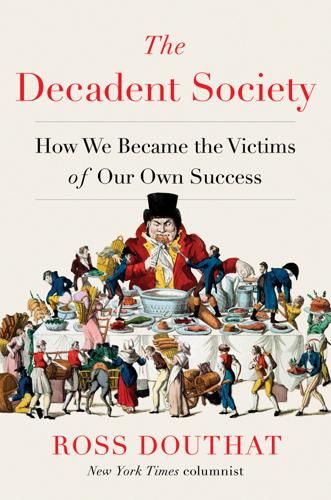
The Decadent Society: How We Became the Victims of Our Own Success
by
Ross Douthat
Published 25 Feb 2020
It was ordinary that after expanding the deficit, defensibly, to fight the recession, Obama would then fail to reach a bipartisan agreement to restrain the long-term growth of debt; after all, no major deal combining spending cuts and tax increases has been reached since 1991, twenty-eight years ago and counting. It was likewise ordinary that there wouldn’t even be a revenue-neutral tax reform (the last one was in 1985), that there would also be no deal on immigration reform (the last one was in 1986), and that after posturing as a critic of presidential unilateralism, Obama would end up claiming novel powers in an effort to make immigration policy on his own. It was normal that he would do the same on health care and climate policy. It was normal that the day-to-day functioning of the federal system depended on government-by-brinksmanship, with debt-ceiling showdowns and fiscal cliffs and government shutdowns necessary preconditions for even modest deals.
…
The Obamacare case study is useful here, not least because it’s a rare example where a meaningful reform, as opposed to just a deficit-funded tax cut or spending boost, did ultimately pass—unlike Clinton’s health care fiasco, or Bush’s doomed Social Security reform effort, or the Trump administration’s Obamacare repeal-and-replace effort, or every attempted immigration reform deal. The opposition to the Obama health care bill was obviously ideological, reflecting a clash between libertarian and social democratic principles. But most Americans aren’t thoroughgoing libertarians; indeed, even most Tea Partiers weren’t thoroughgoing libertarians. The real reason that Obamacare opposition became so fierce, and the debate so toxic, was that the health care system as it exists is as Rauch described government as a whole: a huge sprawl of client populations and powerful interest groups, all of which have a strong financial stake in the existing system, and all of which have spent decades building up the lobbying shops and inner-ring knowledge required to either frustrate or redirect reform.
…
Ron, 231 Huebner, Jonathan, 45 Hungary, 85–86, 164 Huntington, Samuel, 159 Hurrican Maria, 71 Hustler, 119–20 Huxley, Aldous, 127–28, 130, 184–85 Huysmans, Joris-Karl, 156 hyperloops, 37 Identity: The Demand for Dignity and the Politics of Resentment (Fukuyama), 115 identity politics, 115 ideological debates, repetition in, 100–101 “illiberal democracy,” 163–64 immanent divine, 224 immigrants, 64 birthrate of, 50 immigration: economic and social insecurities exacerbated by, 63–64 see also mass migration immigration reform, 70 impeachment hearings, 71 Inca Empire, 189–90 India, economic growth in, 167 inequality, economic, 31–32 declining birthrate and, 57–58 infant mortality rates, 50–51 innovation, 30 decline of, 45, 46 declining birthrate and, 57–58 repetition vs., 9 Instagram, 18 institutions: decadence and, 8–10, 69 technological acceleration and, 213–15 intellectuals, intellectual realm, repetition in, 96–101, 180 interest groups, health care and, 73–74 Intergovernmental Panel on Climate Change, 174 Internet, 40 anonymity on, 144–45 Chinese censoring of, 139 and decline in risky social behavior, 122–23 and declining rates of sexual violence, 121–22 extremist elements of, 194 hive mind and, 106–7 homogenization of, 104–5, 106 illusion of progress fed by, 11 journalism and, 105–6 mediocrity and, 107 NSA and, 146, 147 pornography and, 120–21 productivity and, 41 repetition in, 104–7 right to privacy and, 145, 146–47 as surveillance state, 144–47 unfulfilled promise of, 104–5 Internet economy, 17, 22 consolidation in, 27 Ip, Greg, 167 IPCC, 195 iPhone, 37, 40, 107 IQ scores, Flynn effect and, 35 Iran, Islamic Republic of, 160, 163 Iran nuclear deal, 71 Iraq War, 69, 70, 80, 150 Ireland, 52, 84 Islam, Islamic world, 201, 223 falling birthrates in, 161 modernity and, 227 as path to renaissance, 226–28 Islamic State (ISIS), 70, 113, 148, 152, 160 Islamists, Islamism, 113, 114, 155, 207 as alternative to liberal order, 159–62 Israel: birthrate in, 50, 54, 217 as model for nationalist renaissance, 217–18 Italy, 84, 85 iTunes, 105 Ivanov, Vyacheslav, 7 James, P.
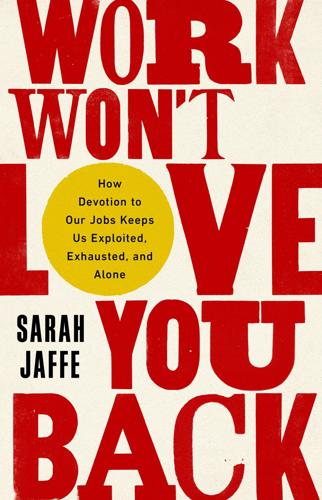
Work Won't Love You Back: How Devotion to Our Jobs Keeps Us Exploited, Exhausted, and Alone
by
Sarah Jaffe
Published 26 Jan 2021
And the remittances they send back home rival oil company revenues in terms of international flows of money. 35 The workers are also vulnerable because of immigration policy. The current migration apparatus in the United States has its roots in the 1990s—it was put together alongside welfare reform, by the same bipartisan coalition. The Antiterrorism and Effective Death Penalty Act and the Illegal Immigration Reform and Immigrant Responsibility Act of 1996 built on the foundation of the Reagan-era Immigration Reform and Control Act, which had allowed three million undocumented migrants to become “legal,” but also heightened enforcement. As the prison system expanded, migrants found themselves criminalized just for existing. 36 It is the very gray area in which many undocumented workers operate that allows the worst employers to take advantage of them, as workers who attempt to escape an abusive boss can be vulnerable to deportation.
…
But for those who are still working in individual relationships, it has been necessary to rethink what organizing could look like. 48 For workers who perform intimate labors, it may be necessary to create what historian Dorothy Sue Cobble called “more intimate unions,” unions that understand the worker in a holistic sense and focus not simply on wages and benefits but on a deeper understanding of the interpersonal relationships that structure the work relation. Such organizations would see it as their job to meet the workers’ needs on many levels—they would organize, for example, around immigration reform, fight deportations, and take their members’ daily experiences of racism and sexism on the job seriously. Legal assistance and training, too, would be an important part of these organizations. Personal service jobs are only growing more common, particularly in deindustrialized nations where less production is now done: they are harder to automate, so far, and the relationships that these workers build with their clients can be sources of power as well as abuse. 49 In the United States in 2010, New York’s Domestic Workers United and its outgrowth, the National Domestic Workers Alliance, won the country’s first Domestic Worker Bill of Rights.
…
Some of the boot camps are out-and-out scams, like one that promises to pay you to learn—and then takes a cut of your salary for the next two years. But all of them will have the effect of making coders more common, and thus making the work less rarefied—and less well remunerated. 37 Mark Zuckerberg also has a plan to bring in lots of short-term workers from overseas. His immigration nonprofit, FWD.us, was created to lobby for immigration reform. That sounded nice in the age of Trump, but Zuckerberg’s main concern was increasing the number of H1-B guestworker visas for skilled workers. H1-B workers are tethered to a particular job; if they quit or get fired, they have to leave the country, which makes them spectacularly compliant as well as cheaper to hire. 38 All of this means that tech workers might have more in common with the industrial workers of midcentury than they might think.
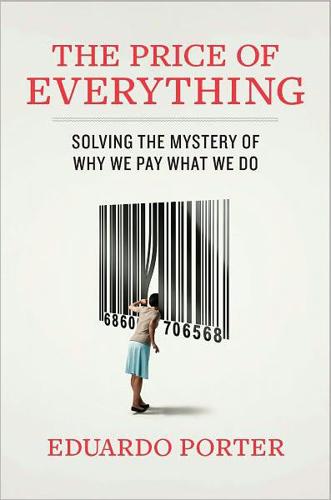
The Price of Everything: And the Hidden Logic of Value
by
Eduardo Porter
Published 4 Jan 2011
Price stability thus suggests that this expected stream did not grow very much. Substitute illegal immigrants for slaves, and similar patterns emerge in the United States today. For decades American farmers have relied on cheap immigrant labor to tend their crops. In 1986, they pressed to pass the Immigration Reform and Control Act, which legalized nearly 3 million illegal immigrants. After that, their investments in laborsaving technology froze. By 1999, capital investments had fallen 46.7 percent from their peak in 1980. Indeed, the institution of immigrant work in the United States may provide an answer to the question about the seeming unpopularity of slavery: it is not as unpopular as it may seem; it has just taken on a different, subtle form.
…
Presentation, Department of Political Science, Miranda House, Delhi University (http://www.undp-povertycentre.org/pressroom/files/ipc126.pdf, accessed 08/13/2010). The analysis of illegal immigration into the United States draws from: Raúl Hinojosa-Ojeda, “Raising the Floor for American Workers: The Economic Benefits of Comprehensive Immigration Reform,” Center for American Progress, January 2010 (http://www.immigrationpolicy.org/special-reports/raising-floor-american-workers. , accessed 08/01/2010); the Mexican Migration Project database (http://mmp.opr.princeton.edu/results/001costs-en.aspx, accessed on 06/30/2010); Maria Jimenez, “Humanitarian Crisis: Migrant Deaths at the U.S.
…
Homeland Security Department, U.S. Hoover, Herbert horse meat House of Representatives, U.S. housing, homes bubble price of HP human papillomavirus Hume, David Hungary hunting I Am Rich Iannaccone, Larry IBM Iceland ideas Illinois illustrators Illy iMacs immigrants illegal Immigration Reform and Control Act (1986) improvement income family happiness and inequality of marriage and national redistribution of tax on technological progress and indentured servants India future of marriage in sex ratios in Indonesia indulgences industrialization inequality income Inevitable Rise and Liberation of Niggy Tardust!
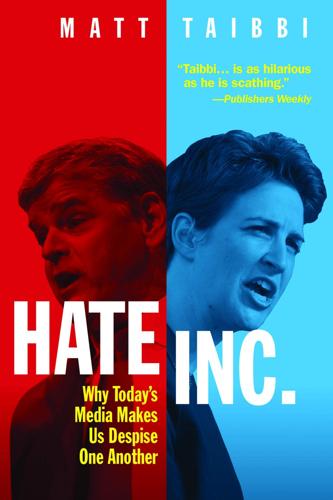
Hate Inc.: Why Today’s Media Makes Us Despise One Another
by
Matt Taibbi
Published 7 Oct 2019
He was wrong and insane, but at least he was “standing out” and not being “passive” (these were other criticisms). And just like that, no joke, the press started to warm to Fred Thompson. He went out on the trail with a “re-invigorated” (read: more aggressive) message. He railed against illegal immigration and said we needed to secure the border before we could have immigration reform. He said we should stay the course in Iraq because those derned terrorists were testing our resolve. By the second time I followed Thompson, the shop talk on the bus was different. I heard things like, “He’s not as dull as I thought” and “people fucking love Law & Order.” His positions were actually a pale preview of Trump, but presentation-wise, everyone was impressed.
…
These ideas may then be batted around in a formal proceeding like the drafting of an electoral “autopsy” or “postelection report.” After 2012, for instance, Republicans were convinced they needed to soften on immigration to close the gap with Democrats. The RNC report on the loss of Mitt Romney laid out a whole series of reforms they thought would be necessary, including, “We must embrace and champion comprehensive immigration reform.” Then the few hundred people who actually matter in Washington will get their heads together and quietly decide which candidate is going to get the money for the next run. That candidate ends up with a few hundred million bucks and a head start with the press. This is how the Times described it in a different piece: The endorsements and donations garner mainly positive media attention for a candidate, and the candidate’s poll numbers then typically increase.
…
The Democratic shows won’t bring on the Muslim or Asian immigrant restaurant owner who comes with nothing but builds a life here through hard work, and as a result resents welfare and business regulation and taxes. That same person won’t appear on the Republican show if he or she is too vociferous about immigrant rights and immigration reform. Gray areas don’t work on these shows. There is us and them and none of the show can be about questioning us. This is why the guest lists are so thick with coiffed professional partisans: either politicians themselves or pundits closely associated with one party or another. They are visions of perfection: perfect hair, facial blemishes makeupped away, with matching certitude in their political positions.
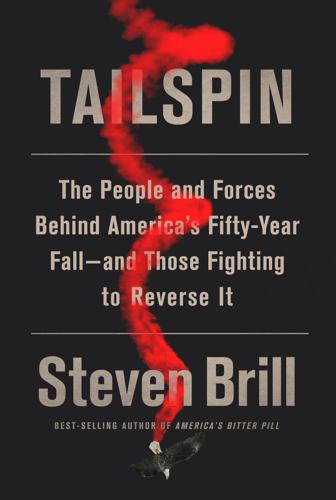
Tailspin: The People and Forces Behind America's Fifty-Year Fall--And Those Fighting to Reverse It
by
Steven Brill
Published 28 May 2018
The days of the country sharing the same set of facts by watching the news unfold on broadcast television were over. It is not surprising that the micro-focused elected leaders who emerged from this new media world could not get together to address runaway health care costs, the decaying infrastructure, immigration reform, working-class job displacement, or the rampant speculation on Wall Street that crashed the economy. As government was disabled from delivering on these vital issues, the protected were able to protect themselves still more. For them, it was all about building their own moats. Their money, their power, their lobbyists, their lawyers, their drive overwhelmed the institutions that were supposed to hold them accountable—government agencies, Congress, the courts.
…
In practice, the Hastert Rule meant that if, for example, the Senate had passed a bill that 45 percent of House Republicans and 80 percent of House Democrats were prepared to vote for, it would still never be considered despite commanding an obvious majority of House votes—a fate that befell a widely supported comprehensive border security and immigration reform law passed with bipartisan support in the Senate in 2013. “With the Hastert Rule, you become speaker of your party, not the country,” said Ray LaHood, a former Republican congressman from Illinois who served as President Obama’s first transportation secretary and was a top aide to Bob Michel, the Republican House minority leader during the Reagan presidency and the first two Clinton years.
…
BPC had an infrastructure plan ready to go, as well as proposals for reforming the federal budgeting process, for streamlining government regulations, and for fixes to NAFTA. “Everyone should agree with them,” Grumet said. “NAFTA is twenty-three years old and stuff like the IP [intellectual property] provisions certainly needs fixing.” The organization had “decisive input over many long days,” Grumet recalled, in shaping the 2013 immigration reform bill that passed the Senate in a bipartisan vote. It is an issue the team had kept working on despite the refusal of the Republican House to consider the bill. “We’re not non-partisan,” Grumet emphasized. “We’re partisans. Non-partisanship is quaint BS. That’s not the world we live in, or will ever live in.
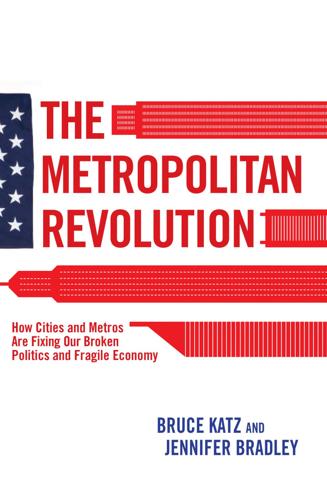
The Metropolitan Revolution: How Cities and Metros Are Fixing Our Broken Politics and Fragile Economy
by
Bruce Katz
and
Jennifer Bradley
Published 10 Jun 2013
With the world undergoing a systemic shift toward sustainable growth (a third industrial revolution) and federal energy and environmental policies under siege, metros like Seattle and Philadelphia are cementing their niches in energy-efficient technologies. And with immigration altering the social fabric of American society and national immigration reform seemingly impossible to achieve, metros like Houston are taking innovative steps to integrate tens of thousands of new immigrants into economic and community life. The metro revolution reflects the maturing of U.S. cities and metros in terms of capacity and focus. Over the past three decades, these communities have innovated on the form of their places, regenerating downtowns, 01-2151-2 ch1.indd 4 5/20/13 6:45 PM A REVOLUTION UNLEASHED 5 revitalizing waterfronts, restoring historic buildings, inspiring grand architecture, expanding transit and transportation choices.
…
For example, Jeffrey Immelt, the chairman 02-2151-2 ch2.indd 19 5/20/13 6:48 PM 20 NYC: INNOVATION AND THE NEXT ECONOMY and CEO of General Electric, told an audience in Detroit in June 2009 that the United States should have three priorities: “become a country that is good at manufacturing and exports,” “win where it counts in clean energy,” and “invest in new technology.”6 Lawrence Summers, the director of the National Economic Council, said one month later, “The rebuilt American Economy must be more export-oriented and less consumption-oriented, more environmentally-oriented and less fossilenergy-oriented, more bio- and software-engineering-oriented and less financial-engineering-oriented.”7 In its meetings with business, civic, and academic leaders, the NYCEDC gleaned more than 100 ideas about how to move the city’s economy forward, covering everything from generating electricity from subway turnstiles to immigration reform to better waterfront access. One of the themes that emerged consistently was that the city and the region needed more—much more—science and technology talent to drive its future. The NYCEDC was getting the same kind of feedback from people involved with its new incubators, investment funds, and related entrepreneurial efforts.
…
In the next half decade, it is highly likely that these state innovations will continue, with funding coming either from specific voter-approved tax increases or bond issues or from cuts in unproductive state spending.41 The federal government has one other critical task. To help metropolitan leaders such as those in Portland and Miami further internationalize the American economy, Congress and the president need to act on immigration reform, favorable trade agreements, and a new openness to foreign investment, including from China. America’s simultaneous diversity and insularity sets us apart from every other nation on earth. Our metropolitan areas have enormous potential to participate in and benefit from the seamless exchange of goods, services, ideas, capital, and people.
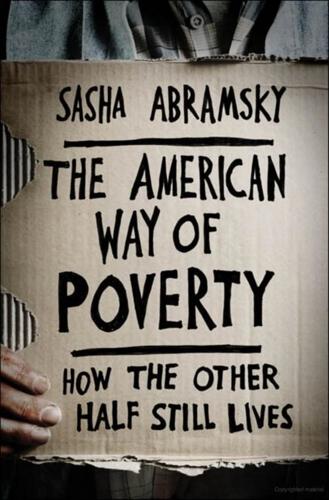
The American Way of Poverty: How the Other Half Still Lives
by
Sasha Abramsky
Published 15 Mar 2013
Like it or not, the reality is that many millions of undocumented migrants consider America to be their home; that no deportation program could possibly deport so many people; and that unless their children are schooled and provided healthcare and other vital assistance, the effects will be felt throughout society over the decades to come. Any meaningful anti-poverty movement will, therefore, have to first convince a majority of Americans that the undocumented ought to be worthy of help; and, second, ensure that immigration reform—through moves such as the DREAM Act—is a core part of its strategy. For whatever one’s theoretical take on immigration—whether one favors a route to legalization, or an emphasis on border control and the deportation of the undocumented; whether one believes that the initial act of illegal entry into the United States renders all subsequent actions moot, or whether one judges the undocumented by how they act and live once in the country—in reality many millions of undocumented residents will likely continue to live in America for the foreseeable future.
…
As mentioned earlier in the book, the presence of millions of such workers in America has made discussions of anti-poverty programs more complicated than was the case during the 1960s, when far fewer undocumented immigrants beat the path to America. Absent a pathway to legality, absent a comprehensive immigration reform being implemented, these workers will continue to exist in the shadows. And, in those shadows, they will continue to be horrendously maltreated. Half a mile south of El Paso’s old, brick-and-stone downtown, Ninth Avenue runs along the railway tracks that abut the Rio Grande. South of the river is Juarez, Mexico.
…
Any systemic push to first significantly reduce poverty, and then to prevent its rapid recurrence, will, of course, have to include many moving parts: local, state, and federal government involvement, including changes in how we raise taxes and how we spend revenues. Attention must be paid to the kinds of debt that we as a society encourage people to accrue, and the sorts of institutions we allow to issue that debt. Additionally, we must consider immigration reform, new energy policies, and changes in the way we use the criminal justice system. Overuse of incarceration is both expensive, and thus a huge drain on limited public resources, and also inimical to the public policy goal of eliminating entrenched poverty. We must look to public-private partnerships as well as nonprofit and philanthropic engagement in arenas such as education, services for the mentally ill, programs available to foster youth as they age out of the foster care system, and the building of affordable housing units.
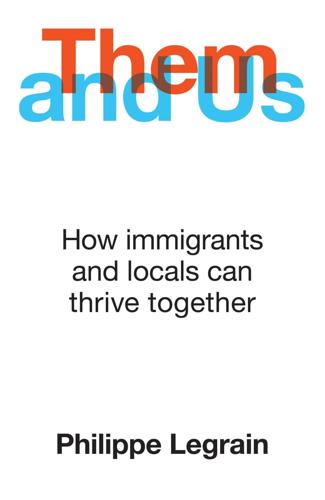
Them and Us: How Immigrants and Locals Can Thrive Together
by
Philippe Legrain
Published 14 Oct 2020
In 2019 he told four non-white Democratic members of Congress (three of whom were born in the US) to ‘go back’.21 Having promised during his election campaign to ban Muslims from entering the US, he suspended entry from seven Muslim countries soon after taking office.22 And on the US-Mexican border, small children claiming asylum have been separated from their parents and locked up in cages, among other inhumane policies. Trump’s behaviour has provoked a popular, legal and political backlash. Protesters have taken to the streets. Judges have ruled against the worst excesses of his policies. And Democrats have rallied to defend immigrants’ rights. Whereas immigration reform was not a priority for Trump’s predecessor as president, Barack Obama – whose administration removed or returned more than five million people23 – candidates for the 2020 Democratic presidential nomination competed to sound more enthusiastically pro-immigration than each other. In France, the run-up to the 2017 presidential election saw conservative hopefuls increasingly echo the anti-immigrant rhetoric of Marine Le Pen, the leader of what was then the Front National.
…
‘We are tired of the abuse, the insults, the way he [Trump] talks about us when he knows that we are here helping him make money,’ she said. ‘We sweat it out to attend to his every need and have to put up with his humiliation.’ After Morales went public to the New York Times in late 2018 she lost her job, along with around twenty other undocumented migrants at the club. She now campaigns for immigration reform. ‘It was a really hard decision,’ she explains. ‘I don’t think people understand how scary it is for us [undocumented immigrants] to talk about it. We live our lives in hiding, always afraid to come out into the light.’ But she is relieved to no longer work for Trump. ‘It’s incredible how bitter we all became.
…
Rumbaut, ‘The Criminalization of Immigration in the United States’, American Immigration Council, 13 July 2015. https://www.americanimmigrationcouncil.org/research/criminalization-immigration-united-states 13 Young men are those aged eighteen to thirty-nine. 14 Michelangelo Landgrave and Alex Nowrasteh, ‘Criminal Immigrants: Their Numbers, Demographics, and Countries of Origin’, Cato Institute Immigration Research and Policy Brief 1, 15 March 2017. https://www.cato.org/publications/immigration-reform-bulletin/criminal-immigrants-their-numbers-demographics-countries 15 Michael T. Light and Ty Miller, ‘Does Undocumented Immigration Increase Violent Crime?’, Criminology, 56:2, May 2018, pp. 370–401. https://onlinelibrary.wiley.com/doi/abs/10.1111/1745-9125.12175 16 Michael T. Light, Ty Miller and BC Kelly, ‘Undocumented Immigration, Drug Problems, and Driving Under the Influence in the United States, 1990–2014’, American Journal of Public Health, 107:9, September 2017, pp. 1448–54. https://www.ncbi.nlm.nih.gov/pubmed/28727520 17 Christian Gunadi, ‘On the association between undocumented immigration and crime in the United States’, Oxford Economic Papers, 2019. https://academic.oup.com/oep/advance-article-abstract/doi/10.1093/oep/gpz057/5572162 18 Jonathan Portes, What Do We Know and What Should We Do About Immigration?
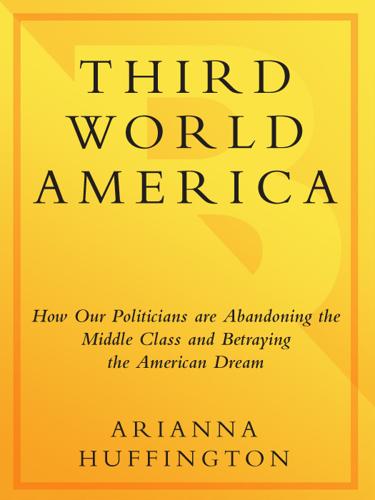
Third World America: How Our Politicians Are Abandoning the Middle Class and Betraying the American Dream
by
Arianna Huffington
Published 7 Sep 2010
And now is the time to reach out to immigrant entrepreneurs—men and women who have come from overseas to study in our universities, and countless others coming up with great ideas abroad—to help drive innovation and job creation here at home.” The senators see the proposal as a jobs initiative, not an immigration reform initiative. As Kerry put it, “This bill is a small down payment on a cure to global competitiveness.”43 Clearly, when it comes to jobs, there is no lack of ideas. Just a lack of political will. Yes, many of these job-creating proposals are expensive, but, in the long run, not nearly as expensive as long-term unemployment and the disappearance of America’s middle class.
…
Podesta and Karen Kornbluh, “The Green Bank: Financing the Transition to a Low-Carbon Economy Requires Targeted Financing to Encourage Private-Sector Participation,” 21 May 2009, www.americanprogress.org. 35 Reed Hundt, the Federal Communications Commission chair: Reed Hundt, in conversation with the author, 20 Mar. 2010. 36 According to Hundt, a green bank would create: Reed Hundt, www.coalitionforgreencapital.com. 37 According to a May 2010 report by the Congressional Oversight Panel: Congressional Oversight Panel, “May Oversight Report: The Small Business Credit Crunch and the Impact of the TARP,” 13 May 2010, www.cop.senate.gov. 38 Even more important than helping small businesses: Barbara Kiviat, “The Workforce: Where Will the New Jobs Come From?” 19 Mar. 2010, www.time.com. 39 Right now, the United States has an immigration limit: Jonathan Ortmans, “In the National Interest: High-Skill Immigration Reform,” 31 Aug. 2009, www.entrepreneurship.org. 40 The people behind StartupVisa.com: Douglas MacMillan, “Visas for Foreign Entrepreneurs,” 11 Mar. 2010, www.businessweek.com. 41 Our current law allows foreign investors to get a visa: Brad Feld, “StartUp Visa Act Introduced by Senators Kerry and Lugar,” 24 Feb. 2010, www.businessinsider.com. 42 The proposal, the StartUp Visa Act of 2010: John Kerry and Dick Lugar, “Visa for Start-ups Will Keep Innovation and Jobs in the U.S,” 18 Mar. 2010, www.mercurynews.com. 43 As Kerry put it, “This bill is a small …”: Douglas MacMillan, “Visas for Foreign Entrepreneurs,” 11 Mar. 2010, www.businessweek.com. 44 But they never seem to have the same reaction: Office of Management and Budget, Updated Summary Tables, Budget of the U.S.
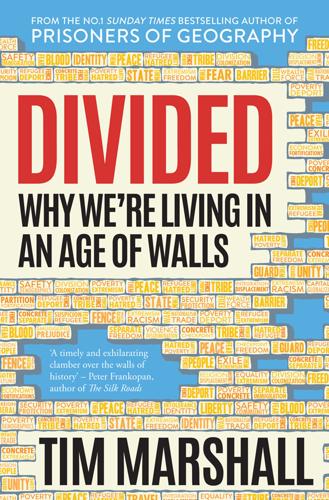
Divided: Why We're Living in an Age of Walls
by
Tim Marshall
Published 8 Mar 2018
lang=en) Neeley, Jenny, ‘Over the line: Homeland Security’s unconstitutional authority to waive all legal requirements for the purpose of building border infrastructure’, The Arizona Journal of Environmental, Law & Policy, 11 May 2011 Nowrasteh, Alex, Guide to Trump’s Executive Order to Limit Migration for ‘National Security’ Reasons (Washington, DC: Cato Institute, 26 January 2017) Obama, Barack, ‘Floor statement on immigration reform’, speech, 3 April 2006 (obamaspeeches.com/061-Immigration-Reform-Obama-Speech.htm) ‘Political polarization in the American public’, Pew Research Center, 12 June 2014 (www.people-press.org/2014/06/12/political-polarization-in-the-american-public/) Stovall, Preston, ‘Reassessing cultural divisions in the United States’, Quillette, 13 January 2017 Yearbook of Immigration Statistics (Washington, DC: DHS Office of Immigration Statistics, 2015) Chapter 3: Israel and Palestine ‘Behind the headlines: facts and figures – Islam in Israel’, Israel Ministry of Foreign Affairs, 9 June 2016 (mfa.gov.il/MFA/ForeignPolicy/Issues/ Pages/Facts-and-Figures-Islam-in-Israel.aspx) ‘A document of general principles and policies’, Hamas, 1 May 2017 (hamas .ps/en/post/678/a-document-of-general-principles-and-policies) ‘Internal fight: Palestinian abuses in Gaza and the West Bank’, Human Rights Watch, July 2008 (www.hrw.org/report/2008/07/29/internal-fight/ palestinian-abuses-gaza-and-west-bank) ‘OECD reviews of labour market and social policies: Israel’, OECD, January 2010 (www.oecd-ilibrary.org/employment/oecd-reviews-of-labour-market-and-social-policies_20743408) Starr, Kelsey Jo, and Masci, David, ‘In Israel, Jews are united by homeland but divided into very different groups’, Pew Research Centre, 8 March 2016 Vallet, Elisabeth (ed.), Borders, Fences and Walls: State of Insecurity?
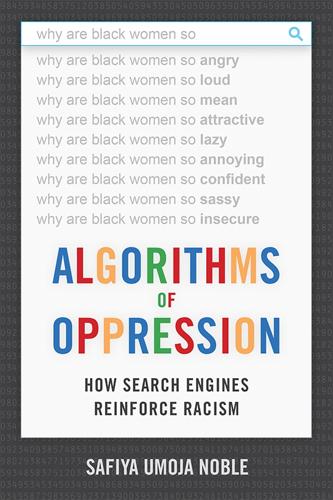
Algorithms of Oppression: How Search Engines Reinforce Racism
by
Safiya Umoja Noble
Published 8 Jan 2018
Cloud State University began organizing caucuses and committees in the American Libraries Association, including the subject analysis committee, social responsibilities round table, and REFORMA, which advocates for library services for Latinos and those who speak Spanish. Social media campaigns ensued, organized under the Twitter hashtags #DropTheWord and #NoHumanBeingIsIllegal.4 By March 29, 2016, Dartmouth College’s student-led organization the Coalition for Immigration Reform, Equality (CoFired) and DREAMers announced in a press release that after a two-year battle, in partnership with campus librarians and the American Libraries Association, “the Library of Congress will replace the term ‘illegal aliens’ with ‘noncitizens’ and ‘unauthorized immigrants’ in its subject headings.”5 “Illegal Alien” Revisited The struggle over reclassifying undocumented immigrants was part of a long history of naming members of society as problem people.
…
See advertising companies; algorithms; search engines; Twitter Bitch, 4, 181 Black, Diane, 135 Black feminism, 29–33, 92–93; antipornography rhetoric and scholarship, 100 black feminist technology studies (BFTS), 171–72 Black Girls (rock band), 69 Black Girls Code, 26, 64–65 ‘black girls’ search results, 17–21, 31, 49, 64, 66–68, 103, 160, 192n5; Chicago Urban League, 191n73; first search results, 3–4, 5; improvements, 10, 181–82; pornification, 11, 86 Black Lives Matter, 165 Black Looks (hooks), 92–94 Black Scholar, 11 Blanchette, Jean-François, 125, 128 Brandeis University report, 167 Brin, Sergey, 37, 38, 40–41, 44, 47 Brock, André, 17–21, 91, 151 Brown, Ronald, 104 Cabos-Owen, Julie, 119 Chicago Tribune, 134 Chicago Urban League, 191n73 Chin, Denny, 157 classification schemes, 150; Eurocentrism, 141; misrepresentations of women and people of color, 5, 138; racial classification, 136–37, 149. See also Library of Congress Subject Headings (LCSH) Coalition for Immigration Reform, Equality and DREAMers (CoFired), 135 Cohen, Nicole, 154 commercial influences, 16, 104 commercial interests, 32, 36, 157, 179; gaming the system, 40–41; influence on journalism, 154; transparency, 50, 104 ComputerWorld, 127 comScore Media Metrix consumer panel, 35, 53 ConsumerWatchdog.org, 56 copyright, 50, 120, 129 Crawford, Kate, 26 critical race theory, 6, 61, 136, 138, 143, 150 crowdsourcing, 188n27 Cyber Civil Rights Initiative, 120 Cyber Racism (Daniels), 116 cyberspace, 61–62; #Gamergate comments, 63; mirror of society, 90–91; social identity, 104–5 Damore, James, 2 Daniels, Jessie, 84, 108, 116, 172 Darnton, Robert, 157 Dartmouth College Freedom Budget, 134 data storage and archiving, 125–28 Davis, Jessica, 85 “A Declaration of the Independence of Cyberspace” (Barlow), 61 Department of Labor workforce data, 162 DeSantis, John, 134 Dewey Decimal Classification System, 24, 136; biases, 140 Diaz, Alejandro, 26, 42 Dickinson, Gregory M., 158–59 digital divide, 34, 56, 86, 160–61, 164, 188n21 digital footprint, 11, 187n9 digital media platforms, 5–6, 12–13, 30, 56, 148, 188n31 Dines, Gail, 101–2 distributed denial of service (DDOS), 112 Doctor, DePayne Middleton, 110 Dorsey, Joseph C., 93 Edelman, Benjamin, 44 Eisenhower, Dwight D., 190n64 employment practices: college engineering curricula, 70, 163; “pipeline issues,” 64–66; underemployment of Blacks, 80; underemployment of Black women, 69 Epstein, Robert, 52 European Commission, 157 European Court of Justice, 121 Everett, Anna, 107 Facebook, 3, 156, 158, 181; commercial content moderation, 58; content screening, 56; “diversity problems,” 65, 177; personal information, 120–21; search engine optimization, 54; underemployment of Black women, 69.
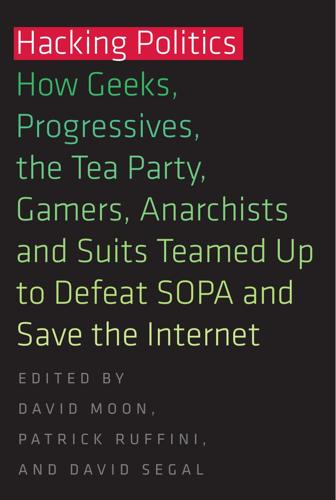
Hacking Politics: How Geeks, Progressives, the Tea Party, Gamers, Anarchists and Suits Teamed Up to Defeat SOPA and Save the Internet
by
David Moon
,
Patrick Ruffini
,
David Segal
,
Aaron Swartz
,
Lawrence Lessig
,
Cory Doctorow
,
Zoe Lofgren
,
Jamie Laurie
,
Ron Paul
,
Mike Masnick
,
Kim Dotcom
,
Tiffiniy Cheng
,
Alexis Ohanian
,
Nicole Powers
and
Josh Levy
Published 30 Apr 2013
Something about watching those clueless members of Congress debate the bill, watching them insist that they could regulate the Internet and a bunch of nerds couldn’t stop them—that really brought it home for people. This was happening. Congress was going to break the Internet and it just didn’t care. David Segal After the markup, but well before the blackout, we’d already heard from several offices that the volume of constituent contacts that they were receiving had been surpassed only by the immigration reform debate, Obama’s health care reform push, or for many offices, never at all. Even more spectacularly: in the case of the prior debates, America’s sentiments were substantially divided. But when it came to SOPA, something like 99% of us—regardless of party, geography, or ideological self-identity—were on the same side.
…
Most importantly, we’re ever-more astute activists—and now we know what winning tastes like. CONGRESS SAYS: “THIS CAN’T BE HAPPENING” DAVID SEGAL After the markup, but well before the blackout, we’d already heard from several offices that the volume of constituent contacts that they were receiving had been surpassed only by the immigration reform debate, Obama’s health care reform push, or for many offices, never at all. Even more spectacularly: in the case of the prior debates, America’s sentiments were substantially divided. But when it came to SOPA, something like 99% of us—regardless of party, geography, or ideological self-identity—were on the same side.
…
In fact, Congressional staffers later reported that the SOPA/PIPA battle had been the impetus for as many constituent contacts as any issue in memory—including recently contentious issues like health care and immigration. Somehow a bill related to DNS blocking rose to a similar level of public prominence—for at least a brief moment—but while Americans were sharply divided when it came to health care and immigration reform, they were overwhelmingly united in favor of the Internet. It was a political coming of age: the Internet had truly arrived in Washington. In the weeks leading up to the blackout, most lawmakers were treated to decentralized barrages of hundreds of emails and phone calls about SOPA/PIPA. Their social media pages were filled with inquiries about the two bills from incredulous Netizens.
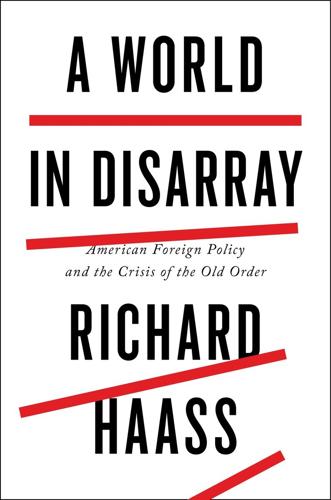
A World in Disarray: American Foreign Policy and the Crisis of the Old Order
by
Richard Haass
Published 10 Jan 2017
There is no universally accepted answer to this question, but my list would include better education at every level from preschool through K-12 through all forms of postsecondary education and on to lifelong learning. To this I would add a robust infrastructure program, something that would provide jobs, increase U.S. competitiveness, and make the society more resilient in the face of natural disasters or terrorism. Immigration reform that created greater opportunity for those with advanced degrees and needed skills to come and stay would help; also helpful would be immigration reform that included a conditional path to legal status or citizenship for many of the twelve million or so people living in the country now without the necessary documentation. Tax reform that lowers corporate rates (among the world’s highest) is desirable, as are other reforms that would lower individual rates, as well as reduce so-called tax expenditures, such as being able to deduct what is spent on mortgage interest and charitable donations or not being taxed on employer health care contributions.
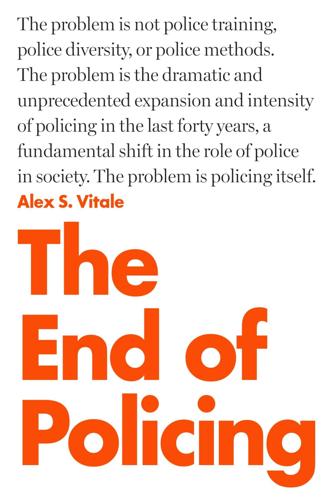
The End of Policing
by
Alex S. Vitale
Published 9 Oct 2017
When he asked under what authority the agent was operating, the agent pointed his weapon at the senator and said, “That’s all the authority I need.”11 The current intensification of border enforcement began in the early 1990s, under the Clinton administration, with the launching of Operation Gatekeeper in California, Operation Hold-the-Line in Texas, and Operation Safeguard in Arizona and the passage of the Illegal Immigration Reform and Immigration Responsibility Act of 1996 (IIRIRA). Within a few years, funding for what was then the Immigration and Naturalization Service (INS) doubled, as did the number of Border Patrol officers. These operations represented the first real effort to close the southern border.12 It involved several new initiatives, including significantly increasing the amount of fencing, immediately deporting immigrants living in the US for a long list of major and minor criminal infractions, creating immigration courts in border areas to facilitate quicker processing and deportation of captured migrants, and creating a massive system for identifying migrants through biometric data collection.
…
Conner 19, 234n43 Grant, Melissa Gira 246n4 Grant, Oscar 1 Greene, Judith 254n13, 259n2 Greenwald, Glenn 212, 251n59, 258n41 Gurley, Akai 1 Hadden, Sally 237n31 Halstead Act 129, 131 Handschu v City of New York 207 Hari, Johann 132, 229, 248n6 Harm reduction 127–8, 150–2 Harris, David 234n47 Harris, Eric 1 Harris, Jason 1 Harrison, Jason 77 Hayes, Chris 27, 235n58 Herbert, Steve 16, 92–3, 229, 234n41, 243n1, 245n2 Hernandez, Kelly 177, 229, 253n3 Hernandez-Rojas, Anastasio 188 Herrnstein, Richard 6, 232n15 Hill, Anthony 1 Holiday, Billie 132 Homeless courts 101–2 Homestead strike 204 Hoover, J. Edgar 201–2, 205 Housing First 103–4 Howell, Babe 166, 252n17 Hoyt, Edwin Palmer 257n15 Human Rights Watch 212, 250n42, 258n42 Human Trafficking Intervention Court 120–1 Illegal Immigration Reform and Immigration Responsibility Act 180, 183–4, 189 Immigration and Customs Enforcement (ICE) 178, 182–5 Immigration and Naturalization Service 180 Immigration Movement International 196, 256n50 Immigration Restriction League 176 Implicit bias 7–8, 24, 68 Independent prosecutors 17–20 International Workers of the World (IWW) 205 Jacobins 36 Jaun Crow 44 Jim Crow 33, 47–8, 225 John schools 118–19 Johnson, Benjamin 236n27 Johnson, Hank 217 Johnson, Lyndon 14 Joint Terrorism Task Forces (JTTF) 208–10 Jones, Reece 194, 230, 256n45 Justice League 55 Justice Reinvestment 224 Justice Strategies 147, 254n13, 259n2 Karp, David 252n27 Katz, Jack 253n20 Katzenbach report 14 Kelling, George 5, 231n12 Kempadoo, Kamala 246n5 Kennedy, David 167, 173, 252n19, 253n29 Kerner Commission 14, 50 Keunang, Charly Leundeu 95 King, Martin Luther 203, 206 King, Rodney 21, 159, 188 Klein, Malcolm 156, 230, 252n3 Klein, Naomi 256n3 Knapp Commission 117 Kohn, Alfi 70 Koval, Mike 87–8 Kraska, Peter 234n55 Ku Klux Klan 48 Kuzmarov, Jeremy 42, 236n22 Lager beer riots 38 Laker, Barbara 230, 248n16 Lambert, Bob 200 Lane, Roger 235n10 Latimer massacre 40 Law Enforcement against Prohibition 140 Law Enforcement Assisted Diversion 85–6 Law Enforcement Intelligence Unit 205 Leahy, Patrick 179 Legalization of alcohol 222; of drugs 152–3, 222; of gambling 222; of sex work 124, 222 Leone, Peter 74–5, 241n58 Levine, Harry 248n5, 250n41 Lewis, Paul 256n11 Lind, Dara 237n17 London Metropolitan Police 34–5, 36, 45, 199–200 Longmire, Sylvia 255n42 Lopez, Derek 66 Los Angeles Police Department (LAPD) 93–5, 137, 158–9, 169–70 Luddites 36 Mather, F.
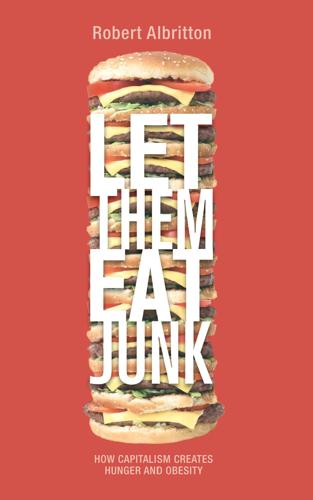
Let them eat junk: how capitalism creates hunger and obesity
by
Robert Albritton
Published 31 Mar 2009
See the Universal Declaration of Human Rights, article five, and the International Covenant of Economic, Social and Cultural Rights, article eleven. N OT E S 227 Chapter 5: The health of agriculture and food workers 1. 2. 3. 4. 5. 6. 7. 8. 9. 10. 11. 12. 13. 14. 15. 16. 17. 18. 19. 20. 21. 22. 23. 24. 25. 26. 27. 28. 29. 30. 31. 32. 33. Statement of Richard Estrada, Commissioner, US Commission on Immigration Reform before House Judiciary Subcommittee on Immigration, December 7, 1995. Available at: <www.utexas.edu/lbj/uscir/120795.html>. Economist (December 8, 2007: 11). Lien and Nerlick (2004: 201). New Internationalist (2003a: 20). Economist (September 6, 2003: 28), Lang and Heasman (2004: 90), Hacker (2004), New Internationalist (2004a).
…
Pressinger, R. (1997) “Chemical food additive exposure during pregnancy: links to learning disabilities, ADD and behaviour disorders” [online] <www.chemtox.com/pregnancy/artificial.htm>. Priesnitz, W. (2007) “Ask natural life: how green is my diet?” [online] <http://forum.stlc.com>. Putnam, R. D. (2000) Bowling Alone, New York: Touchstone. Read, A. (2006) “Protecting worker rights in the context of immigration reform”, Journal of Law and Social Change. BIBLIOGRAPHY 247 Reardon, T., Timner, P. and Berdoque, J. (2004) “The rapid rise of supermarkets in developing countries: induced organizational, institutional, and technological change in agrifood systems”, Journal of Agricultural and Development Economics, Vol. 1, No. 2.

Undoing the Demos: Neoliberalism's Stealth Revolution
by
Wendy Brown
Published 6 Feb 2015
Close consideration of the State of the Union address, however, reveals a different placing of the accent marks. While Obama called for protecting Medicare; progressive tax reform; increasing government investment in science and technology research, clean energy, home ownership, 24 u n d o in g t h e d e m o s and education; immigration reform; fighting sex discrimination and domestic violence; and raising the minimum wage, each of these issues was framed in terms of its contribution to economic growth or American competitiveness.13 “A growing economy that creates good, middle-class jobs — that must be the North Star that guides our efforts” the president intoned.
…
Clean energy would keep us competitive — “as long as countries like China keep going all-in on clean energy, so must we.”16 Fixing our aging infrastructure would “prove that there is no better place to do business than the United States of America.”17 More accessible mortgages enabling “responsible young families” to buy their first home will “help our economy grow.”18 Investing in education would reduce the drags on growth caused by teen pregnancy and violent crime, put “kids on a path to a good job,” allow them to “work their way into the middle class,” and provide the skills that would make the economy competitive. Schools should be rewarded for partnering with “colleges and employers” and for creating “classes that focus on science, technology, engineering and math — the skills today’s employers U n d o in g D e m o c r a c y 25 are looking for.”19 Immigration reform will “harness the talents and ingenuity of striving, hopeful immigrants” and attract “the highly skilled entrepreneurs and engineers that will help create jobs and grow our economy.”20 Economic growth would also result “when our wives, mothers and daughters can live their lives free from discrimination . . . and . . . fear of domestic violence,” when “we reward an honest day’s work with honest wages” with minimum wage reform, when we rebuild decimated factory towns, and when we strengthen families through “removing financial deterrents to marriage for low-income couples and doing more to encourage fatherhood.”21 Obama’s January 2013 State of the Union speech thus recovered a liberal agenda by packaging it as economic stimulus, promising that it would generate competitiveness, prosperity, and continued recovery from the recessions induced by the 2008 finance-capital meltdown.
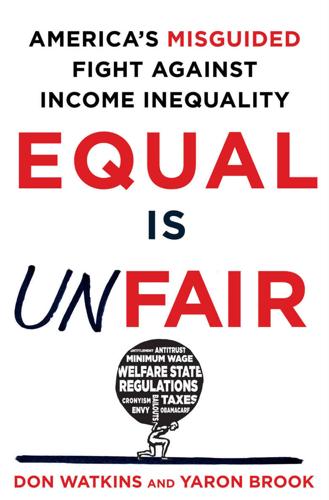
Equal Is Unfair: America's Misguided Fight Against Income Inequality
by
Don Watkins
and
Yaron Brook
Published 28 Mar 2016
Grund, The Americans in Their Moral, Social, and Political Relations, 2 vols. (London: Longman, Rees, Orme, Brown, Green and Longman, 1837), pp. 1–2, 5. Quoted in Rodgers, The Work Ethic, pp. 5–6. 26. John Locke, The Second Treatise of Government, V, 34. 27. Quoted in Jon Ward, “Paul Ryan Reads from 1850 Irish Government Poster to Make Case for Immigration Reform,” Huffington Post, June 12, 2013, http://www.huffingtonpost.com/2013/06/12/paul-ryan-poster-irish-im_n_3428852.html (accessed April 23, 2015). 28. Robert Rector and Rachel Sheffield, “Understanding Poverty in the United States: Surprising Facts about America’s Poor,” Heritage Foundation, September 13, 2011, http://www.heritage.org/research/reports/2011/09/understanding-poverty-in-the-united-states-surprising-facts-about-americas-poor (accessed April 12, 2015).
…
Benjamin Powell, “In Defense of ‘Sweatshops,’” Library of Economics and Liberty, June 2, 2008, http://www.econlib.org/library/Columns/y2008/Powellsweatshops.html (accessed May 20, 2015). 25. Ibid. 26. Ibid. 27. Richard Tedlow, Giants of Enterprise (New York: Collins, 2003), pp. 19–33. 28. Quoted in Jon Ward, “Paul Ryan Reads from 1850 Irish Government Poster to Make Case for Immigration Reform,” Huffington Post, June 12, 2013, http://www.huffingtonpost.com/2013/06/12/paul-ryan-poster-irish-im_n_3428852.html (accessed April 8, 2015). 29. Franklin D. Roosevelt, “Address at Atlanta, Georgia,” Works of Franklin D. Roosevelt, November 29, 1935, http://newdeal.feri.org/speeches/1935g.htm (accessed May 31, 2015). 30.
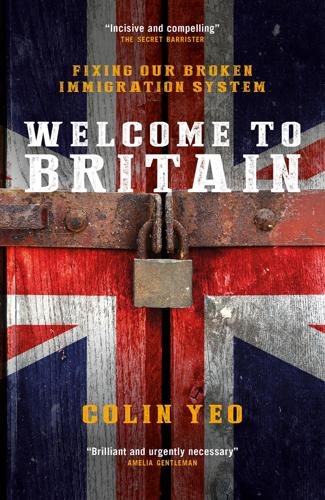
Welcome to Britain: Fixing Our Broken Immigration System
by
Colin Yeo;
Published 15 Feb 2020
No targets were set, no evaluation has been commissioned and the expense of implementation may very well be greater than the very limited savings generated. The closer we look at it, the less the hostile environment seems to be evidence-based policy-making, and the more it resembles a moral crusade. NOTES 1 ‘Lib Dem MP attacks coalition’s plans for immigration reform’, The Guardian, 13 July 2013. 2 Baker v Abellio London Ltd [2017] UKEAT 0250_16_0510. 3 See part 6a of the Immigration Rules, entitled ‘The points-based system’, available at: https://www.gov.uk/guidance/immigration-rules/immigration-rules-part-6a-the-points-based-system 4 Figures compiled from Home Office migration transparency data, available at: https://www.gov.uk/government/collections/migration-transparency-data 5 ‘London Met wins back foreign student licence’, BBC News, 9 April 2013. 6 ‘“It was a fake meeting”: Byron Hamburgers staff on immigration raid’, The Guardian, 28 July 2016. 7 ‘Pressure on law chief after fine’, BBC News, 22 September 2009. 8 ‘Lady Scotland’s former cleaner convicted of fraud’, The Guardian, 9 April 2010. 9 ‘Border police arrest cleaner at heart of Mark Harper immigration row’, The Guardian, 18 July 2014. 10 Collated from Freedom of Information requests and Home Office transparency data, available at: https://www.gov.uk/government/collections/migration-transparency-data 11 Anderson, Us and Them.
…
But actually, it is perfectly possible for officials to make judgement calls; this was not really a complex case and, as the Institute for Government has observed, there is no other department in which the minister would be expected to make day-to-day caseworking decisions on, for example, whether to terminate a person’s benefits.35 It is illuminating that in cases like this one, which are referred to ministers due to media attention, the response is almost invariably to grant the requested visa. Faced with the real, human consequences of the rules they made, ministers often decline to follow them. Theresa May was never explicit about what she expected those affected by the family immigration reforms of 2012 to do. Should they work harder or get higher-paying jobs in order to meet the rules? With 40 per cent of the working population ineligible to sponsor a spouse or partner from abroad, the rules of capitalism suggest this was never going to be possible for everyone. Blaming the poor for their own poverty has always been some people’s response.
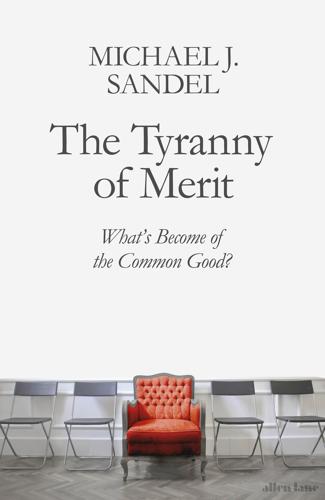
The Tyranny of Merit: What’s Become of the Common Good?
by
Michael J. Sandel
Published 9 Sep 2020
When women succeed, nations are more safe, more secure, and more prosperous.” Speaking before the U.N. General Assembly, he said the same of development aid: “It’s not just the right thing to do, it’s the smart thing to do.” Obama invoked this double-barreled appeal to ethics and smarts on issues ranging from immigration reform to extending unemployment insurance. 33 The “smart thing to do” always pointed to a prudential or self-interested reason that did not depend on moral considerations. Clinton and Obama were of course not the first political leaders to buttress moral arguments with prudential ones; what is striking is that the prudential considerations were now a matter of being “smart.”
…
Barack Obama, “Statement on International Women’s Day,” March 8, 2013, the American Presidency Project, presidency.ucsb.edu/node/303937 ; “Remarks to the United Nations General Assembly in New York City,” September 20, 2016, the American Presidency Project, presidency.ucsb.edu/node/318949 ; “Remarks on Immigration Reform,” October 24, 2013, the American Presidency Project, presidency.ucsb.edu/node/305189 ; “Remarks at Forsyth Technical Community College in Winston-Salem, North Carolina,” December 6, 2010, the American Presidency Project, presidency.ucsb.edu/node/288963 . 34. Hillary Clinton quoted in “Press Release—President Obama Announces Key State Department Appointments,” March 6, 2009, the American Presidency Project, presidency.ucsb.edu/node/322243 . 35.
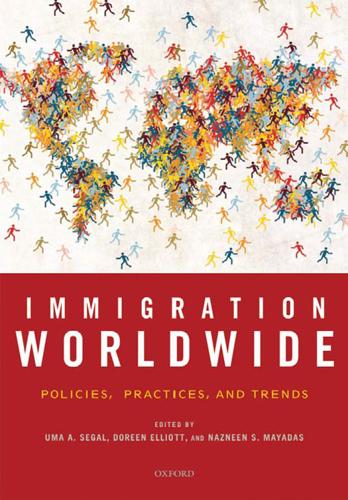
Immigration worldwide: policies, practices, and trends
by
Uma Anand Segal
,
Doreen Elliott
and
Nazneen S. Mayadas
Published 19 Jan 2010
The President and Congress determine the annual ceiling and country distributions (ceilings have ranged from 50,000–90,000). 1986: The Immigration Reform and Control Act (IRCA) legalized several undocumented immigrants but made it unlawful to hire undocumented workers. 1990: The Immigration Act of 1990 increased the annual immigrant limit to 700,000 and established the Immigrant Investor Program. 1996: Welfare Reform ended many cash and medical assistance programs for most legal immigrants. 1996: The Illegal Immigration Reform and Immigrant Responsibility Act (IIRIRA) expanded enforcement operations of the Immigration and Naturalization Service. 2001: The USA Patriot Act, in response to the September 11, 2001, terror attacks on New York and Washington, DC, gives federal officials greater power to intercept national and international communications.
…
The President and Congress determine the annual ceiling and country distributions (ceilings have ranged from 50,000–90,000). 1986: The Immigration Reform and Control Act (IRCA) legalized several undocumented immigrants but made it unlawful to hire undocumented workers. 1990: The Immigration Act of 1990 increased the annual immigrant limit to 700,000 and established the Immigrant Investor Program. 1996: Welfare Reform ended many cash and medical assistance programs for most legal immigrants. 1996: The Illegal Immigration Reform and Immigrant Responsibility Act (IIRIRA) expanded enforcement operations of the Immigration and Naturalization Service. 2001: The USA Patriot Act, in response to the September 11, 2001, terror attacks on New York and Washington, DC, gives federal officials greater power to intercept national and international communications. The Comprehensive Immigration Reform Act of 2007 was a bill that focused on managing unauthorized migration, but failed to pass the House. Its primary components were increased border security, creation of a guest worker program, a path to citizenship for undocumented workers, worksite enforcement, and criminal penalties for those continuing to reside illegally in the country.
…
The ongoing immigration debate juggles arguments regarding the assets newcomers bring to the country with those about the drains they place on the infrastructure, and the country is divided on the current net worth of immigration in the twenty-first century. The Immigrant Workforce Recent foci on immigration reform and the guest worker program have drawn attention to undocumented workers. One must bear in mind in all deliberations that of the 34 million documented immigrants in the United States in 2004, over 27 million were between the ages of 16 and 65 years, and the majority of them were in the workforce and across the occupational structure (Table 3-6).
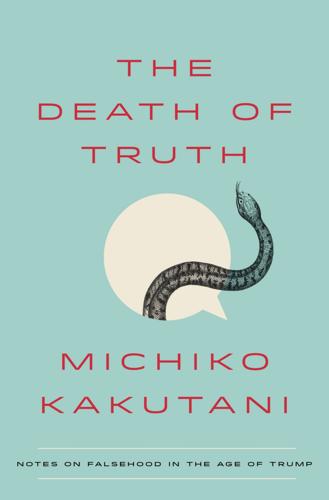
The Death of Truth: Notes on Falsehood in the Age of Trump
by
Michiko Kakutani
Published 17 Jul 2018
Many Republicans in Congress have also abandoned reason, common sense, and the deliberative process of policy making. Some freely acknowledged that they voted for the tax bill because of their big-money donors. Representative Chris Collins said, “My donors are basically saying, ‘Get it done or don’t ever call me again.’ ” Congress has failed to act on immigration reform again and again, and it’s refused to act on gun control year after year, tragedy after tragedy. When it comes to dealing with President Trump, many of these same Republicans simply ignore his multiplying lies; his appointment of woefully unqualified nominees to important government posts; his haphazard and cavalier scuttling of decades of domestic and foreign policy; his reckless decision making (which often seems to emerge, to use Pynchon’s words in Gravity’s Rainbow, from “a chaos of peeves, whims, hallucinations and all-round assholery”).

Arriving Today: From Factory to Front Door -- Why Everything Has Changed About How and What We Buy
by
Christopher Mims
Published 13 Sep 2021
The flexibility of humans means that keeping some around, no matter how automated a facility, allows companies to rotate employees through whatever job they’re most needed for at any given time. There is also, of course, the possibility that human labor becomes cheap again. “My existential threat as a robotics company is comprehensive immigration reform with a guest worker program,” says Erik. “But we’re further away from immigration reform than ever in this country, so what is a labor-constrained operator to do?” For now, across the entire e-commerce industry, the answer is hire, hire, and hire some more. The boom in employment in e-commerce has meant that the industry has, as a whole, created more jobs than have been lost in physical retail, at least from the period of around 2007 until 2017.
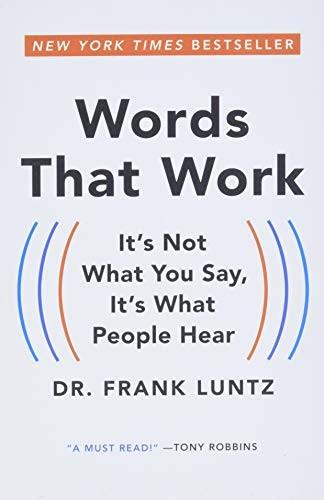
Words That Work: It's Not What You Say, It's What People Hear
by
Dr. Frank Luntz
Published 2 Jan 2007
People want a sense of control over their 401(k) plans, their pensions, and their other retirement vehicles—and Washington should be careful not to limit, restrict, or regulate anyone’s retirement nest egg in a way that seems arbitrary or wasteful. ILLEGAL IMMIGRATION Americans are not only ready for an overhaul of illegal immigration policy, they are demanding it. It has become such an important issue that many voters are willing to cast ballots against their traditional party if they disagree with their own candidate’s position on immigration reform. In the fall of 2005, I was asked to create a Language Dictionary to help Republicans channel the anger on the ground into a lexicon to help them pass tough enforcement legislation without provoking a Latino backlash. I failed. First, the words I provided often went unused. Second, there was no legislative consensus upon which to apply the words.
…
Those supportive of a guest worker program that would allow illegal immigrants to remain in the country tend to label these people “undocumented workers” because it suggests legitimate employees who simply don’t have the right paperwork, while those who want to deport these same individuals use the term “illegal aliens” because alien has the most negative connotations. And instead of addressing “immigration reform,” which polarizes Americans, you should be talking about “border security” issues. Securing our borders and our people has universal support. NEVER SAY: Drilling for oil INSTEAD SAY: Exploring for energy I have been involved in an entire language creation effort involving environmental issues, some of which is included in this book.

The Code: Silicon Valley and the Remaking of America
by
Margaret O'Mara
Published 8 Jul 2019
Instead of restricting entry by country of origin, the new system would operate on “the principle that values and rewards each man on the basis of his merit as a man,” said the President. Here was the next, necessary step in America’s commitment to civil rights and racial equity, correcting “a cruel and enduring wrong in the conduct of the American Nation.” For the bill’s opponents, the loudest of whom were Johnson’s fellow Southern Democrats, immigration reform was a dangerous opening of the floodgates. What would happen to the nation’s heritage, its citizens’ connection to their Enlightenment roots? “I don’t know of any contributions that Ethiopia has made to the making of America,” huffed North Carolina’s Sam Ervin. The special-skills provision was “just sanctimonious propaganda,” he said, allowing immigrants to come by the tens of thousands “to compete with Americans for available jobs.”2 In the end, the effects of the bill signed that day in New York Harbor went far beyond what Johnson or Ervin imagined.
…
The target of their ire wasn’t IBM or the corporations that used its products, but government bureaucracies with rapidly growing electronic databases enumerating everything from a person’s age and marital status to their medical history and draft number. Senator Sam Ervin was one of the most prominent and consistent of these critics. A strict Constitutionalist (and the ardent states-rights segregationist who had so deeply disliked 1965’s immigration reforms), Ervin gained enduring fame as the folksy chair of the Senate Watergate Committee. Before that, however, he spent the first years of the 1970s helming an investigation into government computers, and his hearings generated juicy headlines. With chairman’s gavel in one hand and a densely printed sheet of microfilm in the other, Ervin railed against the encroaching “dossier dictatorship” in Washington, warning darkly, “The computer never forgets.”24 On the House side, the crusader-in-chief was Neil Gallagher, Democrat of New Jersey, who parlayed a Kennedyesque demeanor and a knack for comparably pungent soundbites to make his name as a privacy advocate.
…
Beyond that, of course, was extraordinary philanthropy, led by Bill Gates, whose namesake foundation had a $40 billion endowment and had become the leading actor in global initiatives tackling public health and poverty. Gates, the enfant terrible turned elder statesman, became an inspiration to tech’s younger generation. Mark Zuckerberg pumped $100 million into public education in the beleaguered school system of Newark, New Jersey, became an advocate for immigration reform, and announced that he and his wife would, like Bill and Melinda Gates, give away all their wealth during their lifetimes. While the industry’s longstanding lobbying work was as active as ever, tech’s masters of the universe were becoming increasingly vocal about policy matters that went beyond the usual array of capital gains tax cuts or Internet sales taxes or net neutrality.
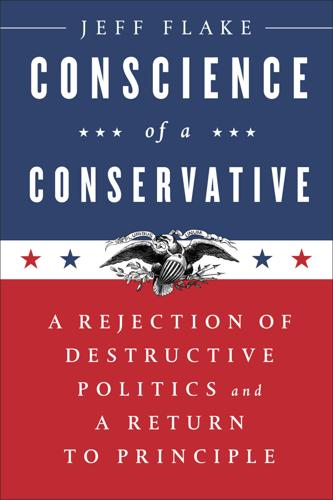
Conscience of a Conservative: A Rejection of Destructive Politics and a Return to Principle
by
Jeff Flake
Published 31 Jul 2017
The values that will redeem us are ancient and the road ahead is difficult, which is as it should be, because we know as conservatives that nothing that lasts and is worthwhile comes easily or quickly. During 2013, my first year in the Senate, I became part of a bipartisan group—led by the senior senator from Arizona, John McCain—that was set on dealing with America’s long-neglected need for comprehensive immigration reform. Bipartisan groups in Congress are almost always called “gangs,” as if bipartisanship is some kind of outlaw activity, but in any case the group became known as the “Gang of Eight.” And the bill that we would produce was one of the few major bills in years to be produced under what is known as “regular order.”
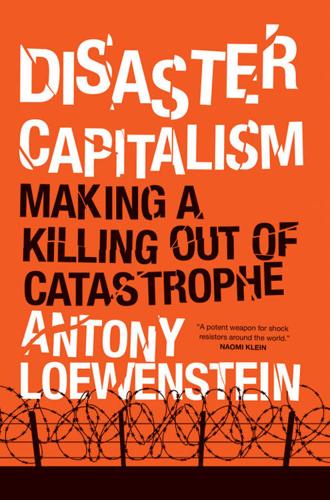
Disaster Capitalism: Making a Killing Out of Catastrophe
by
Antony Loewenstein
Published 1 Sep 2015
Detention Watch Network issued a report in 2013 that examined 250 facilities across the country, many of which were run for profit, and found that none of them could guarantee basic medical care or appropriate protection against sexual and physical abuse. A lack of official oversight exacerbated the problem, along with the 1996 Illegal Immigration Reform and Immigrant Responsibility Act, which allowed inmates to be punished for minor crimes as if they were serious felonies.40 Punishment, not rehabilitation, remained the corporate and governmental focus, as it was more profitable. CCA refused a simple proposal in 2015 from former prisoner and associate director of the Human Rights Defense Center, Alex Friedmann, for the company to commit an additional 5 percent of its net income to reducing recidivism.41 Public opposition to these companies was growing; the Interfaith Prison Coalition launched a campaign in 2015 to boycott and divest from firms that made profit from prison labor and charged exorbitant prices for prisoner phone calls.
…
Lobbying by for-profit companies ensured that the country’s privately run facilities were filled with foreign-born, legal US residents convicted of mostly minor crimes who could be deported at any time. This dragnet did nothing to ensure public safety, but instead satisfied a Republican House that embraced punishment as a response to tepid immigration reform. Azadeh Shahshahani, ACLU Georgia’s former national security and immigrants’ rights project director and president of the National Lawyers’ Guild, was one of many calling loudly for this inhumane and arbitrary law to be axed. She told me at her Atlanta office: “The bed quota is tied to corporate profit to ensure 34,000 immigrants are in beds every night.
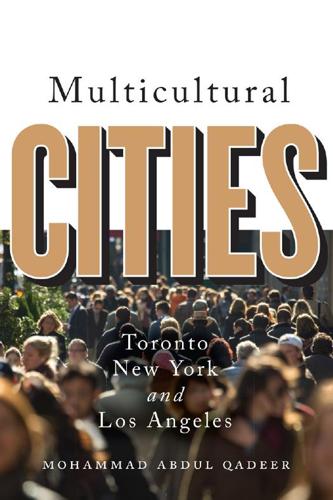
Multicultural Cities: Toronto, New York, and Los Angeles
by
Mohammed Abdul Qadeer
Published 10 Mar 2016
He particularly singled out the “Orientals” (Japanese, Chinese, and Hindus), who “cannot be assimilated” because they have their own “virtues and vices.”22 US president Teddy Roosevelt (1904–8) in a speech in 1915, said, “There is no room in this country for hyphenated Americanism … 52 Multicultural Cities We must unsparingly condemn any man who holds any other allegiance.”23 These sentiments resonate even today, particularly among those opposed to substantial immigration, even though the idiom of discourse has changed. Samuel Huntington, the Harvard academic famous for the “Clash of Civilizations” thesis, suggests, “Mexican immigration is heading towards the demographic reconquista of areas America took from Mexico by force in the 1830s and 1840s.”24 The Federation for American Immigration Reform (FAIR), a lobby group for restricting immigration argues that present-day immigrants neither make significant contribution to the economy nor are they willing to adapt to the American culture. After the terrorist attack on the World Trade Center in New York on September 11, 2001, immigration has been linked with national security.
…
See also specific countries European Union, 54 Evangelicalism, 142 exceptionalism, 26 Fainstein, S., 37, 191 fairs and festivals, 51, 58, 81–2, 157, 168, 191, 213, 250 family and neighbourhood social relations, 128–30, 289n9 family structures, 51, 129, 146–7, 195–6, 198, 289n11 Fassenden, F., 67 Federation for American Immigration Reform (FAIR), 52 fertility rates, 43 Filipinos: economic niches, 101, 105; enclaves, 66, 70, 232, 256; family structures, 129; as model minority, 105; political representation, 187; statistics, 10, 45t, 102, 104 films. See movies financial services industry: and Chinese economies, 116, 117, 118, 119; as ethnic niche, 89, 92; labour force statistics, 98t.
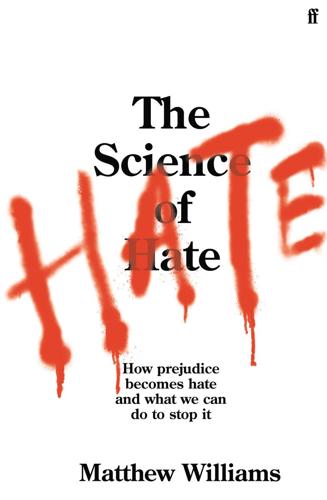
The Science of Hate: How Prejudice Becomes Hate and What We Can Do to Stop It
by
Matthew Williams
Published 23 Mar 2021
Their perception of the social acceptability of strong anti-immigrant sentiment was then measured using a donation game with real stakes. Test subjects were first told that they could make a donation to an organisation that was either pro- or anti-immigration, which would be selected at random – in reality, 90 per cent were assigned a staunchly anti-immigrant organisation, the Federation of American Immigration Reform. Subjects were then asked if they would like to authorise the donation of one dollar to the ‘randomly’ selected organisation on their behalf. Importantly, half of the subjects were told this donation would be kept private, and the other half were told it would be made public. Test subjects who had been informed of their state’s 100 per cent chance of voting for Trump were significantly more likely to donate to the anti-immigration organisation and to have it publicly known than those who were not given the same information.
…
Abdallah, Abdalraouf, 1 Abedi, Salman, 1, 2, 3, 4 abortion, 1, 2 Abu Sayyaf Group, 1 abuse, 1, 2, 3, 4, 5 accelerants to hate, 1, 2, 3, 4, 5, 6, 7, 8, 9, 10 accelerationists, 1 addiction, 1, 2, 3, 4 Admiral Duncan bar, 1 adolescence, 1, 2, 3, 4, 5, 6, 7 advertising, 1, 2, 3, 4, 5 African Americans, 1, 2, 3, 4, 5, 6, 7 afterlife, 1, 2 age, 1, 2 aggression: brain and hate, 1, 2, 3, 4, 5; false alarms, 1; group threat, 1, 2, 3, 4, 5, 6; identity fusion, 1; mortality, 1; pyramid of hate, 1; trauma and containment, 1, 2 AI, see artificial intelligence Albright, Jonathan, 1 alcohol, 1, 2, 3, 4, 5, 6, 7, 8 algorithms: far-right hate, 1, 2, 3, 4; filter bubbles and bias, 1, 2; Google, 1, 2, 3; online hate speech, 1, 2, 3, 4, 5, 6; Tay, 1, 2; tipping point, 1, 2; YouTube, 1 Algotransparency.org, 1 Allport, Gordon, 1, 2, 3, 4 Al Noor Mosque, Christchurch, 1 al-Qaeda, 1, 2 Alternative für Deutschland (AfD), 1 alt-right: algorithms, 1, 2; brain and hate, 1; Charlottesville rally, 1, 2; counter-hate speech, 1; definition, 1n; Discord, 1; Facebook, 1, 2, 3; fake accounts, 1; filter bubbles, 1, 2; red-pilling, 1, 2; social media, 1, 2; Trump, 1, 2; YouTube, 1 Alzheimer’s disease, 1 American Crowbar Case, 1 American culture, 1 American Nazi Party, 1, 2 Amodio, David, 1n amygdala: brain and signs of prejudice, 1, 2; brain tumours, 1; disengaging the amygdala autopilot, 1; hate and feeling pain, 1, 2; and insula, 1; neuroscience of hate, 1n, 2, 3, 4; parts that edge us towards hate, 1; parts that process prejudice, 1; prepared versus learned amygdala responses, 1, 2; processing of ‘gut-deep’ hate, 1; recognising facial expressions, 1n, 2; stopping hate, 1, 2; trauma and containment, 1, 2; unlearning prejudiced threat detection, 1 anger, 1, 2, 3, 4, 5, 6, 7, 8 anonymity, 1, 2 anterior insula, 1n Antifa, 1, 2n, 3 anti-gay prejudice, 1, 2, 3, 4, 5, 6, 7, 8 anti-hate initiatives, 1, 2 antilocution, 1 anti-Muslim hate, 1, 2, 3, 4, 5, 6 anti-Semitism, 1, 2, 3, 4, 5, 6 anti-white hate crime, 1 Antonissen, Kirsten, 1, 2 anxiety: brain and hate, 1, 2, 3, 4; harm of hate speech, 1; intergroup contact, 1, 2; subcultures of hate, 1, 2; trauma and containment, 1; trigger events, 1, 2 Arab people, 1, 2, 3, 4, 5, 6 Arbery, Ahmaud, 1 Arkansas, 1, 2 artificial intelligence (AI), 1, 2, 3, 4 Asian Americans, 1, 2 Asian people, 1, 2, 3, 4 assault, 1, 2, 3 asylum seekers, 1, 2, 3, 4 Athens, 1 Atlanta attack, 1 Atran, Scott, 1, 2 attachment, 1 attention, 1, 2, 3 attitudes, 1, 2, 3, 4, 5, 6 Aung San Suu Kyi, 1 austerity, 1 Australia, 1 autism, 1 averages, 1, 2 avoidance, 1, 2, 3 Bali attack, 1 Bangladeshi people, 1 BBC (British Broadcasting Corporation), 1, 2, 3 behavioural sciences, 1, 2 behaviour change, 1, 2, 3 beliefs, 1, 2, 3 Bell, Sean, 1, 2 Berger, Luciana, 1 Berlin attacks, 1 bias: algorithms, 1; brain and hate, 1, 2, 3, 4, 5, 6, 7; filter bubbles, 1; Google Translate, 1; group threat, 1, 2, 3, 4; police racial bias, 1; predicting hate crime, 1; stopping hate, 1, 2, 3; unconscious bias, 1, 2, 3, 4 Bible, 1 Biden, Joe, 1 ‘Big Five’ personality traits, 1 biology, 1, 2, 3, 4, 5, 6, 7 Birstall, 1 bisexual people, 1 Black, Derek, 1, 2 Black, Don, 1, 2, 3 blackface, 1 Black Lives Matter, 1 Black Mirror, 1n black people: author’s brain and hate, 1, 2, 3, 4, 5; brain and signs of prejudice, 1, 2; brain parts that edge us towards hate, 1; brain parts that process prejudice, 1; Charlottesville rally, 1, 2; disengaging the amygdala autopilot, 1; Duggan shooting, 1; feeling pain, 1; Google searches, 1, 2; group threat, 1, 2, 3, 4; online hate speech, 1, 2, 3, 4; police relations, 1, 2; predicting hate crime, 1, 2; prepared versus learned amygdala responses, 1; pyramid of hate, 1, 2, 3n; recognising facial expressions, 1, 2; South Africa, 1; steps to stop hate, 1, 2, 3, 4; trauma and Franklin, 1, 2, 3, 4; trigger events, 1, 2, 3; unconscious bias, 1; unlearning prejudiced threat detection, 1, 2; white flight, 1 BNP, see British National Party Bolsonaro, Jair, 1 Bosnia and Herzegovina, 1, 2 bots, 1, 2, 3, 4, 5 Bowers, Robert Gregory, 1 boys, 1, 2 Bradford, 1 brain: ancient brains in modern world, 1; author’s brain and hate, 1; beyond the brain, 1; the brain and hate, 1; brain and signs of prejudice, 1; brain damage and tumours, 1, 2, 3, 4; brains and unconscious bias against ‘them’, 1; brain’s processing of ‘gut-deep’ hate, 1; defence mechanisms, 1; disengaging the amygdala autopilot, 1; figures, 1; finding a neuroscientist and brain scanner, 1; group threat detection, 1, 2; hacking the brain to hate, 1; hate and feeling pain, 1; locating hate in the brain, 1; neuroscience and big questions about hate, 1; overview, 1; parts that edge us towards hate, 1; parts that process prejudice, 1; prepared versus learned amygdala responses, 1; recognising facial expressions, 1; rest of the brain, 1; signs of prejudice, 1; steps to stop hate, 1, 2; tipping point to hate, 1, 2, 3, 4, 5; trauma and containment, 1, 2; unlearning prejudiced threat detection, 1; where neuroscience of hate falls down, 1 brain imaging: author’s brain and hate, 1; beyond the brain, 1; the brain and hate, 1; brain and signs of prejudice, 1, 2; brain injury, 1, 2; Diffusion MRI, 1; disengaging the amygdala autopilot, 1; finding a neuroscientist and brain scanner, 1; fusiform face area, 1; locating hate in the brain, 1; MEG, 1; neuroscience of hate, 1, 2, 3; parts that process prejudice, 1; prepared versus learned amygdala responses, 1; processing of ‘gut-deep’ hate, 1; subcultures of hate, 1, 2; unconscious bias, 1 brainwashing, 1, 2 Bray, Mark, 1n Brazil, 1, 2, 3 Breivik, Anders, 1, 2 Brexit, 1, 2, 3, 4n, 5, 6, 7, 8, 9 Brexit Party, 1, 2 Brick Lane, London, 1 Britain First, 1, 2 British identity, 1, 2 British National Party (BNP), 1, 2n, 3, 4, 5 Brixton, 1 Broadmoor Hospital, 1, 2 Brooker, Charlie, 1n Brooks, Rayshard, 1 Brown, Katie, 1, 2 Brown, Michael, 1, 2 Brussels attack, 1 Budapest Pride, 1 bullying, 1, 2 Bundy, Ted, 1 burka, 1, 2, 3 Burmese, 1 Bush, George W., 1 Byrd, James, Jr, 1 California, 1, 2n, 3 Caliskan, Aylin, 1 Cambridge Analytica, 1, 2 cancer, 1, 2 Cardiff University Brain Research Imaging Centre (CUBRIC), 1, 2, 3, 4 caregiving motivational system, 1 care homes, 1, 2 Casablanca, 1 cascade effect, 1, 2 categorisation, 1, 2, 3, 4 Catholics, 1 Caucasian Crew, 1 causality, 1, 2 celebrities, 1, 2, 3, 4 censorship, 1, 2 Centennial Olympic Park, Atlanta, 1 Centers for Disease Control (CDC), 1 change blindness, 1 charity, 1, 2, 3 Charlottesville rally, 1, 2, 3n, 4 chatbots, 1, 2, 3 Chauvin, Derek, 1 Chelmsford, 1 Chicago, 1 childhood: attachment issues, 1; child abuse, 1, 2, 3; child grooming, 1; child play, 1; failures of containment, 1, 2, 3, 4; group threat, 1, 2; intergroup contact, 1, 2; learned stereotypes, 1; online hate speech, 1, 2; predicting hate crime, 1; trauma and containment, 1, 2, 3, 4, 5, 6, 7, 8, 9, 10; trigger events, 1, 2; understanding the ‘average’ hate criminal, 1; understanding the ‘exceptional’ hate offender, 1, 2, 3 China, 1, 2, 3, 4 Chinese people, 1, 2, 3 ‘Chinese virus,’ 1, 2 Cho, John, 1 Christchurch mosque attack, 1 Christianity, 1, 2, 3 cinema, 1 citizen journalism, 1 civilising process, 1 civil rights, 1, 2, 3, 4 class, 1, 2 cleaning, 1 climate change, 1, 2 Clinton, Hillary, 1, 2 cognitive behavioural therapy, 1 cognitive dissonance, 1 Cohen, Florette, 1, 2 Cold War, 1 collective humiliation, 1 collective quests for significance, 1, 2 collective trauma, 1, 2 colonialism, 1n, 2 Combat 1, 2 comedies, 1, 2, 3 Communications Acts, 1, 2 compassion, 1, 2, 3 competition, 1, 2, 3, 4, 5, 6, 7, 8 confirmation bias, 1 conflict, 1, 2, 3, 4 conflict resolution, 1, 2, 3, 4, 5 Connectome, 1 Conroy, Jeffrey, 1 Conservative Party, 1, 2, 3 conspiracy theories, 1, 2, 3 contact with others, 1, 2 containment: failures of, 1; hate as container of unresolved trauma, 1; understanding the ‘exceptional’ hate offender, 1, 2, 3 content moderation, 1, 2, 3 context, 1, 2, 3 Convention of Cybercrime, 1 cooperation, 1, 2, 3, 4, 5, 6 Copeland, David, 1, 2, 3, 4, 5, 6, 7 coping mechanisms, 1, 2, 3, 4, 5, 6, 7 Cordoba House (‘Ground Zero mosque’), 1 correction for multiple comparisons, 1, 2n ‘corrective rape’, 1, 2 cortisol, 1 Council of Conservative Citizens, 1n counter-hate speech, 1, 2, 3, 4 courts, 1, 2, 3, 4, 5, 6 COVID-19 pandemic, 1, 2, 3 Cox, Jo, 1, 2, 3 Criado Perez, Caroline, 1 crime, 1, 2, 3, 4, 5, 6, 7 Crime and Disorder Act 1998, 1n crime recording, 1, 2, 3, 4 crime reporting, 1, 2, 3, 4, 5, 6, 7 Crime Survey for England and Wales (CSEW), 1 criminal justice, 1, 2, 3 Criminal Justice Act, 1, 2n criminal prosecution, 1, 2 criminology, 1, 2, 3, 4, 5, 6 cross-categorisation, 1 cross-race or same-race effect, 1 Crusius, Patrick, 1, 2 CUBRIC (Cardiff University Brain Research Imaging Centre), 1, 2, 3, 4 cultural ‘feeding’, 1, 2, 3, 4, 5 cultural worldviews, 1, 2, 3, 4, 5, 6, 7 culture: definitions, 1; group threat, 1, 2, 3; steps to stop hate, 1, 2, 3; tipping point, 1, 2, 3, 4, 5; unlearning prejudiced threat detection, 1 culture machine, 1, 2, 3, 4, 5 culture wars, 1 Curry and Chips, 1 cybercrime, 1 dACC, see dorsal anterior cingulate cortex Daily Mail, 1, 2 Dailymotion, 1 Daily Stormer, 1, 2n Daley, Tom, 1, 2 Darfur, 1 dark matter, 1 death: events that remind us of our mortality, 1; newspapers, 1; predicting hate crime, 1; religion and hate, 1, 2; subcultures of hate, 1, 2; trigger events, 1, 2 death penalty, 1, 2 death threats, 1 decategorisation, 1 De Dreu, Carsten, 1, 2, 3, 4 deep learning, 1, 2 defence mechanisms, 1 defensive haters, 1, 2 dehumanisation, 1, 2, 3, 4, 5, 6 deindividuation, 1, 2 deindustrialisation, 1, 2, 3, 4 Democrats, 1, 2, 3 Denny, Reginald, 1 DeSalvo, Albert (the Boston Strangler), 1 desegregation, 1, 2, 3 Desmond, Matthew, 1 Dewsbury, 1, 2, 3 Diffusion Magnetic Resonance Imaging (Diffusion MRI), 1, 2 diminished responsibility, 1, 2 Director of Public Prosecutions (DPP), 1 disability: brain and hate, 1, 2; group threat, 1, 2, 3, 4, 5, 6; intergroup contact, 1; Japan care home, 1, 2; online hate speech, 1; profiling the hater, 1; suppressing prejudice, 1; victim perception, 1n Discord, 1, 2, 3, 4 discrimination: brain and hate, 1, 2; comedy programmes, 1; Google searches, 1; Japan laws, 1; preference for ingroup, 1; pyramid of hate, 1, 2, 3; questioning prejudgements, 1; trigger events, 1, 2, 3 disgust: brain and hate, 1, 2, 3, 4, 5, 6; group threat detection, 1, 2, 3; ‘gut-deep’ hate, 1, 2; Japan care home, 1; what it means to hate, 1, 2 disinformation, 1, 2, 3 displacement, 1, 2 diversity, 1, 2, 3 dlPFC, see dorsolateral prefrontal cortex domestic violence, 1, 2, 3, 4, 5, 6, 7, 8, 9, 10 Doran, John, 1, 2, 3 dorsal anterior cingulate cortex (dACC), 1, 2, 3n, 4, 5, 6, 7, 8, 9 dorsolateral prefrontal cortex (dlPFC), 1n, 2, 3 Douglas, Mary, Purity and Danger, 1 drag queens, 1 drugs, 1, 2, 3, 4, 5, 6, 7, 8, 9 Duggan, Mark, 1 Duke, David, 1 Dumit, Joe, Picturing Personhood, 1 Durkheim, Emile, 1 Dykes, Andrea, 1 Earnest, John T., 1 Eastern Europeans, 1, 2, 3 Ebrahimi, Bijan, 1, 2, 3, 4, 5, 6 echo chambers, 1, 2n economy, 1, 2, 3, 4, 5, 6 EDL, see English Defence League education, 1, 2, 3, 4 Edwards, G., 1 8chan, 1, 2 elections, 1, 2, 3, 4, 5, 6 electroencephalography, 1n elites, 1 ELIZA (computer program), 1 The Ellen Show, 1 El Paso shooting, 1 Elrod, Terry, 1 Emancipation Park, Charlottesville, 1 Emanuel African Methodist Church, Charleston, 1 emotions: brain and hate, 1, 2, 3, 4n, 5, 6, 7, 8, 9; group threat, 1; subcultures of hate, 1; trigger events and mortality, 1; what it means to hate, 1, 2, 3, 4 empathy: brain and hate, 1, 2, 3, 4, 5, 6; feeling hate together, 1; group threat, 1, 2; steps to stop hate, 1, 2, 3; subcultures of hate, 1; trauma and containment, 1 employment, 1, 2, 3, 4, 5, 6, 7 English Defence League (EDL), 1, 2n, 3 epilepsy, 1, 2, 3, 4, 5 Epstein, Robert, 1 equality, 1, 2 Essex, 1 ethnicity, 1, 2n, 3, 4 ethnic minorities, 1, 2, 3, 4, 5, 6 ethnocentrism, 1 EU, see European Union European Commission, 1, 2 European Digital Services Act, 1 European Parliament, 1, 2 European Social Survey, 1 European Union (EU): Brexit referendum, 1, 2, 3, 4n, 5; Facebook misinformation, 1; group threat, 1, 2; online hate speech, 1, 2, 3; trigger events, 1 Eurovision, 1 evidence-based hate crime, 1 evolution, 1, 2, 3, 4, 5, 6, 7, 8 executive control area: brain and hate, 1, 2, 3, 4, 5, 6, 7, 8; disengaging the amygdala autopilot, 1, 2; extremism, 1; recognising false alarms, 1; trauma and containment, 1; trigger events, 1 exogenous shocks, 1 expert opinion, 1 extreme right, 1, 2, 3, 4, 5 extremism: Charlottesville and redpilling, 1, 2; feeling hate together, 1; online hate speech, 1; perceiving versus proving hate, 1; quest for significance, 1, 2, 3; subcultures of hate, 1, 2, 3, 4, 5, 6, 7; trauma and containment, 1; trigger events, 1, 2, 3 Facebook: algorithms, 1, 2; Charlottesville rally, 1, 2; Christchurch mosque attack, 1; far-right hate, 1, 2, 3, 4, 5; filter bubbles, 1, 2; how much online hate speech, 1, 2; Myanmar genocide, 1; online hate and offline harm, 1, 2, 3; redpilling, 1; stopping online hate speech, 1, 2, 3, 4 facial expression, 1, 2, 3, 4 faith, 1, 2 fake accounts, 1, 2; see also bots fake news, 1, 2, 3, 4 false alarms, 1, 2, 3 Farage, Nigel, 1, 2 far left, 1n, 2, 3, 4 Farook, Syed Rizwan, 1 far right: algorithms, 1, 2, 3, 4; brain injury, 1; Charlottesville rally, 1, 2, 3n, 4; COVID-19 pandemic, 1, 2; Facebook, 1, 2, 3, 4, 5; filter bubbles, 1, 2; gateway sites, 1; group threat, 1, 2; red-pilling, 1; rise of, 1; stopping online hate speech, 1; subcultures of hate, 1, 2, 3, 4, 5; terror attacks, 1, 2, 3; tipping point, 1, 2; trauma and containment, 1, 2, 3, 4n; trigger events, 1, 2; YouTube, 1 fathers, 1, 2, 3 FBI, see Federal Bureau of Investigation fear: brain and hate, 1, 2, 3, 4, 5, 6, 7; feeling hate together, 1; group threat, 1, 2, 3, 4, 5; mortality, 1; online hate speech, 1, 2, 3; steps to stop hate, 1, 2; trauma and containment, 1, 2; trigger events, 1, 2, 3 Federal Bureau of Investigation (FBI), 1, 2, 3, 4, 5, 6, 7 Federation of American Immigration Reform, 1 Ferguson, Missouri, 1 Festinger, Leon, 1 fiction, 1 Fields, Ted, 1 50 Cent Army, 1 ‘fight or flight’ response, 1, 2, 3 films, 1, 2 filter bubbles, 1, 2, 3, 4 Finland, 1, 2, 3, 4, 5, 6 Finsbury Park mosque attack, 1, 2, 3 first responders, 1 Fiske, Susan, 1 Five Star Movement, 1 flashbacks, 1 Florida, 1, 2 Floyd, George, 1, 2, 3 Flynt, Larry, 1 fMRI (functional Magnetic Resonance Imaging), 1, 2, 3, 4, 5, 6, 7 football, 1, 2, 3, 4, 5 football hooligans, 1, 2 Forever Welcome, 1 4chan, 1, 2 Fox News, 1, 2 Franklin, Benjamin, 1 Franklin, Joseph Paul, 1, 2, 3, 4, 5, 6, 7, 8 Fransen, Jayda, 1 freedom fighters, 1, 2 freedom of speech, 1, 2, 3, 4, 5, 6 frustration, 1, 2, 3, 4 functional Magnetic Resonance Imaging (fMRI), 1, 2, 3, 4, 5, 6, 7 fundamentalism, 1, 2 fusiform face area, 1 fusion, see identity fusion Gab, 1 Gadd, David, 1, 2n, 3, 4 Gaddafi, Muammar, 1, 2 Gage, Phineas, 1, 2 galvanic skin responses, 1 Gamergate, 1 gateway sites, 1 gay people: author’s experience, 1, 2, 3; brain and hate, 1, 2; Copeland attacks, 1, 2; COVID-19 pandemic, 1; filter bubbles, 1; gay laws, 1; gay marriage, 1, 2, 3; group associations, 1; group threat, 1, 2, 3, 4, 5; hate counts, 1, 2, 3, 4; physical attacks, 1, 2; profiling the hater, 1; Russia, 1, 2, 3, 4, 5; Section 1, 2, 3, 4; steps to stop hate, 1, 2, 3; trigger events, 1, 2; why online hate speech hurts, 1; see also LGBTQ+ people gay rights, 1, 2, 3, 4 gender, 1, 2, 3, 4, 5, 6, 7 Generation Identity, 1 Generation Z, 1, 2 genetics, 1n, 2, 3 genocide, 1, 2, 3, 4, 5, 6 Georgia (country), 1 Georgia, US, 1, 2, 3, 4 Germany, 1, 2, 3, 4, 5, 6, 7 Gilead, Michael, 1 ginger people, 1 girls, and online hate speech, 1 Gladwell, Malcolm, 1 Global Project Against Hate and Extremism, 1 glucocorticoids, 1, 2 God, 1, 2 God’s Will, 1, 2 Goebbels, Joseph, 1 Google, 1, 2, 3, 4, 5, 6, 7, 8 Google+, 1 Google Translate, 1 goth identity, 1, 2, 3, 4 governments, 1, 2, 3, 4, 5, 6 Grant, Oscar, 1 gravitational waves, 1 Great Recession (2007–9), 1 Great Replacement conspiracy theory, 1 Greece, 1, 2 Greenberg, Jeff, 1, 2, 3 Greene, Robert, 1 grey matter, 1 Grillot, Ian, 1, 2 Grodzins, Morton, 1 grooming, 1, 2, 3 ‘Ground Zero mosque’ (Cordoba House), 1 GroupMe, 1 groups: ancient brains in modern world, 1; brain and hate, 1, 2, 3, 4; childhood, 1; feeling hate together, 1; foundations of prejudice, 1; group threat and hate, 1; identity fusion, 1, 2, 3; intergroup hate, 1; pyramid of hate, 1; reasons for hate offending, 1; steps to stop hate, 1, 2; tipping point, 1, 2, 3, 4; warrior psychology, 1, 2, 3; what it means to hate, 1, 2 group threat, 1; beyond threat, 1; Bijan as the threatening racial other, 1; context and threat, 1; cultural machine, group threat and stereotypes, 1; evolution of group threat detection, 1; human biology and threat, 1; neutralising the perception of threat, 1; overview, 1; society, competition and threat, 1; threat in their own words, 1 guilt, 1, 2, 3, 4 guns, 1, 2 ‘gut-deep’ hate, 1, 2, 3, 4 Haines, Matt, 1 Haka, 1 Halle Berry neuron, 1, 2 harassment, 1, 2, 3, 4, 5 harm of hate, 1, 2, 3, 4, 5, 6, 7 Harris, Brendan, 1 Harris, Lasana, 1 Harris, Lovell, 1, 2, 3, 4 hate: author’s brain and hate, 1; the brain and hate, 1; definitions, 1, 2; feeling hate together, 1; foundations of prejudice and hate, 1, 2, 3; group threat and hate, 1; ‘gut-deep’ hate, 1, 2; hate counts, 1; hate in word and deed, 1; profiling the hater, 1; pyramid of hate, 1; rise of the bots and trolls, 1; seven steps to stop hate, 1; subcultures of hate, 1; tipping point from prejudice to hate, 1; trauma, containment and hate, 1; trigger events and ebb and flow of hate, 1; what it means to hate, 1 hate counts, 1; criminalising hate, 1; how they count, 1; overview, 1; perceiving versus proving hate, 1; police and hate, 1; rising hate count, 1; ‘signal’ hate acts and criminalisation, 1; Sophie Lancaster, 1; warped world of hate, 1 hate crime: author’s experience, 1, 2, 3; brain and hate, 1, 2, 3, 4, 5; definitions, 1; events and hate online, 1; events and hate on the streets, 1, 2; the ‘exceptional’ hate criminal, 1; far-right hate, 1, 2, 3; foundations of prejudice and hate, 1, 2, 3, 4; group threat, 1, 2, 3, 4, 5, 6, 7, 8; hate counts, 1, 2, 3, 4, 5; laws, 1n, 2, 3, 4, 5; number of crimes, 1, 2; online hate speech, 1, 2, 3, 4; predicting hate crime, 1; profiling the hater, 1; steps to stop hate, 1, 2, 3; trauma and containment, 1, 2, 3, 4; trigger events, 1, 2, 3, 4, 5, 6; understanding the ‘average’ hate criminal, 1; understanding the ‘exceptional’ hate offender, 1; what it means to hate, 1, 2, 3 hate groups, 1, 2, 3, 4, 5 hate in word and deed, 1; algorithmic far right, 1; Charlottesville rally, 1, 2, 3n, 4; extreme filter bubbles, 1; game changer for the far right, 1; gateway sites, 1; overview, 1; ‘real life effort post’ and Christchurch, 1; red-pilling, 1 HateLab, 1, 2, 3, 4, 5 hate speech: far-right hate, 1, 2, 3; filter bubbles and bias, 1; harm of, 1; how much online hate speech, 1; Japan laws, 1; pyramid of hate, 1; stopping online hate speech, 1; Tay chatbot, 1; trigger events, 1, 2, 3; why online hate speech hurts, 1 hate studies, 1, 2 ‘hazing’ practices, 1 health, 1, 2, 3, 4 Henderson, Russell, 1 Herbert, Ryan, 1 Hewstone, Miles, 1 Heyer, Heather, 1 Hinduism, 1, 2 hippocampus, 1, 2, 3, 4 history of offender, 1 Hitler, Adolf, 1, 2, 3, 4, 5, 6, 7 HIV/AIDS, 1, 2, 3, 4, 5, 6, 7 hollow mask illusion, 1, 2 Hollywood, 1, 2 Holocaust, 1, 2, 3, 4 Homicide Act, 1n homophobia: author’s experience, 1, 2, 3, 4; brain and hate, 1, 2, 3; evidence-based hate crime, 1; federal law, 1; jokes, 1; online hate speech, 1, 2; Russia, 1, 2; Shepard murder, 1; South Africa, 1; trauma and containment, 1; victim perception of motivation, 1n Homo sapiens, 1 homosexuality: author’s experience, 1; online hate speech, 1; policing, 1; questioning prejudgements, 1; Russia, 1, 2; trauma and containment, 1, 2; see also gay people hooligans, 1, 2 Horace, 1 hormones, 1, 2, 3 hot emotions, 1 hot-sauce study, 1, 2 housing, 1, 2, 3, 4, 5, 6 Huddersfield child grooming, 1 human rights, 1, 2, 3 humiliation, 1, 2, 3, 4, 5, 6 humour, 1, 2 Hungary, 1 hunter-gatherers, 1n, 2 Hustler, 1 IAT, see Implicit Association Test identity: author’s experience of attack, 1; British identity, 1, 2; Charlottesville rally, 1, 2; children’s ingroups, 1; group threat, 1, 2; online hate speech, 1, 2, 3, 4; steps to stop hate, 1, 2 identity fusion: fusion and hateful murder, 1; fusion and hateful violence, 1; fusion and self-sacrifice in the name of hate, 1; generosity towards the group, 1; tipping point, 1, 2; warrior psychology, 1, 2, 3 ideology, 1, 2, 3, 4 illegal hate speech, 1, 2, 3, 4 illocutionary speech, 1 imaging, see brain imaging immigration: Forever Welcome, 1; group threat, 1, 2, 3, 4, 5, 6, 7; hate counts, 1n, 2; HateLab Brexit study, 1; identity fusion, 1; intergroup contact, 1; negative stereotypes, 1; online hate speech, 1; Purinton, 1, 2; trauma and containment, 1, 2, 3; trigger events, 1, 2n, 3, 4, 5, 6, 7; YouTube algorithms, 1 immortality, 1, 2 Implicit Association Test (IAT), 1, 2, 3, 4, 5, 6, 7, 8, 9 implicit prejudice: author’s brain and hate, 1, 2, 3, 4; brain and hate, 1, 2, 3, 4, 5, 6; online hate speech, 1, 2 India, 1 Indonesia, 1 Infowars, 1, 2 Ingersoll, Karma, 1 ingroup: brain and hate, 1, 2, 3, 4; child play, 1; group threat, 1, 2, 3, 4, 5, 6, 7; HateLab Brexit study, 1; identity fusion, 1, 2; pyramid of hate, 1; reasons for hate offending, 1; trigger events, 1, 2, 3; what it means to hate, 1, 2, 3, 4, 5 Instagram, 1, 2, 3 Institute for Strategic Dialogue, 1 institutional racism, 1 instrumental crimes, 1 insula: brain and signs of prejudice, 1, 2, 3; facial expressions, 1, 2; fusiform face area, 1; hacking the brain to hate, 1; hate and feeling pain, 1; neuroscience of hate, 1n, 2, 3, 4, 5; parts that edge us towards hate, 1; parts that process prejudice, 1; processing of ‘gut-deep’ hate, 1, 2 Integrated Threat Theory (ITT), 1, 2, 3 integration, 1, 2, 3, 4 intergroup contact, 1, 2, 3 Intergroup Contact Theory, 1, 2, 3 intergroup hate, 1, 2, 3, 4 internet: algorithms, 1, 2; chatbots, 1; counterhate speech, 1; COVID-19 pandemic, 1; far-right hate, 1, 2, 3, 4, 5, 6, 7; filter bubbles, 1, 2, 3; Google searches, 1; hate speech harm, 1; how much online hate speech, 1; online news, 1; reasons for hate offending, 1; rise of the bots and trolls, 1; stopping online hate speech, 1; tipping point, 1, 2, 3; training the machine to count hate, 1; why online hate speech hurts, 1 interracial relations, 1, 2, 3, 4 intolerance, 1, 2 Iranian bots, 1 Iraq, 1 Irish Republican Army (IRA), 1 ISIS, 1, 2, 3, 4, 5, 6, 7, 8, 9 Islam: group threat, 1; online hate speech, 1, 2, 3, 4, 5; steps to stop hate, 1, 2, 3; subcultures of hate, 1, 2, 3, 4; trigger events, 1, 2, 3 Islamism: group threat, 1; online hate speech, 1, 2, 3, 4; profiling the hater, 1; subcultures of hate, 1, 2, 3; trigger events, 1, 2, 3 Islamophobia, 1, 2, 3, 4 Israel, 1, 2, 3 Italy, 1, 2 ITT, see Integrated Threat Theory James, Lee, 1, 2, 3, 4, 5, 6 Japan, 1, 2, 3 Jasko, Katarzyna, 1 Jefferson, Thomas, 1 Jenny Lives with Eric and Martin, 1 Jewish people: COVID-19 pandemic, 1, 2; far-right hate, 1, 2, 3, 4, 5; filter bubbles, 1; Google searches, 1, 2; group threat, 1; Nazism, 1, 2; negative stereotypes, 1 2 online hate speech, 1; pyramid of hate, 1; questioning prejudgements, 1; ritual washing, 1; subcultures of hate, 1, 2; trauma and Franklin, 1, 2, 3 jihad, 1, 2, 3, 4, 5 jokes, 1, 2, 3, 4, 5, 6, 7 Jones, Alex, 1 Jones, Terry, 1 Josephson junction, 1 Judaism, 1; see also Jewish people Jude, Frank, Jr, 1, 2, 3, 4, 5 Kansas, 1 Kerry, John, 1 Kik, 1 King, Gary, 1 King, Martin Luther, Jr, 1, 2 King, Rodney, 1, 2, 3 King, Ryan, 1 Kirklees, 1, 2 KKK, see Ku Klux Klan Kuchibhotla, Srinivas, 1, 2, 3, 4 Kuchibhotla, Sunayana, 1, 2 Ku Klux Klan (KKK), 1, 2, 3n, 4, 5, 6, 7 Labour Party, 1, 2, 3 Lancaster, Sophie, 1, 2 language, 1, 2, 3, 4, 5, 6, 7 LAPD (Los Angeles Police Department), 1 Lapshyn, Pavlo, 1 Lashkar-e-Taiba, 1 Las Vegas shooting, 1, 2 Latinx people, 1, 2, 3, 4, 5, 6, 7 law: brain and hate, 1, 2, 3; criminalising hate, 1; hate counts, 1, 2, 3; Kansas shooting, 1; limited laws, 1; online hate speech, 1; pyramid of hate, 1 Law Commission, 1 Lawrence, Stephen, 1 learned fears, 1, 2, 3 Leave.EU campaign, 1, 2 Leave voters, 1, 2, 3n Lee, Robert E., 1, 2, 3 left orbitofrontal cortex, 1n, 2n Legewie, Joscha, 1, 2, 3, 4 lesbians, 1, 2 Levin, Jack, 1 LGBTQ+ people, 1, 2, 3, 4, 5, 6, 7, 8, 9, 10, 11, 12, 13, 14, 15, 16, 17; see also gay people LIB, see Linguistic Intergroup Bias test Liberman, Nira, 1 Liberty Park, Salt Lake City, 1, 2 Libya, 1, 2, 3, 4 Light, John, 1 Linguistic Intergroup Bias (LIB) test, 1 Liverpool, 1, 2 Livingstone, Ken, 1, 2 Loja, Angel, 1 London: author’s experience of attack, 1; Copeland nail bombing, 1, 2; Duggan shooting, 1; far-right hate, 1; group threat, 1, 2, 3; online hate speech, 1, 2; Rigby attack, 1; terror attacks, 1, 2, 3, 4, 5, 6 London Bridge attack, 1, 2, 3 London School of Economics, 1 ‘lone wolf’ terrorists, 1, 2, 3, 4 long-term memory, 1, 2, 3, 4 Loomer, Laura, 1 Los Angeles, 1 loss: group threat, 1; subcultures of hate, 1, 2, 3, 4; tipping point, 1; trauma and containment, 1, 2, 3, 4, 5 love, 1, 2 Love Thy Neighbour, 1 Lucero, Marcelo, 1, 2 Luqman, Shehzad, 1 ‘Macbeth effect’, 1 machine learning, 1 Madasani, Alok, 1, 2, 3 Madrid attack, 1, 2 Magnetic Resonance Imaging (MRI): Diffusion MRI, 1, 2; functional MRI, 1, 2, 3, 4, 5, 6, 7 magnetoencephalography (MEG), 1, 2, 3 Maldon, 1 Malik, Tashfeen, 1 Maltby, Robert, 1, 2 Manchester, 1, 2 Manchester Arena attack, 1, 2, 3, 4, 5, 6 marginalisation, 1, 2 Martin, David, 1 Martin, Trayvon, 1, 2 MartinLutherKing.org, 1, 2 martyrdom, 1, 2, 3, 4n masculinity, 1, 2, 3, 4, 5 The Matrix, 1 Matthew Shepard and James Byrd Jr Hate Crimes Prevention Act, 1n, 2n Matz, Sandra, 1 Mauritius, 1 McCain, John, 1 McDade, Tony, 1 McDevitt, Jack, Levin McKinney, Aaron, 1 McMichael, Gregory, 1 McMichael, Travis, 1 media: far-right hate, 1, 2; group threat, 1, 2, 3; steps to stop hate, 1, 2, 3, 4, 5, 6; stereotypes in, 1, 2; subcultures of hate, 1; trigger events, 1 Meechan, Mark, 1 MEG (magnetoencephalography), 1, 2, 3 memory, 1, 2, 3, 4, 5, 6, 7 men, and online hate speech, 1 men’s rights, 1 mental illness, 1, 2, 3, 4, 5, 6 mentalising, 1, 2, 3 meta-analysis, 1 Metropolitan Police, 1 Mexican people, 1, 2, 3, 4 micro-aggressions, 1, 2n, 3, 4, 5, 6 micro-events, 1 Microsemi, 1n Microsoft, 1, 2, 3, 4, 5, 6 micro-targeting, 1, 2 Middle East, 1, 2 migration, 1, 2, 3, 4, 5, 6, 7; see also immigration Milgram, Stanley, 1 military, 1 millennials, 1 Milligan, Spike, 1 Milwaukee, 1, 2, 3 minimal groups, 1 Minneapolis, 1, 2, 3 minority groups: far-right hate, 1, 2; group threat, 1, 2, 3, 4, 5; police reporting, 1; questioning prejudgements, 1; trauma and containment, 1; trigger events, 1, 2 misinformation, 1, 2, 3, 4, 5, 6 mission haters, 1, 2, 3 mobile phones, 1, 2, 3 moderation of content, 1, 2, 3 Moore, Nik, 1 Moore, Thomas, 1 Moores, Manizhah, 1 Moore’s Ford lynching, 1 Moradi, Dr Zargol, 1, 2, 3, 4, 5, 6 Moral Choice Dilemma tasks, 1, 2, 3 moral cleansing, 1, 2, 3 moral dimension, 1, 2, 3, 4 moral outrage, 1, 2, 3, 4, 5 Moroccan people, 1, 2 mortality, 1, 2, 3 mortality salience, 1, 2, 3, 4, 5 Moscow, 1 mosques, 1, 2, 3, 4, 5, 6, 7 Moss Side Blood, 1 mothers, 1, 2, 3, 4, 5, 6 motivation, 1n, 2, 3, 4, 5, 6 Mphiti, Thato, 1 MRI, see Magnetic Resonance Imaging Muamba, Fabrice, 1 multiculturalism, 1, 2, 3, 4 murder: brain injury, 1, 2; group threat, 1, 2, 3; hate counts, 1; identity fusion and hateful murder, 1; police and hate, 1, 2; profiling the hater, 1; trauma and containment, 1, 2, 3, 4, 5 Murdered for Being Different, 1 music, 1, 2, 3 Muslims: COVID-19 pandemic, 1; far-right hate, 1, 2, 3, 4; Google searches, 1; group threat, 1, 2, 3, 4, 5, 6; negative stereotypes, 1; online hate speech, 1, 2; profiling the hater, 1, 2; Salah effect, 1; subcultures of hate, 1, 2, 3; trigger events, 1, 2, 3, 4, 5; and Trump, 1, 2, 3, 4n, 5, 6n Mvubu, Themba, 1 Myanmar, 1, 2 Myatt, David, 1 Nandi, Dr Alita, 1 National Action, 1 National Consortium for the Study of Terrorism and Responses to Terrorism, 1 national crime victimisation surveys, 1, 2 National Front, 1, 2, 3 nationalism, 1, 2 National Socialist Movement, 1, 2, 3, 4 natural experiments, 1, 2 Nature: Neuroscience, 1 nature vs nurture debate, 1 Nazism, 1, 2, 3, 4, 5, 6, 7, 8 NCVS (National Crime Victimisation Survey), 1, 2 negative stereotypes: brain and hate, 1, 2; feeling hate together, 1, 2; group threat, 1, 2, 3, 4, 5, 6; steps to stop hate, 1, 2, 3, 4, 5; tipping point, 1 Nehlen, Paul, 1 neo-Nazis, 1n, 2, 3, 4, 5, 6 Netherlands, 1, 2 Netzwerkdurchsetzungsgesetz (NetzDG) law, 1 neuroimaging, see brain imaging neurons, 1, 2, 3, 4, 5, 6, 7 neuroscience, 1, 2, 3, 4, 5, 6, 7, 8, 9 Newark, 1, 2 news, 1, 2, 3, 4, 5, 6, 7 newspapers, 1, 2, 3, 4 New York City, 1, 2, 3, 4, 5, 6 New York Police Department (NYPD), 1 New York Times, 1, 2 New Zealand, 1 n-grams, 1 Nimmo, John, 1 9/11 attacks, 1, 2, 3, 4, 5, 6, 7 911 emergency calls, 1 Nogwaza, Noxolo, 1 non-independence error, 1, 2n Al Noor Mosque, Christchurch, 1 Northern Ireland, 1 NWA, 1 NYPD (New York Police Department), 1 Obama, Barack, 1n, 2, 3, 4, 5, 6 Occupy Paedophilia, 1 ODIHR, see Office for Democratic Institutions and Human Rights Ofcom, 1 offence, 1, 2, 3, 4 Office for Democratic Institutions and Human Rights (ODIHR), 1, 2 Office for Security and Counter Terrorism, 1 office workers, 1 offline harm, 1, 2 Oklahoma City, 1 O’Mahoney, Bernard, 1 online hate speech: author’s experience, 1; COVID-19 pandemic, 1; far-right hate, 1, 2, 3, 4, 5; hate speech harm, 1; how much online hate speech, 1; individual’s role, 1; law’s role, 1; social media companies’ role, 1; steps to stop hate, 1; tipping point, 1, 2; training the machine to count hate, 1; trigger events, 1 Ono, Kazuya, 1 optical illusions, 1 Organization for Human Brain Mapping conference, 1 Orlando attack, 1 Orwell, George, Nineteen Eighty-Four, 1 Osborne, Darren, 1 ‘other’, 1, 2, 3, 4, 5, 6 Ottoman Empire, 1 outgroup: author’s brain and hate, 1, 2, 3; brain and hate, 1, 2, 3, 4, 5, 6, 7; child interaction and play, 1, 2; evolution of group threat detection, 1; feeling hate together, 1; group threat, 1, 2, 3, 4, 5, 6; ‘gut-deep’ hate, 1; HateLab Brexit study, 1; human biology and threat, 1; identity fusion, 1; prejudice formation, 1; profiling the hater, 1; push/pull factor, 1; pyramid of hate, 1; society, competition and threat, 1; steps to stop hate, 1, 2; tipping point, 1; trauma and containment, 1, 2, 3, 4, 5; trigger events, 1, 2, 3, 4, 5, 6, 7, 8 outliers, 1 Overton window, 1, 2, 3, 4 oxytocin, 1, 2, 3, 4 Paddock, Stephen, 1 Paddy’s Pub, Bali, 1 paedophilia, 1, 2, 3, 4, 5 page rank, 1 pain, 1, 2, 3, 4, 5, 6, 7 Pakistani people, 1, 2, 3, 4, 5 Palestine, 1 pandemics, 1, 2, 3, 4 Papua New Guinea, 1, 2, 3 paranoid schizophrenia, 1, 2 parents: caregiving, 1; subcultures of hate, 1; trauma and containment, 1, 2, 3, 4, 5; trigger events, 1, 2, 3 Paris attack, 1 Parsons Green attack, 1, 2 past experience: the ‘average’ hate criminal, 1; the ‘exceptional’ hate criminal, 1; trauma and containment, 1 perception-based hate crime, 1, 2 perception of threat, 1, 2, 3, 4, 5 perpetrators, 1, 2 personal contact, 1, 2 personality, 1, 2, 3 personality disorder, 1, 2 personal safety, 1, 2 personal significance, 1 perspective taking, 1, 2 PFC, see prefrontal cortex Philadelphia Police Department, 1 Philippines, 1 physical attacks, 1, 2, 3, 4, 5, 6, 7, 8 play, 1 Poland, 1, 2, 3 polarisation, 1, 2, 3, 4, 5 police: brain and hate, 1, 2; Duggan shooting, 1; group threat, 1, 2, 3; and hate, 1; NYPD racial bias, 1; online hate speech, 1, 2, 3, 4; perceiving versus proving hate, 1; police brutality, 1, 2, 3, 4; predicting hate crime, 1; recording crime, 1, 2, 3, 4; reporting crime, 1, 2, 3; rising hate count, 1, 2, 3; ‘signal’ hate acts and criminalisation, 1; steps to stop hate, 1, 2, 3; use of force, 1 Polish migrants, 1 politics: early adulthood, 1; far-right hate, 1, 2; filter bubbles and bias, 1; group threat, 1, 2, 3; online hate speech, 1, 2; seven steps to stop hate, 1, 2, 3, 4; trauma and containment, 1; trigger events, 1, 2, 3, 4, 5; Trump election, 1, 2 populism, 1, 2, 3, 4, 5 pornography, 1 Portugal, 1, 2 positive stereotypes, 1, 2 post-traumatic stress disorder (PTSD), 1, 2, 3, 4, 5 poverty, 1, 2, 3 Poway synagogue shooting, 1 power, 1, 2, 3, 4, 5 power law, 1 predicting the next hate crime, 1 prefrontal cortex (PFC): brain and signs of prejudice, 1; brain injury, 1; disengaging the amygdala autopilot, 1; feeling pain, 1; ‘gut-deep’ hate, 1; prejudice network, 1; psychological brainwashing, 1; recognising false alarms, 1; salience network, 1; trauma and containment, 1; trigger events, 1; unlearning prejudiced threat detection, 1, 2 prehistoric brain, 1, 2 prehistory, 1, 2 prejudgements, 1 prejudice: algorithms, 1; author’s brain and hate, 1, 2, 3, 4, 5, 6, 7; brain and hate, 1, 2, 3, 4, 5, 6, 7; brain and signs of prejudice, 1; cultural machine, 1; far-right hate, 1, 2; filter bubbles and bias, 1; foundations of, 1; Google, 2; group threat, 1, 2, 3, 4, 5, 6, 7, 8, 9; human biology and threat, 1; neuroscience of hate, 1, 2; online hate speech, 1, 2, 3; parts that process prejudice, 1; prejudice network, 1, 2, 3, 4; prepared versus learned amygdala responses, 1; pyramid of hate, 1; releasers, 1, 2; steps to stop hate, 1, 2, 3, 4; tipping point from prejudice to hate, 1; trauma and containment, 1, 2, 3, 4, 5; trigger events, 1, 2, 3, 4, 5, 6, 7, 8; Trump, 1, 2; unconscious bias, 1; unlearning prejudiced threat detection, 1; what it means to hate, 1, 2, 3, 4, 5 prepared fears, 1, 2 Prisoner’s Dilemma, 1 profiling the hater, 1 Proposition 1, 2 ProPublica, 1n, 2 prosecution, 1, 2, 3 Protestants, 1 protons, 1 psychoanalysis, 1 psychological development, 1, 2, 3, 4 psychological profiles, 1 psychological training, 1 psychology, 1, 2, 3, 4 psychosocial criminology, 1, 2 psy-ops (psychological operations), 1 PTSD, see post-traumatic stress disorder Public Order Act, 1 pull factor, 1, 2, 3, 4, 5 Pullin, Rhys, 1n Purinton, Adam, 1, 2, 3, 4, 5, 6, 7 push/pull factor, 1, 2, 3, 4, 5, 6 pyramid of hate, 1, 2 Q …, 1 al-Qaeda, 1, 2 quality of life, 1 queer people, 1, 2 quest for significance, 1, 2, 3 Quran burning, 1 race: author’s brain and hate, 1, 2, 3, 4; brain and hate, 1, 2, 3, 4, 5, 6, 7; brain and signs of prejudice, 1; far-right hate, 1, 2, 3; Google searches, 1; group threat, 1, 2, 3, 4, 5, 6, 7, 8, 9, 10; hate counts, 1, 2, 3; online hate speech, 1; predicting hate crime, 1; pyramid of hate, 1; race relations, 1, 2, 3; race riots, 1, 2; race war, 1, 2, 3, 4, 5; steps to stop hate, 1, 2, 3; trauma and containment, 1, 2, 3, 4n, 5, 6; trigger events, 1, 2; unconscious bias, 1; unlearning prejudiced threat detection, 1 racism: author’s experience, 1; brain and hate, 1, 2, 3, 4, 5, 6; far-right hate, 1, 2; group threat, 1, 2, 3, 4, 5, 6, 7, 8; Kansas shooting, 1; NYPD racial bias, 1; online hate speech, 1, 2, 3, 4; steps to stop hate, 1n, 2, 3; Tay chatbot, 1; trauma and containment, 1, 2, 3, 4, 5, 6, 7; Trump election, 1; victim perception of motivation, 1n; white flight, 1 radicalisation: far-right hate, 1, 2, 3; group threat, 1; subcultures of hate, 1, 2, 3, 4, 5; trigger events, 1 rallies, 1, 2, 3; see also Charlottesville rally Ramadan, 1, 2 rape, 1, 2, 3, 4, 5 rap music, 1 realistic threats, 1, 2, 3, 4, 5 Rebel Media, 1 rebels, 1 recategorisation, 1 recession, 1, 2, 3, 4, 5 recommendation algorithms, 1, 2 recording crime, 1, 2, 3, 4 red alert, 1 Reddit, 1, 2, 3, 4 red-pilling, 1, 2, 3, 4 refugees, 1, 2, 3, 4, 5 rejection, 1, 2, 3, 4, 5, 6 releasers of prejudice, 1, 2 religion: group threat, 1, 2, 3; homosexuality, 1; online hate speech, 1, 2, 3; predicting hate crime, 1; pyramid of hate, 1; religion versus hate, 1; steps to stop hate, 1, 2; subcultures of hate, 1, 2; trauma and containment, 1n, 2; trigger events, 1, 2, 3, 4, 5; victim perception of motivation, 1n reporting crimes, 1, 2, 3, 4, 5, 6, 7 repression, 1 Republicans, 1, 2, 3, 4, 5 research studies, 1 responsibility, 1, 2, 3 restorative justice, 1 retaliatory haters, 1, 2, 3 Reuters, 1 Rieder, Bernhard, 1 Rigby, Lee, 1 rights: civil rights, 1, 2, 3, 4; gay rights, 1, 2, 3, 4; human rights, 1, 2, 3; men’s rights, 1; tipping point, 1; women’s rights, 1, 2 right wing, 1, 2, 3, 4, 5, 6; see also far right Right-Wing Authoritarianism (RWA) scale, 1 riots, 1, 2, 3, 4 risk, 1, 2, 3 rites of passage, 1, 2 rituals, 1, 2, 3 Robb, Thomas, 1 Robbers Cave Experiment, 1, 2, 3, 4, 5, 6 Robinson, Tommy (Stephen Yaxley-Lennon), 1, 2, 3, 4 Rohingya Muslims, 1, 2 Roof, Dylann, 1, 2 Roussos, Saffi, 1 Rudolph, Eric, 1 Rushin, S,, 1n Russia, 1, 2, 3, 4, 5, 6, 7, 8 Russian Internet Research Agency, 1 RWA (Right-Wing Authoritarianism) scale, 1 Rwanda, 1 sacred value protection, 1, 2, 3, 4, 5, 6, 7, 8 Saddam Hussein, 1 safety, 1, 2 Sagamihara care home, Japan, 1, 2 Salah, Mohamed, 1, 2, 3 salience network, 1, 2 salmon, brain imaging of, 1 Salt Lake City, 1 same-sex marriage, 1, 2 same-sex relations, 1, 2, 3 San Bernardino attack, 1n, 2, 3 Scanlon, Patsy, 1 scans, see brain imaging Scavino, Dan, 1n schizophrenia, 1, 2, 3, 4 school shootings, 1, 2 science, 1, 2, 3 scripture, 1, 2 SDO, see Social Dominance Orientation (SDO) scale Search Engine Manipulation Effect (SEME), 1 search queries, 1, 2, 3, 4 Second World War, 1, 2, 3 Section 1, Local Government Act, 1, 2, 3 seed thoughts, 1 segregation, 1, 2, 3 seizures, 1, 2, 3 selection bias problem, 1n self-defence, 1, 2 self-esteem, 1, 2, 3, 4 self-sacrifice, 1, 2, 3 Senior, Eve, 1 serial killers, 1, 2, 3 7/7 attack, London, 1 seven steps to stop hate, 1; becoming hate incident first responders, 1; bursting our filter bubbles, 1; contact with others, 1; not allowing divisive events to get the better of us, 1; overview, 1; putting ourselves in the shoes of ‘others’, 1; questioning prejudgements, 1; recognising false alarms, 1 sexism, 1, 2 sexual orientation, 1, 2, 3, 4, 5, 6, 7 sexual violence, 1, 2, 3, 4, 5 sex workers, 1, 2, 3, 4 Shakespeare, William, Macbeth, 1 shame, 1, 2, 3, 4, 5, 6, 7, 8, 9 shared trauma, 1, 2, 3 sharia, 1, 2 Shepard, Matthew, 1, 2 Sherif, Muzafer, 1, 2, 3, 4, 5, 6, 7 shitposting, 1, 2, 3n shootings, 1, 2, 3, 4, 5, 6, 7, 8 ‘signal’ hate acts, 1 significance, 1, 2, 3 Simelane, Eudy, 1 skin colour, 1, 2, 3n, 4, 5, 6, 7 Skitka, Linda, 1, 2 slavery, 1 Slipknot, 1 slurs, 1, 2, 3, 4, 5, 6 Snapchat, 1 social class, 1, 2 social desirability bias, 1, 2 Social Dominance Orientation (SDO) scale, 1 social engineering, 1 socialisation, 1, 2, 3, 4, 5 socialism, 1, 2 social media: chatbots, 1; COVID-19 pandemic, 1; far-right hate, 1, 2, 3, 4; filter bubbles and bias, 1; HateLab Brexit study, 1; online hate speech, 1, 2, 3, 4, 5; online news, 1; pyramid of hate, 1; steps to stop hate, 1, 2, 3; subcultures of hate, 1; trigger events, 1, 2; see also Facebook; Twitter; YouTube Social Perception and Evaluation Lab, 1 Soho, 1 soldiers, 1n, 2, 3 Sorley, Isabella, 1 South Africa, 1 South Carolina, 1 Southern Poverty Law Center, 1n, 2 South Ossetians, 1 Soviet Union, 1, 2 Spain, 1, 2, 3 Spencer, Richard B., 1 Spengler, Andrew, 1, 2, 3, 4 SQUIDs, see superconducting quantum interference devices Stacey, Liam, 1, 2 Stanford University, 1 Star Trek, 1, 2, 3 statistics, 1, 2, 3, 4, 5, 6, 7, 8 statues, 1 Stephan, Cookie, 1, 2 Stephan, Walter, 1, 2 Stephens-Davidowitz, Seth, Everybody Lies, 1 Stereotype Content Model, 1 stereotypes: brain and hate, 1, 2, 3, 4, 5, 6, 7; cultural machine, group threat and stereotypes, 1; definitions, 1; feeling hate together, 1, 2; group threat, 1, 2, 3, 4; homosexuality, 1; NYPD racial bias, 1; steps to stop hate, 1, 2, 3, 4, 5; study of prejudice, 1; tipping point, 1; trigger events, 1 Stoke-on-Trent, 1, 2 Stormfront website, 1, 2, 3 storytelling, 1 stress, 1, 2, 3, 4, 5, 6, 7, 8 striatum, 1, 2, 3n, 4 subcultures, 1, 2, 3, 4, 5 subcultures of hate, 1; collective quests for significance and extreme hate, 1; extremist ideology and compassion, 1; fusion and generosity towards the group, 1; fusion and hateful murder, 1; fusion and hateful violence, 1; fusion and self-sacrifice in the name of hate, 1; quest for significance and extreme hatred, 1; religion/belief, 1; warrior psychology, 1 subhuman, 1, 2 Sue, D.
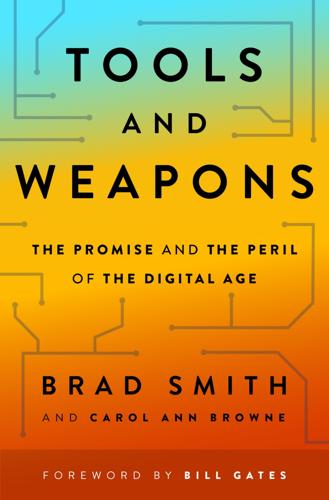
Tools and Weapons: The Promise and the Peril of the Digital Age
by
Brad Smith
and
Carol Ann Browne
Published 9 Sep 2019
And the political support for its various pieces began to fall apart. The tech sector confronted this growing discord as it dealt with immigration challenges soon after the twenty-first century began. Year after year, the Republicans would support highly skilled immigrants but not broader immigration reform. The Democrats would support highly skilled immigrants but only as part of broader immigration reform. Years of talking with leaders of both parties almost always ended with the frustrating conclusion that nothing would get done. After the 2016 presidential race, it only became worse. As Satya and I flew to New York in December 2016 for President-Elect Trump’s meeting with tech leaders at Trump Tower, we decided that we would find a way to raise the issue of immigration at some point in the conversation.
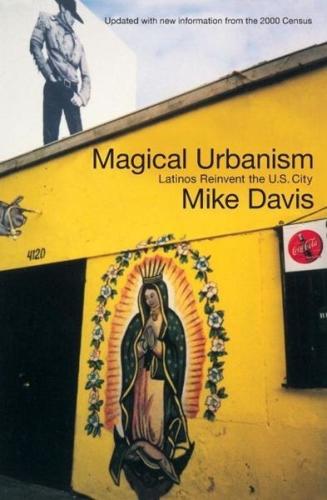
Magical Urbanism: Latinos Reinvent the US City
by
Mike Davis
Published 27 Aug 2001
candy ^^"^ On Long similarly threadbare Central American immigrants - whom were laid off subway in Island, many of during the defense industry downsizing of 1990-93 - expressed to Sarah Mahler narratives of disillusion- ment: "Their portrayals of their dejection, marginalization lives in America are full of deceit, and exploitation." The 1986 Immigration Reform Act (IRC A), moreover, tionalized unprecedented extremes of economic and institu- social mar- THE PUERTO RICAN TRAGEDY While ginality. 2.5 million previously 109 undocumented immigrants gained legal rights to work, and, potentially, to citizenship, several million others who after the deadline, asserts, who arrived became criminalized pariahs ("underneath underdog," as Charlie Mingus once put Mahler amnesty or failed to qualify for "IRCA it).
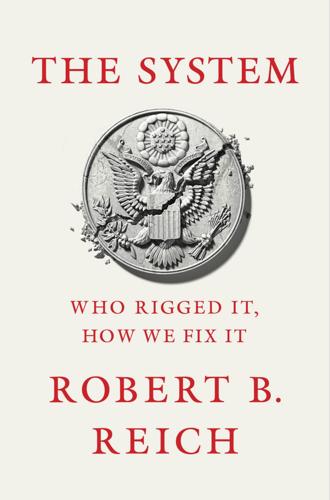
The System: Who Rigged It, How We Fix It
by
Robert B. Reich
Published 24 Mar 2020
And, surprisingly, 25% of those eligible for various types of federal assistance programs don’t get any help.” He cautioned that “no one can claim that the promise of equal opportunity is being offered to all Americans through our education systems, nor are those who have run afoul of our justice system getting the second chance that many of them deserve. And we have been debating immigration reform for 30 years. Simply put, the social needs of far too many of our citizens are not being met.” In his 2017 letter he warned, “We should be ringing the national alarm bell that inner city schools are failing our children,” and noted that “over the last 16 years, we have spent trillions of dollars on wars when we could have been investing that money productively.”
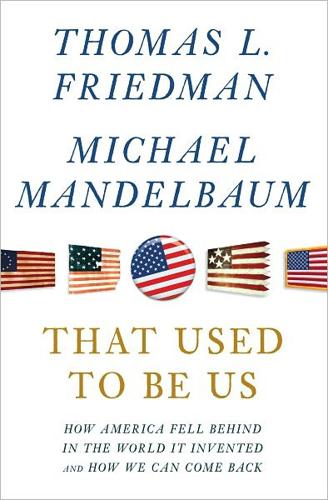
That Used to Be Us
by
Thomas L. Friedman
and
Michael Mandelbaum
Published 1 Sep 2011
We need to keep a constant flow of legal immigrants into our country, whether they wear blue collars or lab coats. It is a part of our formula that very few countries can copy. When all of these energetic, high-aspiring people are mixed together with a democratic system and free markets, magic happens. If we want to keep that magic, we need immigration reform that guarantees that we will always attract and retain, in a legal, orderly fashion, the world’s first-round aspirational and intellectual draft choices. The overall winner of the 2010 Intel contest—a $100,000 award for the best project out of the forty—was Erika Alden DeBenedictis of New Mexico, who developed a software navigation system that would enable spacecraft to “travel through the solar system” more efficiently.
…
“The H-1B visa program—that is the key to making us the innovators of energy and computers,” said Senator Lindsey Graham, the South Carolina Republican, who has been critical of his own party’s obstinacy on this issue. “It has been for most of our life. If you wanted to get really smart and have a degree that would allow you to be a leader in the world, you came to America. Well, it’s hard as hell to get to America now. And once you get here, it’s hard to stay.” Immigration reform that better secures the borders, establishes a legal pathway toward citizenship for the roughly twelve million illegal immigrants who are here, and enables, even recruits, high-skilled immigrants to become citizens is much more urgent than most of us realize. We need both the brainy risk takers and the brawny ones.
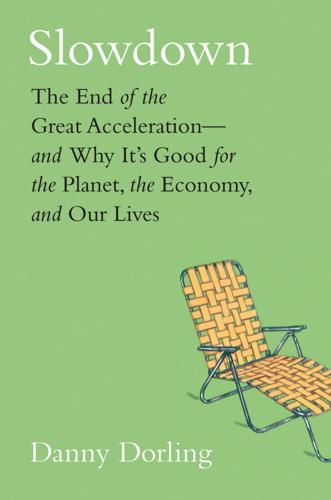
Slowdown: The End of the Great Acceleration―and Why It’s Good for the Planet, the Economy, and Our Lives
by
Danny Dorling
and
Kirsten McClure
Published 18 May 2020
Six other countries contributed more than 1 million people to the United States’ immigration numbers: Puerto Rico, Vietnam, El Salvador, Cuba, South Korea, and the Dominican Republic.12 The great and growing economic inequality of the United States sucked in people from neighboring and nearby countries, especially Mexico. U.S. politicians reacted to this acceleration with sanctions. The Illegal Immigration Reform and Immigrant Responsibility Act (IIRIRA) was signed into law in September 1996. “I don’t think people fully appreciated what those laws had done,” said New York University academic Nancy Morawetz, referring to both the IIRIRA and other 1996 laws that affected immigration. One effect was clear: after IIRIRA came into effect, deportation from the United States went from being a rare phenomenon to a relatively common one: “Before 1996, internal enforcement activities had not played a very significant role in immigration enforcement,” noted sociologists Douglas Massey and Karen Pren.
…
See also carbon emissions gross domestic product (GDP), 232–41; China, 239–41, 241; concept of, 232–33; global, per capita, 233–37, 234, 292, 293, 297; United States, 237–39, 238 Grosz, Stephen, 317 Guatemala, 209, 210 Haiti, 212, 213 Haque, Umair, 319 Harrison, John, 30 Hawking, Stephen, 144 height, average adult, 266–67, 268, 269, 283 Henriksson, Anna-Maja, 312 hierarchy, 152, 182, 264, 285–86, 363n50 High-Speed Society (Rosa and Scheuerman), 272–73, 360n28, 360n30 home-loan debt, 49–56, 54 Hong Kong, 154, 263 household appliances, 267, 269 housing: house prices, 247–51, 249, 253–55; mortgages, 49–56, 54; rental, 49–50, 53; social housing, 51, 56 Huygens, Christiaan, 30 Ibbitson, John, 140, 141, 296 Illegal Immigration Reform and Immigrant Responsibility Act (IIRIRA), 153–54 immigration: and birth rates, 312; future scarcity of, 296; Japan and, 326; and population growth, 318; United Kingdom and, 165; United States and, 152, 153–54, 296, 318 income inequality, 24, 284, 294 India: automobile production, 115, 118; democracy in, 264–65; fertility rates, 226, 227; population, 3, 147, 165–68, 167, 171, 307–8 Indicators of Social Change (Sheldon and Moore), 313 Indonesia, 172, 173, 174 Industrial Revolution, 99, 230 Indus Valley Civilization, 264 inequalities: debt and the concentration of wealth, 37–38, 45–46, 56–58; and population slowdown, 7–8; redistribution imperative, 294–95; and slowdown, 319–22, 343n1; in United States, 152–53 infant mortality, 185, 217–18, 220 information.

The Speech: The Story Behind Dr. Martin Luther King Jr. S Dream
by
Gary Younge
Published 11 Aug 2013
Blacks and Latinos were far more likely to vote for Obama than previous Democratic candidates, and since there were more of them than ever before, that left Republicans dependent on winning an even higher percentage of white votes than usual. This was widely understood to be one of the key reasons for the Republican defeat in 2012, prompting a two-pronged response. The first was to reevaluate the party’s image among nonwhite Americans. This involved a substantial shift in its attitude toward immigration reform and a more cosmetic reappraisal of its rhetoric and messaging. The second was an attempt to change voter identification laws and use the courts to roll back civil rights–era legislation designed to eradicate racial discrimination in elections. In order to pursue such a legal, political, and electoral agenda, the Right had to posit racism not only as a discrete phenomenon of the past but as one that has no discernible legacy.
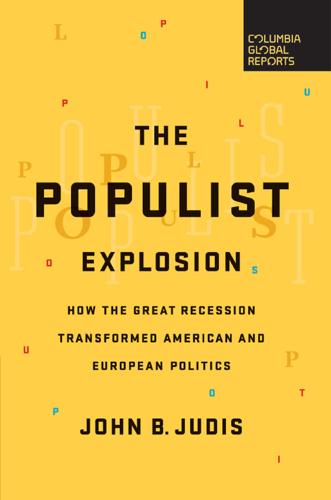
The Populist Explosion: How the Great Recession Transformed American and European Politics
by
John B. Judis
Published 11 Sep 2016
Tea Party candidates ran against both Senate Majority Leader Mitch McConnell and House Majority Leader Eric Cantor—and in the latter case, won. McConnell and Cantor’s sin lay in refusing to go all the way in repudiating even the bare rudiments of the neoliberal consensus between the parties and in failing to block even discussion of immigration reform. Cantor’s sin also lay in being too close to Wall Street and the Business Roundtable. In the primary, Tea Party candidate David Brat said, “All the investment banks in New York and D.C.—those guys should have gone to jail. Instead of going to jail, they went on Eric’s Rolodex, and they are sending him big checks.”

This Changes Everything: Capitalism vs. The Climate
by
Naomi Klein
Published 15 Sep 2014
Nick Cohen, “The Climate Change Deniers Have Won,” The Observer, March 22, 2014. 70. Philip Radford, “The Environmental Case for a Path to Citizenship,” Huffington Post, March 14, 2013; Anna Palmer and Darren Samuelsohn, “Sierra Club Backs Immigration Reform,” Politico, April 24, 2013; “Statement on Immigration Reform,” BlueGreen Alliance, http://www .bluegreenalliance.org; May Boeve, “Solidarity with the Immigration Reform Movement,” 350 .org, March 22, 2013, http://350.org. 71. Pamela Gossin, Encyclopedia of Literature and Science (Westport, CT: Greenwood, 2002), 208; William Blake, “And Did Those Feet in Ancient Time,” poem in The Complete Poetry and Prose of William Blake (Berkeley: University of California Press, 2008), 95. 72.
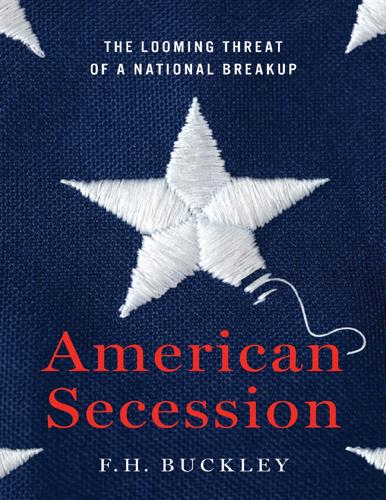
American Secession: The Looming Threat of a National Breakup
by
F. H. Buckley
Published 14 Jan 2020
And all of this is made worse by the absurd (and imaginary) requirement of a sixty-vote majority in the Senate to overcome a filibuster. What that’s given us is a constitutional crisis, our second since the Civil War. In 1861, our Constitution proved incapable of resolving the differences among us. Now too, on health care, immigration reform and so many of the issues that divide us, stasis reigns and necessity is met with impossibility. Our Constitution has been justly admired, but it was made for a citizenry very different from the angry Americans of today. And, as in 1861, that’s a recipe for secession. 2 WHEN SECESSION IS POLITICALLY CORRECT If our Constitution has failed us, if we’re so divided, secession wouldn’t seem far away.

The Rise and Fall of the Neoliberal Order: America and the World in the Free Market Era
by
Gary Gerstle
Published 14 Oct 2022
Latinos in particular believed that they had a friend in the White House, and they rewarded him by casting 40 percent of their votes for him in the 2004 election—a doubling of the percentage of Latino votes that Robert Dole had achieved for the Republican Party in 1996 and perhaps the highest ever, before or since, by a Republican presidential candidate. In his second term as president, Bush pushed hard for an immigration reform plan that included a robust path toward citizenship for the millions of undocumented Mexican immigrants living in the United States. Bush had confidence that he could attract sufficient numbers of diverse new Americans to the Republican Party to make the GOP America’s majority party for generations to come.42 Bush shared Thomas Friedman’s faith in the power of pluralism.
…
Biden’s initiatives included a campaign to vaccinate a large majority of adult Americans; a massive $1.9 trillion rescue plan to assist individuals and businesses in surviving the ongoing economic collapse that the pandemic had caused; even more massive plans to improve America’s physical and social infrastructure, at a combined cost of $4 to $5 trillion; major voting rights legislation to prevent states from interfering with the ability of people of color to cast their ballots; comprehensive immigration reform that would put millions of undocumented people on the road to citizenship and establish humanitarianism as a core principle of the nation’s immigration policy; and a variety of major efforts to root out structural racism from American life. Biden did not come close to matching Roosevelt’s record of passing fifteen major pieces of legislation in 100 days; no president has or likely ever will.

Days of Fire: Bush and Cheney in the White House
by
Peter Baker
Published 21 Oct 2013
With so much else going on, he was interested in one last chance to achieve a historic domestic initiative, not to poke at a hornet’s nest. He was in Rhode Island on June 28 giving a speech on Iraq at the Naval War College when Ted Kennedy called. His on-again, off-again partner asked Bush to press Harry Reid to keep trying on immigration reform. Bush was dumbfounded. If Reid would not listen to Kennedy, he surely would not listen to Bush. Within hours, immigration reform was dead as supporters failed to overcome a filibuster mounted by conservatives who opposed anything they thought smacked of amnesty for foreigners who broke the law to sneak into the country. Bush looked uncharacteristically dejected as he approached a lectern set up at the war college, fiddling with papers as he talked and avoiding the sort of winking eye contact he often made with reporters.
…
ex=1180843200&en=4a5b0fcb25dabda6&ei=5065&partner. 63 “to be quite frank about it”: Woodward, War Within, 360. 64 “My concern was whether”: David Petraeus, author interview. 65 “Respectfully, sir, I can”: Administration official, author interview. 66 “hadn’t read the bill”: George W. Bush, speech on immigration reform, Federal Law Enforcement Training Center, Glynco, Ga., May 29, 2007, http://georgewbush-whitehouse.archives.gov/news/releases/2007/05/20070529-7.html. 67 “He didn’t laugh”: Dan Bartlett, speech to U.S. Chamber of Commerce, September 13, 2007, http://www.leadingauthorities.com/speaker/dan-bartlett.aspx. 68 judge sentenced Scooter Libby: Judge Reggie B.
…
Health and Human Services Department, U.S., 9.1, 18.1 health care reform, 4.1, 16.1, epl.1 Heiden, Debbie Helal, Gamal Hennen, Scott Hennessey, Keith, 21.1, 34.1, 35.1 Heritage Foundation Hernandez, Israel, 2.1, 17.1, 37.1 Hertzberg, Hendrik Hezbollah, 10.1, 27.1, 27.2 Hill, Christopher, 21.1, 23.1, 28.1, 30.1, 31.1, 31.2, 31.3, 31.4, 32.1, 33.1, 33.2, 34.1, 34.2, 35.1 Hill, Fiona, 34.1, 34.2 Hillyer, Quin Hispanic Americans, 17.1, 21.1, 22.1 Hitler, Adolf Hobbs, David, 16.1, 16.2 Holbrooke, Richard, 21.1, 31.1, 31.2 Holland, Steve Holliday, Stuart Holocaust, 13.1, 13.2 Homeland Security Department, U.S., 11.1, 12.1, 13.1, 20.1, nts.1n Honoré, Rossel Hook, Brian Hoover, Herbert, 34.1, 35.1, 35.2, 37.1, nts.1n Horne, Alistair House Budget Committee House Intelligence Committee, 2.1, 9.1, 12.1 House of Representatives, U.S., 1.1, 1.2, 2.1, 2.2, 6.1, 6.2, 9.1, 10.1, 12.1, 12.2, 12.3, 12.4, 12.5, 12.6, 13.1, 15.1, 16.1, 21.1, 24.1, 24.2, 28.1, 29.1, 30.1, 30.2, 31.1, 31.2, 32.1, 33.1, 34.1, 35.1, 35.2, 35.3, 36.1, epl.1 House Republican Conference housing market, 24.1, 26.1, 27.1, 33.1, 34.1, 35.1, 35.2, 36.1, 37.1, epl.1 Houston, Sam Howard, Arlene, 8.1, 8.2, 8.3 Howard, George Hoyer, Steny Hubbard, Al, 21.1, 30.1 Hubbard, Glenn, 3.1, 11.1, 13.1, 13.2 Huckabee, Mike, 31.1, 33.1 Hughes, Karen, 2.1, 3.1, 3.2, 3.3, 3.4, 3.5, 4.1, 4.2, 5.1, 5.2, 6.1, 6.2, 6.3, 6.4, 6.5, 7.1, 7.2, 8.1, 8.2, 8.3, 8.4, 9.1, 10.1, 10.2, 11.1, 11.2, 12.1, 13.1, 13.2, 13.3, 13.4, 14.1, 14.2, 17.1, 18.1, 19.1, 19.2, 20.1, 21.1, 24.1, 25.1, 26.1, 27.1, 29.1, 31.1, 34.1, 35.1, 35.2, 37.1, epl.1 Hu Jintao, 25.1, 28.1, 33.1, 35.1 Hume, Brit Hundred Degree Club, 11.1, 27.1 Hunt, Al Hunt, Terence, 28.1, 28.2 Hurricane Gustav Hurricane Katrina, 23.1, 23.2, 23.3, 24.1, 27.1, 31.1, 35.1, 35.2, epl.1, epl.2, nts.1n–29n, nts.2n–49n Hussein, Qusay, 14.1, 16.1 Hussein, Saddam, prl.1, prl.2, 2.1, 5.1, 6.1, 7.1, 7.2, 8.1, 8.2, 8.3, 8.4, 8.5, 8.6, 9.1, 10.1, 10.2, 11.1, 11.2, 11.3, 12.1, 13.1, 14.1, 15.1, 15.2, 16.1, 16.2, 16.3, 17.1, 18.1, 18.2, 18.3, 18.4, 20.1, 21.1, 21.2, 24.1, 26.1, 26.2, 28.1, 30.1, 30.2, 30.3, 33.1, 35.1, 35.2, 36.1, epl.1, epl.2, epl.3, nts.1n Hussein, Uday, 14.1, 16.1 Hutchinson, Asa Hutchison, Kay Bailey Huxley, Aldous Ibrahim, Saad Eddin Ifill, Gwen Ignatius, David immigration reform, 2.1, 3.1, 20.1, 21.1, 21.2, 24.1, 31.1, 32.1, 32.2, 33.1, 37.1, epl.1, epl.2 independent voters, 5.1, 17.1, 17.2, 19.1, 28.1 India, 3.1, 5.1, 16.1 Information Security Oversight Office inspectors, weapons, 11.1, 12.1, 12.2, 12.3, 13.1, 13.2, 13.3, 13.4, 13.5, 13.6, 15.1, 17.1, 17.2 Insurrection Act (1807), 23.1, 23.2 Intelligence Identities Protection Act (1982) International Atomic Energy Agency (IAEA), 13.1, 32.1 International Committee of the Red Cross International Criminal Court (ICC) interrogations, 10.1, 11.1, 18.1, 18.2, 20.1, 22.1, 24.1, 28.1, 28.2, 28.3, 31.1, 33.1, 33.2, 35.1, 35.2, epl.1, epl.2, epl.3, epl.4 In the Heart of the Sea (Philbrick) Iowa primary, 3.1, 17.1, 35.1 Iran, prl.1, 2.1, 2.2, 7.1, 10.1, 10.2, 11.1, 11.2, 11.3, 14.1, 16.1, 17.1, 18.1, 18.2, 21.1, 24.1, 26.1, 27.1, 29.1, 30.1, 31.1, 32.1, 32.2, 33.1, 34.1, 35.1, 35.2, 37.1, epl.1, epl.2 Iran-contra scandal, 2.1, 17.1, epl.1 Iraq Body Count Iraq Governing Council, 16.1, 16.2, 16.3, 17.1 Iraq Interim Authority, 13.1, 14.1 Iraq Stabilization Group Iraq Study Group, 28.1, 29.1, 30.1 Iraq Summit, 26.1, 29.1 Iraq Survey Group Iraq War: Arab reaction to, 8.1, 11.1, 11.2, 11.3, 12.1, 13.1, 29.1, 33.1, 35.1, 36.1, epl.1, epl.2 casualties in, 2.1, 11.1, 13.1, 13.2, 22.1, 24.1, 26.1, 26.2, 27.1, 30.1, 31.1, nts.1n constitution established in, 15.1, 16.1, 16.2, 20.1, 21.1, 21.2, 22.1, 24.1, 26.1 insurgency in, 13.1, 14.1, 15.1, 16.1, 16.2, 16.3, 17.1, 20.1, 21.1, 21.2, 21.3, 23.1, 25.1, 26.1, 26.2, 26.3, 27.1, 28.1, 29.1, 29.2, 33.1, epl.1 interim government in, 10.1, 13.1, 14.1, 16.1, 20.1, 21.1, 25.1, 26.1 invasion in, prl.1, 8.1, 8.2, 9.1, 10.1, 11.1, 12.1, 13.1, 13.2, 13.3, 13.4, 13.5, 13.6, 13.7, 13.8, 14.1, 17.1, 17.2, 19.1, 21.1, 21.2, 26.1, 26.2, 27.1, 28.1, 28.2, 30.1, 30.2, 31.1, 33.1, 33.2 Iraqi elections (2005) held during, 15.1, 16.1, 20.1, 21.1, 21.2, 24.1, 24.2, 25.1, 25.2, 26.1, 30.1 occupation after, prl.1, 2.1, 5.1, 5.2, 5.3, 6.1, 7.1, 8.1, 8.2, 9.1, 10.1, 10.2, 10.3, 11.1, 11.2, 13.1, 16.1, 16.2, 17.1, 18.1, 20.1, 27.1, 35.1 reconstruction for, 13.1, 13.2, 13.3, 16.1, 24.1, 25.1 regime change in, 5.1, 6.1, 9.1, 10.1, 11.1, 11.2, 12.1, 12.2, 12.3, 13.1, 14.1, 14.2, 14.3, 21.1, 30.1 surge strategy for, 26.1, 26.2, 26.3, 27.1, 27.2, 27.3, 28.1, 28.2, 28.3, 28.4, 28.5, 28.6, 29.1, 29.2, 29.3, 31.1, 31.2, 31.3, 31.4, 32.1, 32.2, 32.3, 32.4, 33.1, 33.2, 34.1, 35.1, epl.1, epl.2, epl.3 troop deployment in, prl.1, prl.2, prl.3, 10.1, 11.1, 12.1, 13.1, 13.2, 13.3, 14.1, 14.2, 15.1, 16.1, 16.2, 17.1, 18.1, 20.1, 20.2, 24.1, 24.2, 25.1 troop withdrawal in, 20.1, 20.2, 21.1, 21.2, 22.1, 22.2, 24.1, 26.1, 27.1, 27.2, 28.1, 29.1, 29.2, 29.3, 29.4, 30.1, 31.1, 31.2, 31.3, 31.4, 32.1, 33.1, 32.2, 32.3, 33.2, 35.1, 36.1, nts.1n–51n UN resolutions on, 11.1, 11.2, 11.3, 12.1, 12.2, 12.3, 12.4, 13.1, 13.2, 13.3, 16.1, 18.1 “Iron Triangle,” 3.1, 17.1 Islam, 8.1, 8.2, 8.3, 8.4, 16.1, 21.1, epl.1, epl.2 Islamic Center of Washington Islamic extremists, 8.1, 16.1, 21.1 Islamic Movement of Uzbekistan Israel, 5.1, 6.1, 8.1, 11.1, 11.2, 11.3, 14.1, 14.2, 20.1, 24.1, 27.1, 27.2, 31.1, 31.2, 32.1, 33.1, 33.2, 33.3, 34.1, 35.1 Ivanov, Igor, 10.1, 26.1 Jaafari, Ibrahim al-, 21.1, 25.1, 25.2, 26.1 Jackson, Andrew, 5.1, epl.1 Jackson, Barry James, Marquis Janjaweed Japan, 11.1, 16.1, epl.1 Japanese-American internment camps Jarrett, Valerie Jefferson, Thomas Jefferson, William Jeffords, James, 6.1, 12.1 Jeffrey, James Jennings, Peter Jesus Christ, 2.1, 3.1, 11.1, nts.1n Jeter, Derek Jews, 8.1, 11.1, 13.1, 13.2 John Adams (McCullough) Johnson, Clay, 25.1, 37.1 Johnson, Lyndon B., 2.1, 3.1, 3.2, 6.1, 17.1, 23.1, 26.1, 27.1, 29.1, 30.1, 35.1, epl.1 Joints Chiefs of Staff, U.S., 2.1, 6.1, 8.1, 9.1, 10.1, 11.1, 13.1, 13.2, 29.1, 29.2, 30.1, 30.2, 31.1, 32.1 Jones, Edith Jones, Frederick, 16.1, 19.1, 21.1, 24.1, 26.1 Jordan, Vernon Joseph, Robert, 5.1, 14.1, 15.1, 16.1, 23.1, 31.1 JPMorgan Chase Jumblatt, Walid Jurgens, Thomas Justice Department, U.S., 9.1, 9.2, 10.1, 10.2, 11.1, 11.2, 15.1, 16.1, 17.1, 18.1, 20.1, 23.1, 24.1, 26.1, 32.1, 34.1, 35.1, 37.1, epl.1, nts.1n Kabul, 10.1, 10.2, 10.3, 10.4, 25.1, 28.1, 31.1, 36.1 Kagan, Frederick W., 26.1, 26.2, 29.1, 29.2, 29.3 Kagan, Robert Kandahar, 9.1, 10.1, 28.1 Kaplan, Joel, 11.1, 25.1, 28.1, 34.1, 34.2, 35.1, 36.1, 36.2, 37.1, 37.2, 37.3 Kaplan, Robert Kappes, Stephen Karami, Omar Karine A incident (2002) Karzai, Hamid, 10.1, 25.1, 28.1, 31.1, 36.1 Kasich, John Kass, Leon Kaufman, Ron, 3.1, 3.2 Kavanaugh, Ashley Kavanaugh, Brett Kay, David, 15.1, 17.1, 17.2, 18.1 Kazakhstan, 27.1, 31.1 Kean, Thomas H., 17.1, 18.1, 20.1 Keane, Jack, 28.1, 29.1, 30.1, 30.2, 31.1, 31.2, 32.1 Keating, Frank, 3.1, 8.1 Keegan, John Keene, David Keil, Richard, 7.1, 8.1, 28.1, 28.2 Kellems, Kevin, 9.1, 16.1 Keller, Bill, 24.1, 24.2, nts.1n Kelley, William, 22.1, 23.1, 23.2, 23.3 Kelly, James, 12.1, 17.1, 17.2 Kemp, Jack Kennedy, Anthony M.

Don't Burn This Book: Thinking for Yourself in an Age of Unreason
by
Dave Rubin
Published 27 Apr 2020
Meanwhile, Democrat senator Chuck Schumer of New York once said during a 2009 speech at Georgetown University: “The American people are fundamentally pro-legal immigration and anti-illegal immigration. We will only pass comprehensive reform when we recognize this fundamental concept. “First, illegal immigration is wrong. A primary goal of comprehensive immigration reform must be to dramatically curtail future illegal immigration.” Then, nervous Nancy Pelosi added: “We all agree we need to secure our borders, while honoring our values.” Even Democrat senator Dianne Feinstein of California criticized the flood of migrants coming from Mexico. Speaking during a visit to the border in the early 1990s, she said: “It’s a competition for space.
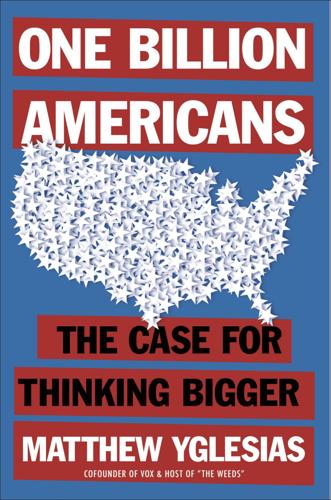
One Billion Americans: The Case for Thinking Bigger
by
Matthew Yglesias
Published 14 Sep 2020
And, of course, there is no magic wand at hand. Instead, the current policy approach is to immiserate and terrify millions of people while laboriously deporting a few hundred thousand of them each year at great expense. This is a cruel and pointless waste of resources. A far better approach, as embodied in the immigration reform legislation that passed the senate in 2013 only to die due to the opposition of House Republicans, is to give the vast majority of these people the opportunity to come forward, pay a fine, and get a visa. This would be constructive for the American economy as newly legalized workers could get bank accounts and loans, save money and start businesses, and generally increase their level of contribution to the country.

The Line Becomes a River: Dispatches From the Border
by
Francisco Cantú
Published 1 Jan 2018
Basically, that means we would present to a judge all the compelling reasons that José should still be granted a stay of removal despite his recent entry. The goal here is to get José out of detention and, essentially, to buy time with the appeals process and hope for better policy and eventual immigration reform down the line. José would still have no work permit, he’d still be living in the shadows, but he’d be protected, he could remain there safely, if that makes any sense. Elizabeth shifted her gaze around the room, looking in turn at Diane, Lupe, the pastor, and me. So, she began again, here’s what I will need from all of you: From you, Lupe, any and all documentation that establishes how long José has lived and worked in the States.
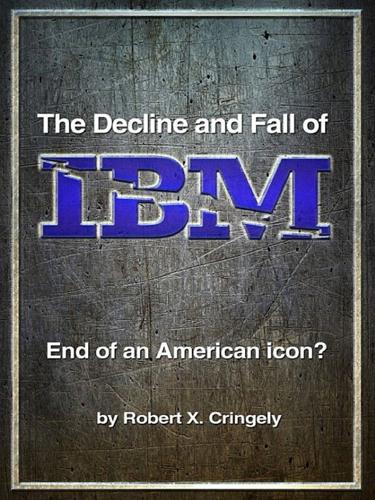
The Decline and Fall of IBM: End of an American Icon?
by
Robert X. Cringely
Published 1 Jun 2014
In an election year and with the economy crumbling this could have been a powerful issue, if only politicians had taken the time to understand it. This went way beyond IBM. H-1B visa abuse is rampant in high tech where it is used mainly to keep down labor costs – the exact opposite of the stated intent of both the enabling legislation and current political propaganda around proposed immigration reform. There is no high-tech labor shortage in America no matter what industry says. But IBM was, and is, the poster child for bad management. IBM's leadership appeared transfixed on two things—selling and cutting costs. They were pushing their sales force very hard, and squeezing commissions at the same time.
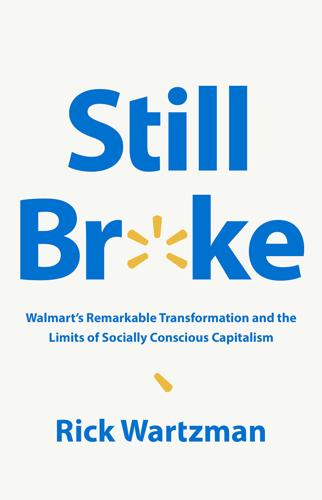
Still Broke: Walmart's Remarkable Transformation and the Limits of Socially Conscious Capitalism
by
Rick Wartzman
Published 15 Nov 2022
“I can remember a couple of times coming home from these trips and feeling, ‘Yeah, we might have something here,’” Adams said. But the colloquy petered out. Walmart had come a long way on a host of issues, including the environment and universal healthcare. It had lobbied for an extension of the Voting Rights Act and, along with Reverend Al Sharpton, for passage of comprehensive immigration reform. But where it had the most direct control—deciding how much to pay its workers—it hadn’t moved an inch. Six months before he gave his big speech following Hurricane Katrina, Lee Scott had given a sense of why. “Some well-meaning critics contend that Walmart should be setting the pace for wages and benefits for the entire economy, just as a unionized General Motors was said to have done in the postwar period, helping usher in the great American middle class that this country is so proud of,” he said.
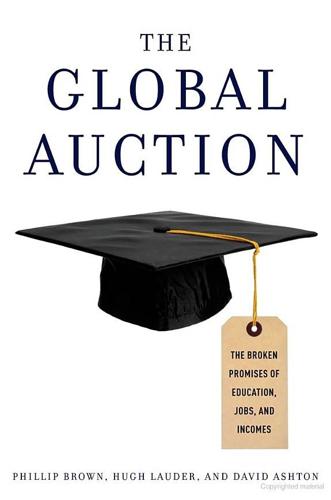
The Global Auction: The Broken Promises of Education, Jobs, and Incomes
by
Phillip Brown
,
Hugh Lauder
and
David Ashton
Published 3 Nov 2010
To be the best you have to work with the best.”12 And to work with the best justified radical changes in national policy, especially the reform of immigration policies that opened borders to the highly skilled and offered attractive tax benefits to make a country more competitive and attractive to top-level professional and managerial workers. Immigration reform in the global war for talent involves the market-based liberalization of national borders, removing barriers to the entry of foreign talent. Although states have long used market criteria to shape immigration policy, the trend across OECD nations over the past two decades has seen a rise in immigration levels overall, with a growing bias toward the highly skilled.13 The scale of high-skill migration can be shown in some of the available evidence.14 Globally, high-skill migration increased at a rate two and a half times faster than low-skill migration between 1990 and 2000.
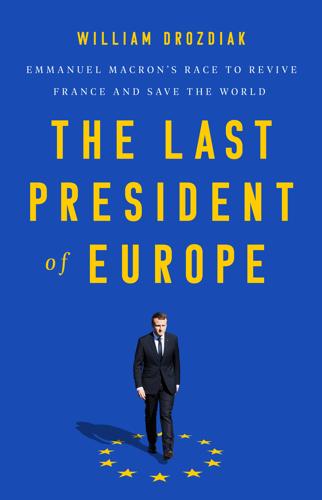
The Last President of Europe: Emmanuel Macron's Race to Revive France and Save the World
by
William Drozdiak
Published 27 Apr 2020
It was the symbolic breakthrough that Macron had been seeking since his Sorbonne speech, even if it fell far short of his own ambitious goals for Europe.17 Yet barely ten days later, the Meseberg accord began to fall apart. At a European Union summit meeting, other leaders questioned the rationale and timing of French-German proposals for a Eurozone budget and immigration reform. With nationalist sentiment rising across Europe, several leaders spoke out against taking any steps that would antagonize voters opposed to further moves toward an integrated Europe. “The people just will not accept these ideas; just look at how they are voting,” said Lars Løkke Rasmussen, Denmark’s liberal prime minister, whose government depended on support from the hard-right Danish People’s Party to stay in power.
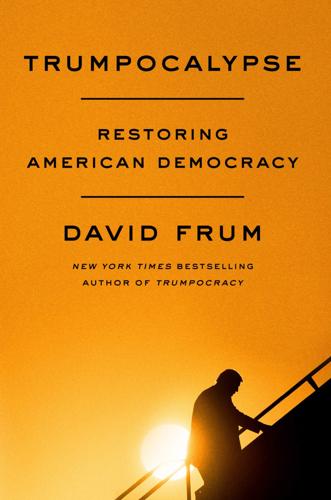
Trumpocalypse: Restoring American Democracy
by
David Frum
Published 25 May 2020
As recently as 2006, then-governor Mitt Romney believed he could win the Republican nomination and the US presidency by championing universal health insurance in his then-state of Massachusetts. As recently as 2007, future Democratic presidential candidate Senator Bernie Sanders opposed the Kennedy-McCain immigration reform as too likely to undercut American workers’ wages. The parties hardened their positions on these core issues only after 2008, a sign of the post-recession era’s ultra-polarization. The consequence has been the frustration of both parties’ highest hopes. The Democrats did enact the Affordable Care Act in 2010, but they have not been able to protect it from Republican sabotage at the federal and state level.

I Hate the Internet: A Novel
by
Jarett Kobek
Published 3 Nov 2016
Fuck your working class, too, for being so deluded by the shiny baubles of consumerism that their every protest only comes too late, when the die is cast and the deed is done! Fuck everyone who thought that the newest business would improve the neighborhood only to discover two years later that they couldn’t afford their rent! “San Francisco, your future is a vast ethnic ghetto! The Mark Zuckerbergs of the world are working on immigration reform. They don’t give a fuck about Latinos but they love using Latinos as a disguise for their agenda! Their goal is to replace their existing workforce with workers from Asian countries. Because tech workers from Asia will work for one-third the salary! All the low level cogs in the tech industry are so fucked up their own asses that while they were hosting public mournings for net neutrality, they failed to get anything like a political education!
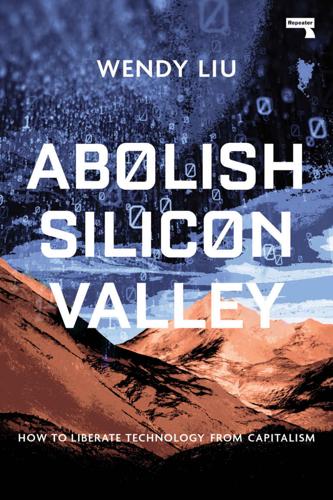
Abolish Silicon Valley: How to Liberate Technology From Capitalism
by
Wendy Liu
Published 22 Mar 2020
For years, our expectation had been to move to the US eventually, simply because that was where all the money was. At first, the San Francisco Bay Area had been our target; after spending a summer in NYC, we had switched our sights to the East Coast. But we had been counting on Hillary Clinton becoming President, on the grounds that she would be more likely to pass immigration reform that would make it easier for people like us to move. Never could we have imagined a President who would turn the clock back the other way, making an already restrictive immigration regime even more nativist. My longtime dream of moving to the US slipped further out of reach. And in the meantime, I was watching to see how the tech industry would respond to this new administration.

Migrant City: A New History of London
by
Panikos Panayi
Published 4 Feb 2020
The first group of any significance was the Society for the Suppression of Destitute Aliens, founded in 1886 and partly financed by the antisemitic ideologue Arnold White, but it had little impact. There then followed the Association for Preventing the Immigration of Destitute Aliens, which actually counted members of both Houses of Parliament in its ranks but did not attract ordinary East Enders and also folded. Another group called the Immigration Reform Association came into existence in 1903 but had limited success. The most significant anti-Jewish immigrant grouping before the First World War was the British Brothers’ League, established in 1901 under the leadership of Major William Evans-Gordon, Conservative MP for Stepney and a dominant political voice in the campaign which led to the Aliens Act of 1905.
…
J., (i) Hamburg, (i), (ii), (iii), (iv), (v) Hammersmith, (i), (ii), (iii), (iv), (v), (vi), (vii) Hampstead, (i), (ii), (iii), (iv), (v), (vi), (vii), (viii) Hamza, Abu, (i) Handel, Georg Friedrich, (i), (ii), (iii), (iv), (v), (vi), (vii), (viii) Music for the Royal Fireworks, (i) Water Music, (i) Hannah, David, (i) Hanover, (i), (ii), (iii) Hanseatic League, (i), (ii), (iii), (iv) Steelyard, (i) Harden’s London Restaurants, (i) Haringey, (i), (ii), (iii), (iv), (v), (vi) Harmoniser Gospel Group, (i) Harrison, Ivor, (i) Harrison, Lesley, (i) Harrogate, (i) Harrow, (i), (ii), (iii), (iv) Harsefeld, (i) Hartman, Anthony, (i) Havering, (i), (ii), (iii) Haydn, Joseph, (i), (ii), (iii), (iv), (v), (vi) Hayes, (i), (ii) Hazard, Eden, (i) Health Exhibition of 1884, (i) Heathrow Airport, (i), (ii) Hendon, (i), (ii), (iii), (iv), (v), (vi) Henry, Thierry, (i), (ii), (iii) Henry Wood Promenade Concerts, (i), (ii) Heron, Gil, (i) Herriot-Watt University, (i) Herschel, Georg, (i) Heymann, Bernhard, (i) Higgs and Hill, (i) Highbury, (i) Highgate, (i), (ii) Hitler, Adolf, (i), (ii) hockey, (i) Holborn, (i), (ii), (iii), (iv), (v), (vi), (vii) Holland, see Netherlands Holland Park, (i) Holloway, (i), (ii) homeless migrants, (i) Home Rule Confederation, (i) Honeghan, Lloyd, (i) Hong Kong, (i), (ii), (iii), (iv) Hope, Maurice, (i) Hornsey, (i), (ii), (iii), (iv) Hôtel du Lac, (i) Hotel Review, (i) Houlihan, Michael, (i) Hounslow, (i), (ii), (iii), (iv) House of Commons, (i), (ii) Howe, Darcus, (i) Hoxton, (i) Huddersfield Town, (i) Hughton, Chris, (i) Hull, (i), (ii) Hungarians, in London, (i), (ii), (iii), (iv), (v) Hungary, (i), (ii) Hurst, Geoff, (i) Hussain, Ed, (i) Hutchinson, Leslie, (i), (ii) Huth, Frederick, (i), (ii) Hyams, Harry, (i) Hyde Park, (i), (ii), (iii) Hyman, Nathan, (i) Immigration Reform Association, (i) Imperial Fascist League, (i) In Dahomey, (i) India, (i), (ii), (iii), (iv), (v), (vi), (vii), (viii), (ix), (x), (xi), (xii), (xiii), (xiv), (xv) Indian National Congress, (i) Indians in London, (i), (ii), (iii), (iv), (v), (vi), (vii), (viii), (ix), (x), (xi), (xii), (xiii), (xiv), (xv), (xvi), (xvii), (xviii), (xix), (xx), (xxi), (xxii), (xxiii), (xxiv), (xxv), (xxvi), (xxvii), (xxviii), (xxix) All-India Muslim League, (i) Caribbean, (i) Goans, (i) Gujuratis, (i), (ii), (iii), (iv), (v), (vi), (vii), (viii), (ix), (x) India House, (i) India League, (i) London Indian Society, (i) numbers, (i), (ii), (iii), (iv) occupations, (i) businessmen, (i), (ii), (iii) factory workers, (i) homeworkers, (i) musicians, (i), (ii) princes, (i) restaurateurs, (i) sailors, (i), (ii) shopkeepers, (i), (ii), (iii) students, (i), (ii), (iii) teachers, (i) writers, (i) Patidars, (i) Punjabis, (i), (ii), (iii), (iv), (v) racism against, (i) religion, (i), (ii) Hinduism, (i), (ii), (iii), (iv), (v), (vi), (vii) Swaminarayan Hindu Mission, (i) see also Bangladeshis in London; Pakistanis in London; Sikhs in London; South Asians in London inter-ethnic friendship, (i), (ii), (iii), (iv), (v), (vi) intermarriage, (i), (ii), (iii), (iv), (v), (vi), (vii), (viii), (ix), (x) International Association, (i) International Finance Centre, (i) Ipswich, (i) Iranians in London, (i) Iraq, (i), (ii) Iraqi Kurds in London, (i) Ireland, (i), (ii), (iii), (iv), (v), (vi), (vii), (viii), (ix), (x), (xi), (xii), (xiii), (xiv) Famine, (i), (ii) Good Friday Agreement, (i) Sinn Fein, (i) Ireland in London, (i) Irish Folk Song Society of London, (i) Irish in London, (i), (ii), (iii), (iv), (v), (vi), (vii), (viii), (ix), (x), (xi), (xii), (xiii), (xiv), (xv), (xvi), (xvii), (xviii), (xix), (xx), (xxi), (xxii), (xxiii), (xxiv), (xxv), (xxvi), (xxvii), (xxviii), (xxix), (xxx), (xxxi), (xxxii), (xxxiii), (xxxiv), (xxxv), (xxxvi), (xxxvii), (xxxviii), (xxxix), (xl), (xli), (xlii), (xliii), (xliv), (xlv), (xlvi), (xlvii), (xlviii), (xlix), (l), (li), (lii), (liii), (liv), (lv), (lvi), (lvii), (lviii) distribution of, (i), (ii), (iii), (iv), (v), (vi), (vii), (viii), (ix) hostility towards, (i), (ii), (iii), (iv), (v), (vi), (vii), (viii), (ix), (x) marriage, (i) numbers, (i), (ii), (iii), (iv), (v), (vi) occupations of, (i), (ii), (iii), (iv) actors, (i) bankers, (i) beggars, (i) boxers, (i), (ii) builders, (i), (ii), (iii), (iv), (v) bus drivers, (i) businessmen, (i), (ii) chairmen, (i), (ii) clerical workers, (i) coal-heavers, (i) domestic servants, (i), (ii), (iii) dramatists, (i) factory workers, (i), (ii) footballers, (i), (ii), (iii), (iv) hawkers, (i), (ii), (iii), (iv), (v), (vi), (vii), (viii), (ix) labourers, (i) lawyers, (i), (ii) merchants, (i) musicians, (i), (ii), (iii) nurses, (i), (ii) porters, (i) silk-weavers, (i) writers, (i) religion, (i), (ii), (iii), (iv), (v) see also Roman Catholicism Irish National League, (i) Irish Republican Army, (i), (ii), (iii) Irish Republican Brotherhood, (i) Iskra, (i) Islam, Haji Shirajul, (i) Islam in London, (i), (ii), (iii), (iv), (v), (vi), (vii), (viii), (ix) Central Islamic Society, (i) Muslim League, (i) Pan-Islamic Society, (i) Ramadan, (i) see also Bangladeshis in London, Pakistanis in London; places of worship; religion Islamic schools, (i) Islamists in London, (i), (ii), (iii) Island Records, (i) Isle of Dogs, (i) Islington, (i), (ii), (iii), (iv), (v), (vi) Israel, Menasseh ben, (i), (ii), (iii) Issacs, Godfrey, (i) Issacs, Sir Rufus, (i) Istanbul, (i) Italian Benevolent Society, (i) Italians in London, (i), (ii), (iii), (iv), (v), (vi), (vii), (viii), (ix), (x), (xi), (xii), (xiii), (xiv), (xv), (xvi), (xvii), (xviii), (xix), (xx), (xxi), (xxii), (xxiii), (xxiv), (xxv), (xxvi), (xxvii), (xxviii), (xxix), (xxx), (xxxi), (xxxii), (xxxiii), (xxxiv), (xxxv), (xxxvi), (xxxvii), (xxxviii), (xxxix), (xl), (xli), (xlii), (xliii), (xliv), (xlv), (xlvi), (xlvii), (xlviii), (xlix), (l), (li), (lii) churches, (i) distribution, (i), (ii) hostility towards, (i), (ii), (iii) Lombards, (i), (ii) numbers, (i), (ii) occupations, (i), (ii), (iii), (iv) asphalt layers, (i) bankers, (i) cooks, (i), (ii), (iii) Italian Club of Culinary Art, (i) Italian Culinary Society, (i) craftsmen, (i), (ii) fish and chip shop owners, (i) food provisioners, (i), (ii), (iii) hawkers, (i), (ii) ice cream sellers, (i), (ii) industrialists, (i) miners, (i) musicians, (i), (ii), (iii), (iv), (v), (vi), (vii), (viii), (ix), (x), (xi), (xii), (xiii), (xiv), (xv), (xvi) prostitutes, (i) scholars, (i) statue makers, (i) waiters, (i), (ii), (iii) religion, (i), (ii), (iii), (iv) Italian Opera, (i), (ii), (iii) Italy, (i), (ii), (iii), (iv), (v), (vi), (vii), (viii), (ix), (x), (xi), (xii), (xiii) ITV, (i) The Big Match, (i) Love Thy Neighbour, (i), (ii) Ivory Coast, (i) Jacobs, Harry, (i) Jamaica, (i), (ii), (iii), (iv), (v) Jamaicans in London, (i), (ii), (iii), (iv), (v), (vi), (vii), (viii), (ix), (x), (xi), (xii), (xiii), (xiv), (xv) numbers, (i) see also Barbadians in London; black people in London; Trinidadians in London; West Indians in London James, C.

Four Battlegrounds
by
Paul Scharre
Published 18 Jan 2023
The biggest barrier today is America’s own immigration policies. In a survey of top machine learning researchers residing in the United States, nearly 70 percent said visa and immigration problems were an obstacle to recruiting foreign talent. The National Security Commission on AI called for expanding high-skilled immigration, arguing “immigration reform is a national security imperative.” In early 2022, the Biden administration announced a series of measures to ease obstacles to international science, technology, engineering, and mathematics (STEM) talent coming to the United States. These included increasing foreign exchange programs, expanding the availability of visas, and updating immigration policies for those with advanced degrees.
…
Matthew Olsen, remarks at George Mason University, Arlington, VA, February 23, 2022, https://www.justice.gov/opa/speech/assistant-attorney-general-matthew-olsen-delivers-remarks-countering-nation-state-threats; Josh Gerstein, “DOJ Shuts Down China-Focused Anti-Espionage Program,” Politico, February 23, 2022, https://www.politico.com/news/2022/02/23/doj-shuts-down-china-focused-anti-espionage-program-00011065. 33“The United States is in a global competition for scarce AI talent”: National Security Commission on Artificial Intelligence, Final Report (n.d.), 173, https://www.nscai.gov/wp-content/uploads/2021/03/Full-Report-Digital-1.pdf. 33a new National Defense Education Act: National Security Commission on Artificial Intelligence, Final Report, 175. 33home-grown talent: Zwetsloot, China’s Approach to Tech Talent Competition. See also Zwetsloot, Strengthening the U.S. AI Workforce. 33nearly 70 percent said visa and immigration problems were an obstacle: Zwetsloot et al., Skilled and Mobile. 33“immigration reform”: National Security Commission on Artificial Intelligence, Final Report, 175. 33international . . . (STEM) talent: The White House, “Biden-Harris Administration Actions to Attract STEM Talent and Strengthen our Economy and Competitiveness,” fact sheet, January 21, 2022, https://www.whitehouse.gov/briefing-room/statements-releases/2022/01/21/fact-sheet-biden-harris-administration-actions-to-attract-stem-talent-and-strengthen-our-economy-and-competitiveness/. 34recruit talented scientists and engineers from abroad: For recommendations on additional steps to increase high-skilled immigration, see National Security Commission on Artificial Intelligence, Final Report, 175–179. 5.
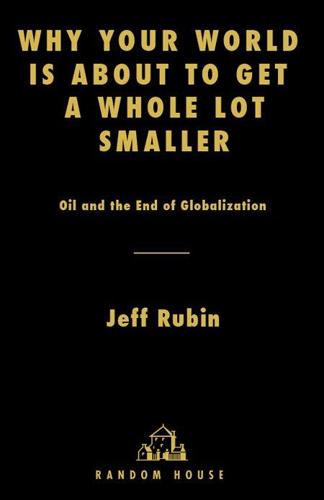
Why Your World Is About to Get a Whole Lot Smaller: Oil and the End of Globalization
by
Jeff Rubin
Published 19 May 2009
p. 241: Figures for the percentage of GDP in the Philippines derived from overseas remittances comes from the Global Strategy Institute (forums.csis.org/gsionline/?p=565). p. 242: The organization calling itself America’s Leadership Team for Long Range Population-Immigration-Resource Planning is an umbrella group composed of the American Immigration Control Foundation, Californians for Population Stabilization, the Federation for American Immigration Reform and NumbersUSA. One of their advertisements makes the case that “America has problems—huge problems,” then goes on to say “all of these problems are caused by a large and fast-growing population.” p. 247: The figure of $50 per ton to reduce emissions comes from a report by McKinsey & Company called “Reducing US Greenhouse Gas Emissions: How Much and at What Cost?”
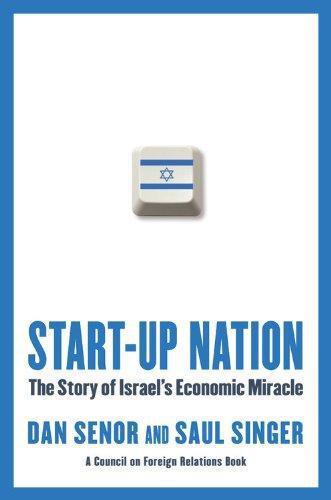
Start-Up Nation: The Story of Israel's Economic Miracle
by
Dan Senor
and
Saul Singer
Published 3 Nov 2009
Current and former leaders from three in particular opened their doors to us in Israel and in Silicon Valley and provided lots of access: thank you to Google’s Eric Schmidt, David Krane, Yossi Mattias, Andrew McLaughlin, and Yoelle Maarek; Intel’s Shmuel Eden and David Perlmutter; and Cisco’s Michael Laor and Yoav Samet. Leon Wieseltier provided us with wise counsel on the relationship between Jewish history and the modern Israeli ethos. Stuart Anderson, a former colleague of Dan’s from the Senate Subcommittee on Immigration, has always been a source of rich analysis on immigration reform. He shared important research on the subject for this book. We are grateful to the president of Israel, Shimon Peres, who gave us half a day in his office. He not only gave us his unique perspective as a central player throughout the entire span of Israel’s history, but is still, at age eighty-five, in high office and busy working to launch whole new industries.
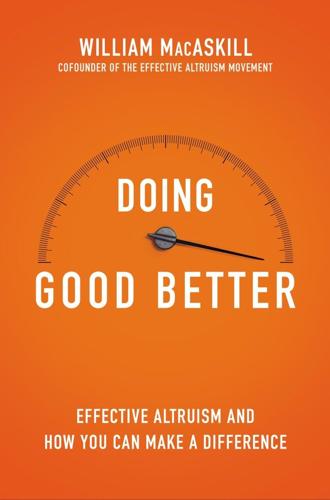
Doing Good Better: How Effective Altruism Can Help You Make a Difference
by
William MacAskill
Published 27 Jul 2015
ImmigrationWorks (accepts donations) organizes, represents, and advocates on behalf of small-business owners who would benefit from being able to hire lower-skill migrant workers more easily, with the aim of “bringing America’s annual legal intake of foreign workers more realistically into line with the country’s labor needs.” The Center for Global Development (accepts donations) conducts policy-relevant research and policy analysis on topics relevant to improving the lives of the global poor, including on immigration reform, then makes recommendations to policy makers. Factory farming What’s the problem? Fifty billion animals are raised and slaughtered in factory farms every year. Relatively small changes to farming practices could substantially improve these animals’ welfare. Raising animals for consumption also produces substantial greenhouse gas emissions.
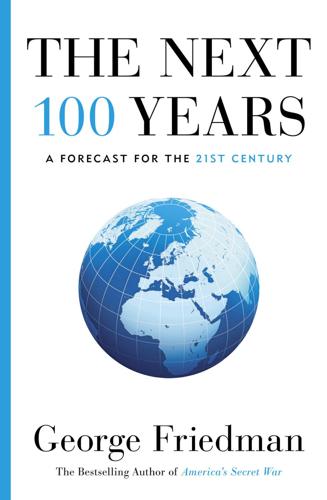
The Next 100 Years: A Forecast for the 21st Century
by
George Friedman
Published 30 Jul 2008
The United States will have to offer immigrants a range of competitive benefits, from highly streamlined green-card processes to specialized visas catering to the needs and wishes of the immigrant workforce and quite possibly to bonuses—paid directly through the government or through firms that are hiring them—along with guarantees of employment. And immigrants will certainly comparison shop. This process will result in a substantial increase in the power of the federal government. Since 1980 we have seen a steady erosion of government power. The immigration reform that will be needed around 2030 will require direct government management, however. If private businesses manage the process, the federal government at least will be enforcing guarantees to make certain immigrants are not defrauded and that the companies can deliver on their promises. Otherwise, unemployed immigrants will become a burden.

How Democracies Die
by
Steven Levitsky
and
Daniel Ziblatt
Published 16 Jan 2018
Obama began to use executive authority in a way he might not have expected to before coming into office. In 2010, in the face of Congress’s failure to pass a new energy bill, he issued an “executive memorandum” instructing government agencies to raise fuel efficiency standards for all cars. In 2012, in response to Congress’s inability to pass immigration reform, he announced an executive action to cease deportation of illegal immigrants who came to the United States before the age of sixteen and were either in school or were high school graduates or military veterans. In 2015, President Obama responded to Congress’s refusal to pass legislation to combat climate change by issuing an executive order to all federal agencies to reduce greenhouse gas emissions and use more renewable energy.

Live Work Work Work Die: A Journey Into the Savage Heart of Silicon Valley
by
Corey Pein
Published 23 Apr 2018
When he was called to join the panel, one loyal aide blasted the fifteen-year-old hip-hop hit “Who Let the Dogs Out” from a smartphone speaker while the rest of Schulte’s pack whooped and cheered. A dutiful subordinate posted Schulte’s photo to Twitter. He later added the approving caption “Thought leaderin’.” “My job, and our job at Fwd.us, is to pass comprehensive immigration reform,” Schulte began. The sole panelist who carried his alcoholic drink onstage, he punctuated his points by tilting a beer bottle toward the audience. “We’re going to have a system where more high-skilled immigrants can come to this country,” he said. Tilt. “We are not going to deport eleven and a half million people,” he went on.
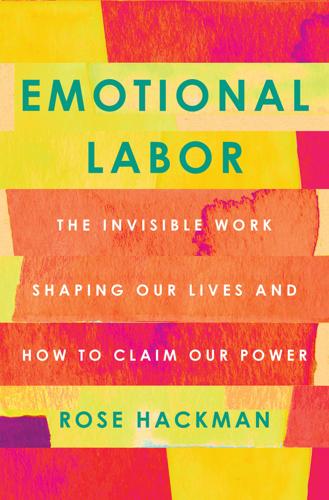
Emotional Labor: The Invisible Work Shaping Our Lives and How to Claim Our Power
by
Rose Hackman
Published 27 Mar 2023
This was just months before the US presidential elections, during which time soon-to-be-elected Donald Trump, a former pageant mogul himself, reiterated plans for the building of a physical wall on the country’s southern border with Mexico and laid out more explicit plans for a so-called Muslim ban. Ari led voter registration drives and advocated for immigration reform, but people seemed more interested in the spectacle of her theoretical downfall. “Looking back at it now, I was very naïve, but I thought, I am going to make a difference, I am going to be heard. It’s going to be great.” In one video clip,22 she tells her male interviewer that knowing she is the cause for people engaging in discussions about pageantry, beauty standards, and immigration has made her “quite thankful.”
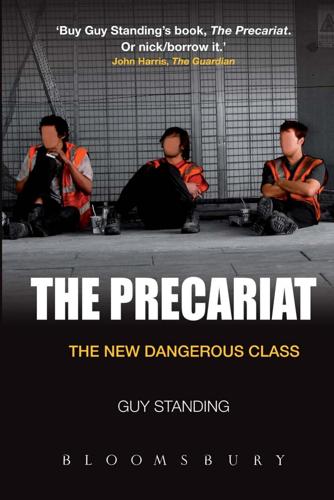
The Precariat: The New Dangerous Class
by
Guy Standing
Published 27 Feb 2011
A., Jackson, M., Sherbin, L., Shiller, P., Sosnovich, E. and Sumberg, K. (2009), Bookend Generations: Leveraging Talent and Finding Common Ground, New York: Center for Work-Life Policy. Hinojosa-Ojeda, R. (2010), Raising the Floor for American Workers: The Economic Benefits of Comprehensive Immigration Reform, Washington, DC: Center for American Progress, Immigration Policy Center. Hinsliff, G. (2009), ‘Home Office to Unveil Points System for Immigrants Seeking British Citizenship’, Observer, 2 August, p. 4. Hobsbawm, E. J. (1959), Primitive Rebels: Studies in Archaic Forms of Social Movement in the 19th and 20th Centuries, Manchester: Manchester University Press.
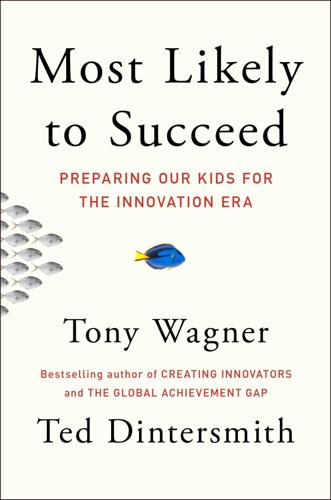
Most Likely to Succeed: Preparing Our Kids for the Innovation Era
by
Tony Wagner
and
Ted Dintersmith
Published 17 Aug 2015
With a lifetime approval score of over 95 percent from the American Conservative Union, and with enormous clout for his district, Cantor appeared to have the safest seat in the House, in his conservative district.14 Yet despite a 26-to-1 advantage in campaign funds,15 Cantor lost in a primary to an unknown extreme-right candidate who attacked him for a couple of statements hinting at the possibility of modest immigration reform. This unseating never would have happened in the past. The complexity of today’s civil society places extremely high demands on citizens. If our democracy is to hold together with any hope or prospect for pragmatic alignment of interests and actions, we need a citizenry with a strong base of essential skills: critical analysis, communication, collaboration, and creative problem-solving.
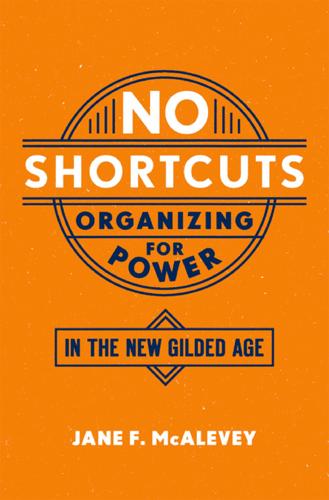
No Shortcuts: Organizing for Power in the New Gilded Age
by
Jane F. McAlevey
Published 14 Apr 2016
The high participation that characterizes MRNY’s high-touch model separates it from more typical social-movement organizations, in which “membership” is nothing more than subscribership. MRNY’s ability to mobilize its members in civic actions is palpable at legislative hearings; on street corners and in marches; in its many press conferences; and in the forty-two buses they sent to Washington, D.C., to demand immigration reform. Underlying MRNY’s work is a commitment to its high-participation, high-touch organization-building model. Its wide array of weekly and biweekly meetings create meaningful points of entry and leadership development for its thousands of members. Committee meetings share commonalities: Members cook and serve dinner at the office near each meeting’s end while debriefing, discussing recent actions, and planning for upcoming ones.
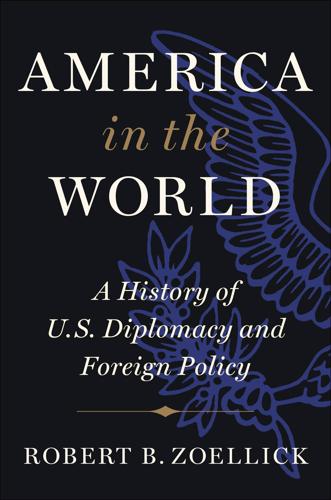
America in the World: A History of U.S. Diplomacy and Foreign Policy
by
Robert B. Zoellick
Published 3 Aug 2020
In his second term, even with wartime preoccupations, Bush launched a Security and Prosperity Partnership of North America to connect local governments and business groups to national projects for transportation, financial services, the environment, and intelligence sharing. The president also assisted trade, development, and democracy in Central America, in part through cooperation with Mexico. Bush pressed Congress to pass immigration reform—to no avail and with disruptive long-term consequences.2 Barack Obama never recognized the strategic potential of North America, although he maintained neighborly ties. NAFTA had become politically unpopular in the president’s party, so the administration would not mention NAFTA and gave up making the public case; it is hard to win a debate in which only one side argues.
…
Brown, a keen student of economic history, recalled that the London Economic Conference of 1933, which Cordell Hull attended, had failed dismally, contributing to the breakdown of the international economy in the Great Depression. 2. In his memoir, President Bush notes that he should have made immigration reform the first major initiative of his second term, instead of Social Security. George W. Bush, Decision Points (New York: Crown Publishers, 2010), 306. 3. Bush, Decision Points, 306. 4. My challenge for China—and for U.S. diplomacy—was to move beyond questions of Chinese participation to encouraging Beijing’s behavior—attention to norms, not just forms.

Top Secret America: The Rise of the New American Security State
by
Dana Priest
and
William M. Arkin
Published 5 Sep 2011
Lacking any hard leads, the Washington Regional Threat and Analysis Center, a place where the governments of Maryland, Virginia, and the District of Columbia shared and analyzed threat information, had issued a daily summary that warned against just about everything imaginable. The warnings included a log of completely legal demonstrations; authorities believed such activities could provide cover for terrorist or other criminal action. Events to keep an eye on, the center noted, were a protest against Israeli settlements in Gaza, a demonstration in support of immigration reform, another sponsored by Veterans for Peace, an antiwar “Shoe Throwing at the White House,” and an anti-abortion March for Life rally. No one was particularly concerned that these were lawful—keeping track of such groups had become a habit of law enforcement agencies across the country. Several other reports of out-of-town crimes were also in circulation, including a machine gun heist in rural Pennsylvania and the discovery in Maine of radioactive materials and components for a radiological dispersal device in the house of a suspected member of a white supremacist group.
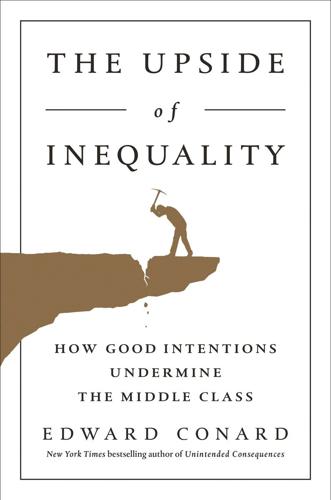
The Upside of Inequality
by
Edward Conard
Published 1 Sep 2016
Vivek Wadhwa, Richard Freeman, and Ben Rissing, “Education and Tech Entrepreneurship,” Ewing Marion Kaufmann Foundation (2008), http://www.kauffman.org/what-we-do/research/2009/04/education-and-tech-entrepreneurship. 54. Charles I. Jones, “Sources of U.S. Economic Growth in a World of Ideas,” American Economic Review 92, no. 1 (2002), http://web.stanford.edu/~chadj/SourcesAER2002.pdf. 55. Giovanni Peri, “The Economic Windfall of Immigration Reform,” Wall Street Journal, February 12, 2013, http://www.wsj.com/articles/SB10001424127887324196204578297850464590498. 56. Scott Anderson, “Immigrants and Billion Dollar Startups,” National Foundation for American Policy, March 2016, http://nfap.com/wp-content/uploads/2016/03/Immigrants-and-Billion-Dollar-Startups.NFAP-Policy-Brief.March-2016.pdf. 57.
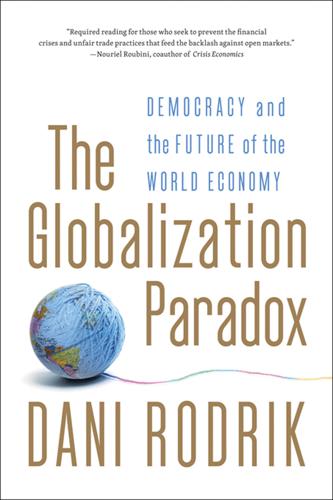
The Globalization Paradox: Democracy and the Future of the World Economy
by
Dani Rodrik
Published 23 Dec 2010
This invalidates any claim of unfair competition on the basis of a non-level playing field. If either of these assertions turns out to be invalid, opponents would then have a stronger case. Whether a sufficiently broad domestic political consensus on temporary work visas can be reached in the advanced nations remains to be seen. The Comprehensive Immigration Reform Act of 2006 contained provisions that would have expanded a guest worker scheme in the United States, but the bill died an early death in Congress. An enlarged foreign worker presence clearly garners little enthusiasm in the United States or in Europe. In light of this, it would be easy to write such programs off as politically unrealistic.
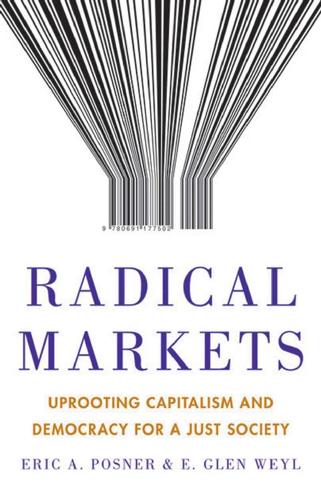
Radical Markets: Uprooting Capitalism and Democracy for a Just Society
by
Eric Posner
and
E. Weyl
Published 14 May 2018
While thinking about how landowners might vote on whether to accept a developer’s offer without disadvantaging the few owners who really want to stay in their homes, he stumbled on a solution in 2009 that allows the Vickrey-Clarke-Groves idea to apply to practical voting.34 To see how it works, let us return to the example with which we began this chapter. Suppose that Japan holds periodic referenda on important issues, like gun control or immigration reform. Every citizen is given a budget of “voice credits” every year, which he may spend on referenda that year or save for the future, as Kentaro did. To convert voice credits to votes, a voter can dip into his budget and spend as much of the balance as he wants to buy votes—but the cost of a number of votes is its square in voice credits.

An Ugly Truth: Inside Facebook's Battle for Domination
by
Sheera Frenkel
and
Cecilia Kang
Published 12 Jul 2021
(He and Sandberg had met in 1987, during their freshman year at Harvard. They dated briefly and remained friends after their relationship ended.) Kaplan was a workaholic who, like Sandberg, prized organization. At the White House, he had kept a trifold whiteboard in his office with lists of all the hot-button issues facing the administration: the auto bailout, immigration reform, and the financial crisis. His job was to manage complex policy issues and prevent problems from reaching the Oval Office. He occupied a similar role at Facebook. His mandate was to protect the business model from government interference, and to that end, he was an excellent employee. In 2014, Sandberg had promoted Kaplan to lead global policy in addition to Washington lobbying.
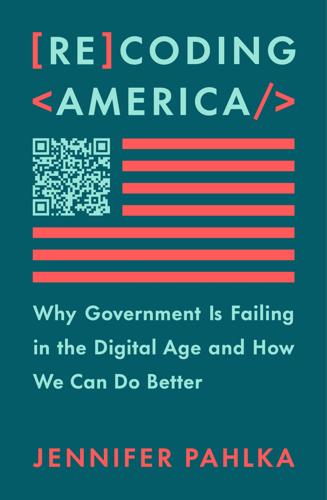
Recoding America: Why Government Is Failing in the Digital Age and How We Can Do Better
by
Jennifer Pahlka
Published 12 Jun 2023
Today, though, there are many voices among government leaders eager to change this framing. Chief among them is Cecilia Muñoz, a recipient of a MacArthur “genius grant” for her work on immigrant rights, who served as the head of Obama’s Domestic Policy Council. When the healthcare.gov crisis passed and the Obama administration turned its attention to proposals for immigration reform, Cecilia went out of her way to include our nascent White House tech team in the discussion. (Among the issues we highlighted was a service—once optional but now, in the proposed legislation, mandatory—that employers were required to use to verify the citizenship status of prospective employees; its clunky design meant that it would fail under the increased load.)
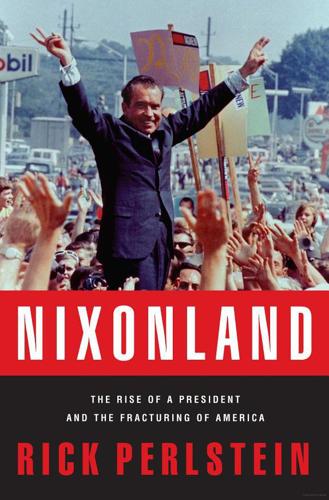
Nixonland: The Rise of a President and the Fracturing of America
by
Rick Perlstein
Published 1 Jan 2008
According to one poll, more Americans thought such protesters were “tools of the Communists” than disagreed with Johnson on Vietnam. Johnson kept on rolling out his Great Society: preschool for poor children, college prep for poor teenagers, legal services for indigent defendants, economic redevelopment funds for lagging regions, landmark immigration reform, a Department of Housing and Urban Development, national endowments for the humanities and arts—even a whole new category for the liberal agenda, environmentalism: a Highway Beautification Act, a Water Quality Act, a Clean Air Act, bulldozed through as if the opposition from the Big Three automakers, the advertising industry, and the chemical industry weren’t even there.
…
“Glad to see you,” he cried from his loudspeaker before jumping out impromptu style, just as he used to do on the campaign trail, in 1964, to shake hands with the commuters whose right-of-way his motorcade blocked. He was entering one of his manic phases. Before thirty thousand screaming fans in Newark, he opened with a favorite ritual: calling the roll of the people’s champions on the dais beside him: “The leader and the dean of your delegation, a fighter for immigration reform—a leader in the field of human rights! My supporter—Pete Rodino! “The sponsor of the Arts and Humanities Act…that greaaaaat progressive—Frank Thompson! “The energetic congressman who gave us the Vocational Rehabilitation Act, and my supporter—Dominick Daniels!” Johnson launched into the topic of his address: the opposing party.
…
He paraphrased Lincoln: “It is true that a house divided against itself, by the spirit of faction, of party, of region, of religion and race cannot stand.” Then: “Accordingly, I shall not seek, and I will not accept, the nomination of my party for another term as your president.” That was the bombshell. One thousand days ago he was changing the world: passing federal aid to education, immigration reform, voting rights, Medicare. Now, he was announcing his retirement. Wisconsin tramped to the polls. Reagan won 11 percent in write-ins. Then Nixon did what he always did in 1968 after a few weeks of intense campaigning: he rested, flying off to quiet, undeveloped Key Biscayne, Florida, where his friend Bebe Rebozo owned land.
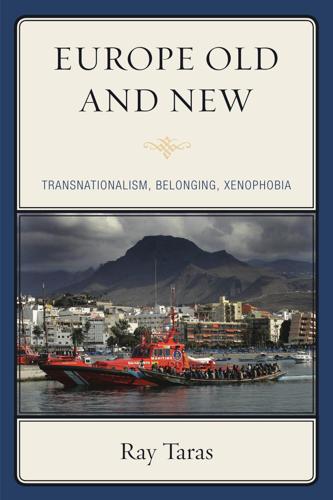
Europe old and new: transnationalism, belonging, xenophobia
by
Ray Taras
Published 15 Dec 2009
This is one of the most open countries in Europe in terms of immigration.” If “even” Sweden can be accused of racism, that left Switzerland as one of a few European countries that enjoyed a relatively wholesome image as a society devoid of racism. Its record has been impressive: over the past fifty years, the Swiss refused to pass thirteen proposed immigration reforms, including the 18 percent initiative in 2000 which would have limited the foreign-born resident population to this figure. But the image of an idyllic Swiss multicultural home came to grief in 2007 when an anti-immigrant nationalist party—the Swiss People’s Party (Schweizerische Volkspartei or SVP)—repeated its 2003 breakthrough and won the most number of seats to parliament (62 of 200), subsequently forming a coalition government.

#Republic: Divided Democracy in the Age of Social Media
by
Cass R. Sunstein
Published 7 Mar 2017
By itself, partyism is not the most serious threat to democratic self-government. But if it decreases government’s ability to solve serious problems, then it has concrete and potentially catastrophic consequences for people’s lives. I have offered the examples of gun control and climate change; consider also immigration reform and even infrastructure—issues on which the United States has been unable to make progress in recent years, in part because of the role of echo chambers. To be sure, the system of checks and balances is designed to promote deliberation and circumspection in government, and prevent insufficiently considered movement.
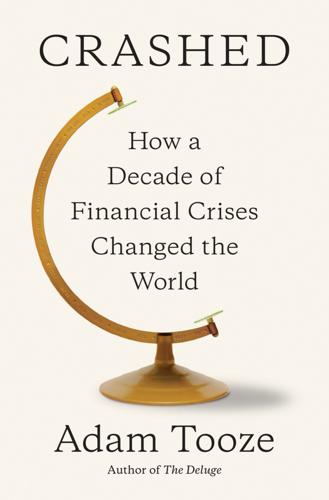
Crashed: How a Decade of Financial Crises Changed the World
by
Adam Tooze
Published 31 Jul 2018
62 Nor was it only foreigners who were worried. If the Tea Party would turn the Republican Party into a vehicle for an attack on the creditworthiness of US government, what was safe? So far the Tea Party had made Obamacare its main target. What would be next? By 2014 the Republican Right would block immigration reform and refuse to fund the Export-Import Bank, both priorities of American business. At the G20 the Americans were embarrassed to report that funding for the IMF was being held hostage by Republican opponents of abortion who wanted contraception excluded from Obamacare.63 What if the Republican zealots targeted Fed independence or trade policy next?
…
It had been crafted by Bush senior only to be carried across the line in 1993 by Clinton. In the 1990s “globalization” was a bipartisan project of the Republicans and the Rubinite wing of the Democratic Party. Their push extended not only to goods and capital. It extended to labor too. The business lobby favored immigration reform, which would give residence rights to the large and cheap workforce of undocumented migrants. Opposition to regulation of all kinds, “freedom” for labor, goods and capital were the ideological bracket that joined American business interests in a single block, from small contractors to the Davos set.

Palo Alto: A History of California, Capitalism, and the World
by
Malcolm Harris
Published 14 Feb 2023
Immigration restriction quickly became the organization’s domestic policy focus, especially with the ascendancy of the restrictionist John Tanton to the presidency of ZPG in 1975. A few years later, frightened in particular by Davis’s predictions in his 1974 Scientific American article, Tanton spun off the Federation for American Immigration Reform (FAIR), ridding himself of the moderate environmentalists in ZPG and focusing his attention on Mexico.63 Ehrlich would prefer to be remembered as one of those moderates, but he joined and led FAIR from the beginning, including with the coauthorship of The Golden Door: International Migration, Mexico, and the United States, a tract that strains to avoid the appearance of anti-immigrant alarmism but nonetheless concludes with a call for readers to join FAIR.64 In 1977, the professor cosigned a mass-mailed letter referring to illegal immigrants as a “human tidal wave.”65 Ehrlich joined some of the country’s most organized bigots, lending their propaganda a respectable Stanford face.
…
He went from being another right-wing donor with libertarian and trollish preferences that led him toward Ron Paul and Ted Cruz to a large independent power center within the party. He supported Kansas secretary of state (and former Ashcroft underling) Kris Kobach, who earlier worked as a lawyer for Ehrlich and Tanton’s Federation for American Immigration Reform, traveling around the country filing lawsuits and drafting bills to revoke rights from undocumented immigrants. Kobach drafted Arizona’s SB 1070, which required anyone stopped by the police to show immigration papers, a knowing salute to South African apartheid. His state laws were designed to test the boundaries and most of them ended up thrown out at various levels, but his aggression helped focus attention on immigration as a polarizing national issue.81 Thiel backed Kobach for the U.S.
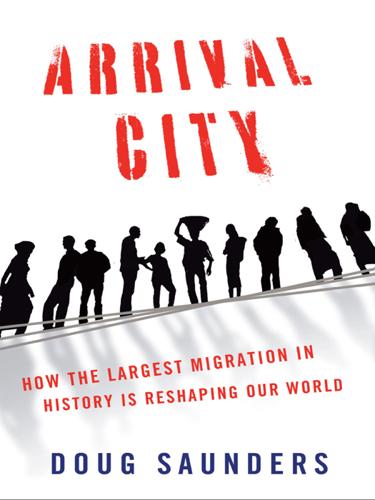
Arrival City
by
Doug Saunders
Published 22 Mar 2011
The United States has granted post-facto citizenship to millions of illegal immigrants in recent decades (most recently in the early 1990s); similar amnesties, involving hundreds of thousands of undocumented migrants, have been granted in Spain, Italy, France, Britain, and Germany. More such amnesties are almost certain in the future. A typical example is the U.S. Immigration Reform and Control Act, or IRCA, which began in 1986 as a congressional effort to stop, once and for all, the movement of Latin American villagers across the southern border. And yet, by the time it was passed, pressure from the Chamber of Commerce and agriculture lobbies had transformed it into a mass amnesty that provided legal citizenship to almost three million “illegals,” combined with a new program allowing low-skill migrants to enter under a guest-worker program demanded by agricultural industries in the western states.

Age of Discovery: Navigating the Risks and Rewards of Our New Renaissance
by
Ian Goldin
and
Chris Kutarna
Published 23 May 2016
The Economic Journal 124(580): 593–643. 60. Goldin, Ian (2012). Exceptional People: How Migration Shaped Our World and Will Define Our Future. Princeton, NJ: Princeton University Press. 61. Ibid. 62. Ibid. 63. Kosloski, Rey (2014, June 11). The American Way of Border Control and Immigration Reform Politics. Oxford: Oxford Martin School. 64. Miles, Tom (2015, September 25). “UN Sees Refugee Flow to Europe Growing, Plans for Big Iraq Displacement.” Reuters. Retrieved from www.reuters.com. 65. Spate, O. H. K. (1979). The Spanish Lake: The Pacific Since Magellan. Canberra: Australian National University Press, pp. 15–22. 66.
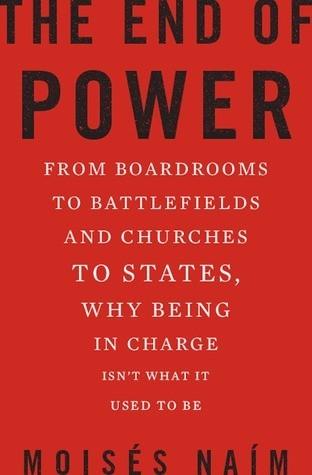
The End of Power: From Boardrooms to Battlefields and Churches to States, Why Being in Charge Isn’t What It Used to Be
by
Moises Naim
Published 5 Mar 2013
The results of this OECD survey and other relevant reports can be found at www.globalworksfoundation.org/Documents/fact465.science_000.pdf. 8. Brzezinski, Strategic Vision: America and the Crisis of Global Power. 9. Jason DeParle, “Global Migration: A World Ever More on the Move,” New York Times, June 26, 2010. 10. Jorge G. Castañeda and Douglas S. Massey, “Do-it-Yourself Immigration Reform,” New York Times, June 1, 2012. 11. The figures on remittances are quoted from the World Bank Development Indicators Database (2011 edition). 12. Dean Yang, “Migrant Remittances,” in Journal of Economic Perspectives 25, no. 3 (Summer 2011), pp. 129–152 at p. 130. 13. Richard Dobbs, “Megacities,” Foreign Policy, September–October 2010, http://www.foreignpolicy.com/articles/2010/08/16/prime_numbers_megacities. 14.
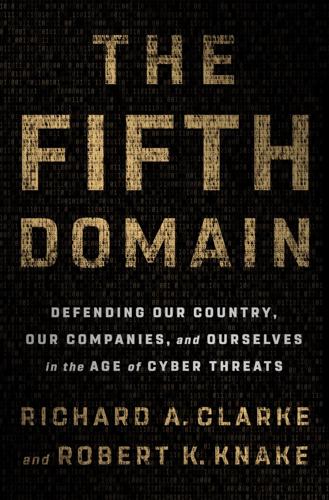
The Fifth Domain: Defending Our Country, Our Companies, and Ourselves in the Age of Cyber Threats
by
Richard A. Clarke
and
Robert K. Knake
Published 15 Jul 2019
There’s an unholy trinity of forces that have an interest in hyping the crisis. The first are companies that don’t like the high salaries that cybersecurity professionals demand. Attracting more people to the field, creating a slack in demand, and driving down costs would be of interest. Every time the issue of immigration reform comes up in Congress, the tech companies, in the hopes of expanding the H-1B visa program for technical workers, cite the cybersecurity workforce crisis as one of the main drivers. The second player in this trinity is the cybersecurity industry itself, which does not necessarily want more workers in the field.

Siege: Trump Under Fire
by
Michael Wolff
Published 3 Jun 2019
This was part of the continuing Kushner plan to cultivate a new atmosphere and a new “cordiality,” he told confidants, with Democrats. Kushner was even suggesting that Trump might pivot from the Republicans and make several key deals with Democrats—on infrastructure, on drug pricing, and on Kushner’s fond notion of a far-reaching immigration reform bill. Just as he had been from the beginning of his presidency, a fundamentally self-obsessed and otherwise uninterested Trump was willing to accede to his daughter and son-in-law’s desire for establishment status. At the same time, he was—and he usually, if not always, understood this—utterly dependent on his hard-core supporters’ belief that he stood for what they stood for.
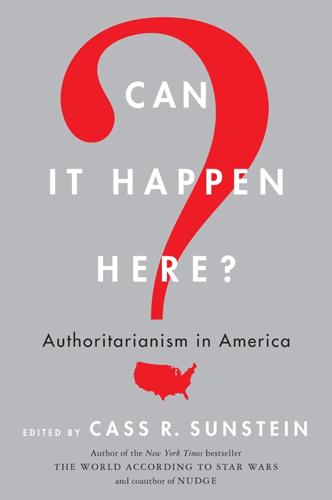
Can It Happen Here?: Authoritarianism in America
by
Cass R. Sunstein
Published 6 Mar 2018
Ronald Reagan claimed that “preservation of our environment is not a liberal or conservative challenge, it’s common sense.” Both Hillary Clinton and Barack Obama have argued for “commonsense gun control” efforts such as legislation that would require universal background checks. Paul Ryan has called for “commonsense conservatism,” including immigration reform and rolling back of FDA regulations. And Ted Cruz has referred to reductions in top marginal tax rates as commonsense tax reform. In all these cases, the speaker is appealing to what Rosenfeld (2011, p. 145) calls “the instinctive perceptions, unschooled logic, and simple style of . . . ‘plain sensible men,’ ” often in contrast with so-called elites.1 The irony, of course, is that those invoking common sense are almost always members of the political elite whose agendas may well be at odds with the interests of “plain sensible men.”
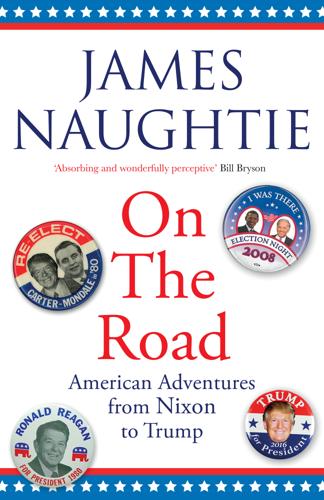
On the Road: Adventures From Nixon to Trump
by
James Naughtie
Published 1 Apr 2020
At the death of John McCain, whose long imprisonment in North Vietnam had turned him into a hero for most Americans, the president made no effort to go back on his criticisms of a man who had offended him grievously – most probably, by being a Republican who tried to work across the aisle in the Senate (notably with Ted Kennedy) in an effort to find a consensus on immigration reform. McCain wanted to devise a ‘pathway to citizenship’ for the millions of undocumented migrants living in the United States, many of them settled for a generation and more, with working children and grandchildren educated in the US who probably spent less time wondering about how to pare down their tax bills from the Internal Revenue Service than Trump himself, or his lawyers.
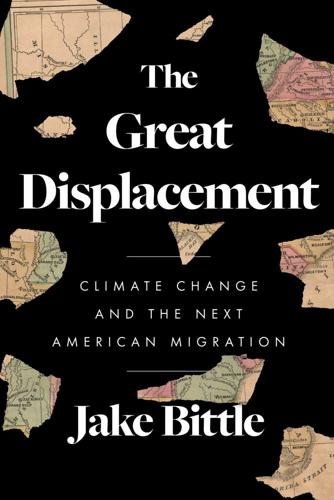
The Great Displacement: Climate Change and the Next American Migration
by
Jake Bittle
Published 21 Feb 2023
Going even further, the federal government could invest in high-density social housing in major cities, giving people who migrate to these places an affordable and sustainable place to stay; local governments could also relax zoning restrictions to allow for more construction, which would bring down costs. The issue of international migration presents an even more profound challenge. The politics of immigration reform are complex, vicious, and almost impossible to navigate, and no bipartisan (or even partisan) plan seems forthcoming, but as the decades go on, the issue will get harder and harder to ignore. If the United States does not take steps to open its borders to more migrants, it will not only condemn millions of people to destitution and danger but will also miss out on an enormous opportunity for economic growth and revitalization.
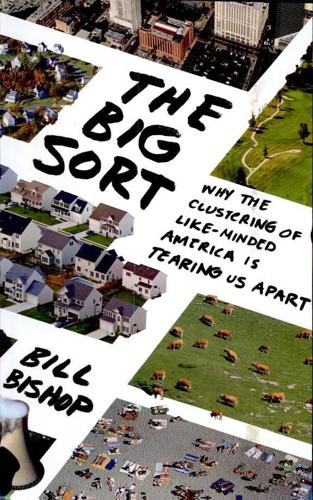
The Big Sort: Why the Clustering of Like-Minded America Is Tearing Us Apart
by
Bill Bishop
and
Robert G. Cushing
Published 6 May 2008
Polsby wrote, "In important respects the U.S. population resembles the population that attempted to build the Tower of Babel."33 By 2006, even the slow-moving wheels of government had seized up. In June, Charles Babington wrote in the Washington Post, "Congress seems to be struggling lately to carry out its most basic mission: passing legislation."34 Whatever the issue—the minimum wage, immigration reform, bankrupt pensions, global warming, energy policy, stem cell research, inquiries into domestic surveillance, resolutions on the war in Iraq—it slipped under the surface of Congress's deepening pool of discord. In early July, former House Republican leader Dick Armey said bluntly, "I'm not sure what this Congress has accomplished."35 So Congress quit pretending and just stopped meeting.

Work Rules!: Insights From Inside Google That Will Transform How You Live and Lead
by
Laszlo Bock
Published 31 Mar 2015
He is a member of the board of trustees of Pomona College and has served as an advisor or board member of several venture capital-funded companies. He earned a bachelor’s degree in international relations from Pomona College and an MBA from the Yale School of Management. Laszlo has testified before Congress on immigration reform and labor issues. He has been featured in the Wall Street Journal, the New York Times, the Washington Post, and on PBS NewsHour and the Today show. In 2010 he was named “Human Resources Executive of the Year” by Human Resource Executive magazine. In 2014 they named him one of the “ten most influential people impacting HR” for the decade, the only HR executive to be named to the list.

World Cities and Nation States
by
Greg Clark
and
Tim Moonen
Published 19 Dec 2016
The City is supported by New York State, which has actively invited immigrants through the federal system and established an Office for New Americans to assist with integration and entrepreneurship (Aon and the Partnership for New York City, 2013; Semple, 2013). New York political leaders are leading proponents of fairer and more effective immigration reform. Former Mayor Michael Bloomberg continues to co‐chair the Partnership for a New American Economy, which leads an effort to reform national immigration policy. In the years ahead, New York’s profile as a city that is open to talent and newcomers will likely depend on the federal government debate becoming less antagonistic and more flexible to the human capital needs of its large cities (Jorgensen, 2014).

The Job: The Future of Work in the Modern Era
by
Ellen Ruppel Shell
Published 22 Oct 2018
“there may have been a time and a place for unions” Kevin Rose, “Silicon Valley’s Anti-Unionism, Now with a Side of Class Warfare,” New York Magazine, July 2013. Still, it’s worth pointing out that not a few of these new economy employers recognize the value of collective action in pursuit of their own goals. Consider, for example, the sudden involvement of industrial leadership in immigration reform. In April 2013, Facebook founder and CEO Mark Zuckerberg collaborated on the launch of Fwd.us, a proimmigration collective whose members included Bill Gates, Google’s Eric Schmidt, Yahoo CEO Marissa Mayer, and Silicon Valley venture capitalist and billionaire John Doerr. narrows the gap between the highest and lowest earners Derek C.
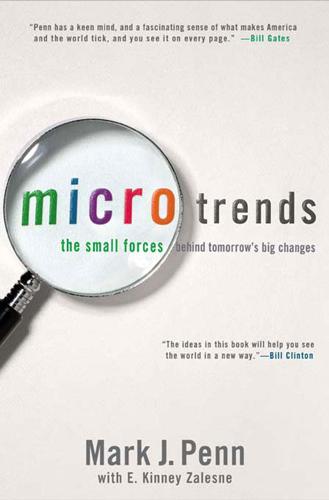
Microtrends: The Small Forces Behind Tomorrow's Big Changes
by
Mark Penn
and
E. Kinney Zalesne
Published 5 Sep 2007
In matching white T-shirts, in 140 cities, and in at least thirty-nine states. From Phoenix to Philadelphia, from Boise to Birmingham, hundreds of thousands of illegal immigrants marched in organized parades, in front of TV cameras, to protest the House-passed bill and to call instead for liberalized immigration reform that would not narrow but widen the path to citizenship. In Atlanta, the birthplace of America’s civil rights movement, the marchers held placards reading, “We Have a Dream, Too.” In Mississippi, they sang “We Shall Overcome” in Spanish. In Los Angeles, the rally in March 2006 was said to be the largest in the history of the city, and perhaps in all of the Western United States.
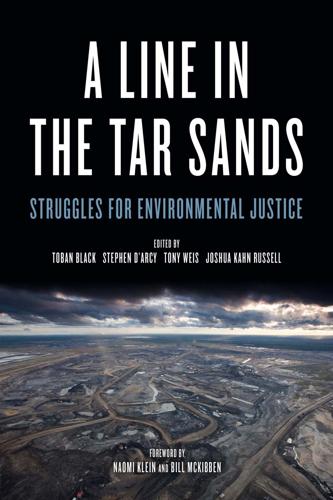
A Line in the Tar Sands: Struggles for Environmental Justice
by
Tony Weis
and
Joshua Kahn Russell
Published 14 Oct 2014
As Naomi Klein has warned, Obama’s first term must be a lesson to all activists that the appearance of a progressive leader should not lull us into a false sense of accomplishment; there is simply no room for a honeymoon or hero worship, as though we only need to elect the right leader. Only grit and hard work will do. There have been some great cultural shifts and organizing successes in the US in recent years, like the marriage equality and immigration reform movements. But breaking the power of oil companies may be even harder, because the sums of the money on the other side are so fantastic—there are trillions of dollars’ worth of oil in Canada’s tar sands alone, and the people who own these resources will spend what they need to assure their victories.

The Ones We've Been Waiting For: How a New Generation of Leaders Will Transform America
by
Charlotte Alter
Published 18 Feb 2020
* * * Carlos Curbelo was in a tough spot: he was a moderate anti-Trump Republican representing a Democratic-leaning district that included the Miami suburbs and the Florida Keys. His 70 percent Latino district was full of recent immigrants, and his constituents regularly felt the brunt of persistent flooding as hurricanes got stronger with every year of warming. That was part of the reason he had tried to steer his party toward immigration reform and climate change solutions, joining the small but growing cohort of Republicans who hoped to move the ball toward issues that millennials were concerned about. But in the party of Trump, he was drowning: even though he’d been reelected in 2016, his voters had chosen Clinton over Trump by the second highest margin of any Republican-held district in the nation.
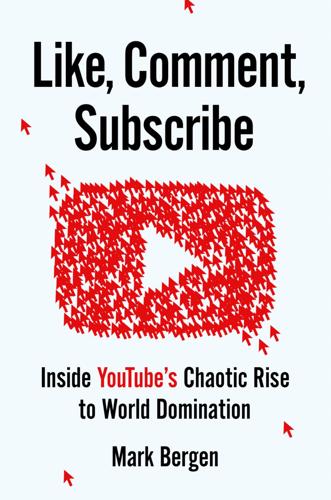
Like, Comment, Subscribe: Inside YouTube's Chaotic Rise to World Domination
by
Mark Bergen
Published 5 Sep 2022
He used deputies like Yiannopoulos to “activate” an army of disaffected, extremely online supporters. “They come in through Gamergate or whatever and then get turned onto politics and Trump,” Bannon told the journalist Joshua Green. Breitbart News had shown its political heft two years earlier when its fire-breathing coverage spiked a Senate immigration reform bill, despite support from the conservative standard-bearers Fox News and Rush Limbaugh. Now Bannon, months from becoming Trump’s chief strategist, played ringleader for the “alt-right,” a network of internet personalities, provocateurs, and racists. Green, the journalist, aptly described this movement as “a rolling tumbleweed of wounded male id and aggression.”

The Transformation Of Ireland 1900-2000
by
Diarmaid Ferriter
Published 15 Jul 2009
But I miss the warmth of Ireland.’153 America, too, provided a new outlet for the wandering Irish, where earlier in the century they had established themselves at the centre of the labour movement, the politics of the cities, the Church and even literature. Their legal status was one of the foremost concerns in the 1980s. Although 9,900 emigrated legally in 1989, many more went illegally to cities like New York, Boston and Chicago, and became active in the Irish Immigration Reform Movement. A notable success of their campaign was the Immigration Reform and Control Act. Of the 40,000 green cards available under this scheme, 16,329 went to Irish applicants, a measure of the social and political influence they could generate in America, though many Irish women ended up once again in private homes looking after children and the elderly.154 As with Britain, it was the fact that the emigrants were better educated which facilitated their more innovative pursuits, with many finding their way into journalism, publishing and television, making an impact beyond their numbers.
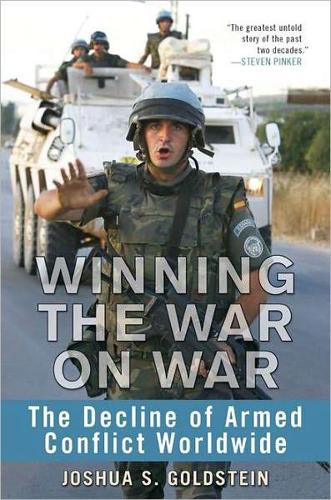
Winning the War on War: The Decline of Armed Conflict Worldwide
by
Joshua S. Goldstein
Published 15 Sep 2011
Between the “work for justice” peace activists, the antinuclear movement, and the inner spiritual peace approach, what is largely missing is a peace movement speaking up for the UN, for peacekeeping, for the multidimensional efforts of international, national, and private organizations to stop wars and keep the peace. So the peace movement all across America, organized and motivated for peace, puts its efforts into helping the homeless, pressing for immigration reform, supporting health care reform—and none of these efforts are ending the world’s wars. And then out there in the eastern Congo is a soldier from Bangladesh with a blue UN helmet, trying to stop the violence of a society torn apart by decades of war after decades of colonialism. And this soldier does not have enough comrades, enough equipment, enough political support, to do half of what he or she could do with adequate resources.
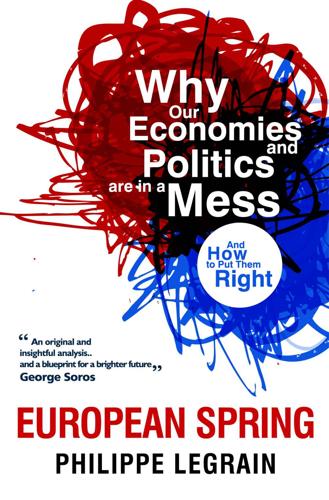
European Spring: Why Our Economies and Politics Are in a Mess - and How to Put Them Right
by
Philippe Legrain
Published 22 Apr 2014
, American Economic Journal, 2010 624 Based on information available at http://www.nobelprize.org/. 625 Carsten Fink, Ernest Miguelez, Julio Raffo, "The global race for inventors", Vox.eu, 17 July 2013 http://www.voxeu.org/article/global-race-inventors 626 http://www.independent.co.uk/news/uk/politics/nobel-winner-slates-britains-stupid-immigration-reforms-8433324.html 627 Francesc Ortega and Giovanni Peri, “The effects of Brain Gain on Growth, Investment, and Employment: Evidence from the OECD countries, 1980–2005”, in Boeri T., Brucker H, Docquier F., Rapoport H. (eds) Brain Drain and Brain Gain, Oxford: 2012 628 Alberto Alesina, A Devleeschauwer, S Kurlat and R Wacziarg, "Fractionalization", Journal of Economic Growth, 8(2): 155-194, 2003 629 I pointed this out in Immigrants in my rebuttal of David Goodhart’s anti-diversity arguments. 630Alberto Alesina, J Harnoss and H Rapoport, “Birthplace diversity and economic prosperity”, NBER Working Paper #18699, January 2013 631 Alessandra Venturini, F.

Good Economics for Hard Times: Better Answers to Our Biggest Problems
by
Abhijit V. Banerjee
and
Esther Duflo
Published 12 Nov 2019
Muslims are simultaneously falling behind the Hindu population in economic terms and are the target of rising levels of violence from the majority Hindu population. 24 Jane Coaston, “How White Supremacist Candidates Fared in 2018,” Vox, November 7, 2018, accessed April 22, 2019, https://www.vox.com/policy-and-politics/2018/11/7/18064670/white-supremacist-candidates-2018-midterm-elections. 25 Robert P. Jones, Daniel Cox, Betsy Cooper, and Rachel Lienesch, “How Americans View Immigrants and What They Want from Immigration Reform: Findings from the 2015 American Values Atlas,” Public Religion Research Institute, March 29, 2016. 26 Leonardo Bursztyn, Georgy Egorov, and Stefano Fiorin, “From Extreme to Mainstream: How Social Norms Unravel,” NBER Working Paper 23415, 2017. 27 Cited in Chris Haynes, Jennifer L. Merolla, and S.
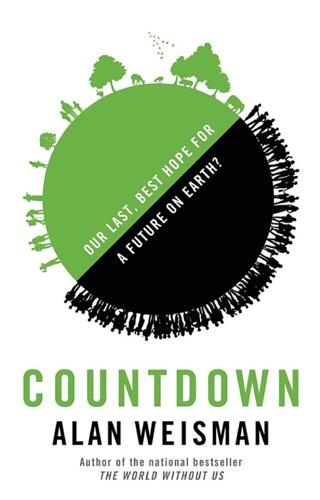
Countdown: Our Last, Best Hope for a Future on Earth?
by
Alan Weisman
Published 23 Sep 2013
Population Action International, Guttmacher Institute, October 4, 2011. http://populationaction.org/articles. Martin, Glen. “Taking the Heat: Bay Area Ecosystems in the Age of Climate Change.” January 1, 2008. http://baynature.org/articles/taking-the-heat. Martin, Jack, and Stanley Fogel. “Projecting the U.S. Population to 2050: Four Immigration Scenarios.” A report by the Federation of American Immigration Reform, March 2006. http://www.fairus.org/site/DocServer/pop_projections.pdf. “Melinda Gates’ New Crusade: Investing Billions in Women’s Health.” Daily Beast, May 7, 2012. Melnick, Meredith. “Is the Catholic Church’s Argument Against IVF a Bit Holey?” Heathland.Times.com, October 8, 2010. Moore, Malcolm, and Peter Foster.
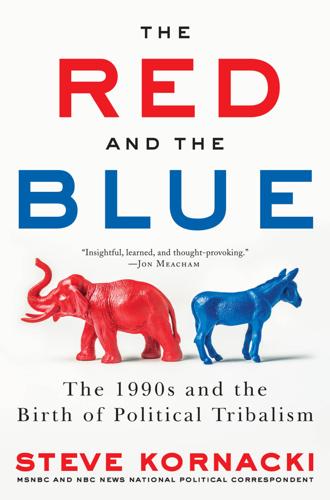
The Red and the Blue: The 1990s and the Birth of Political Tribalism
by
Steve Kornacki
Published 1 Oct 2018
Buchanan, wrote George Will, “evidently does not understand what distinguishes American nationality—and should rescue our nationalism from nativism.” The Republican Party’s most recent national platform included a commitment to “welcome those from other lands who bring to America their ideals and industry” along with a cursory nod to border security. This posture stemmed from the immigration reform signed by Reagan in 1986. It aimed to accommodate those who had come to the country illegally but lived otherwise lawful lives with a promise to curtail future illegal crossings. Nearly three million people, many of them from Mexico, had since qualified for green cards under the law, but the flow of illegal entries hadn’t stopped.

Thank You for Being Late: An Optimist's Guide to Thriving in the Age of Accelerations
by
Thomas L. Friedman
Published 22 Nov 2016
But in recent years the Tea Party and other hyperconservative forces, also funded in large part by fossil fuel companies and oil billionaires, have tried to wipe out the Republican Party’s once rich polyculture and turn it into a monoculture that’s enormously susceptible to diseased ideas: climate change is a hoax; evolution never happened; we don’t need immigration reform. All of this weakened the G.O.P.’s foundation and opened the way for an invasive species such as Donald Trump to make deep inroads into its garden. A 2012 study by the Kauffman Foundation revealed that immigrants founded one-quarter of U.S. technology start-up companies. The study, entitled “America’s New Immigrant Entrepreneurs: Then and Now,” shows that “24.3 percent of engineering and technology start-up companies have at least one immigrant founder serving in a key role,” Reuters reported on October 2, 2012.
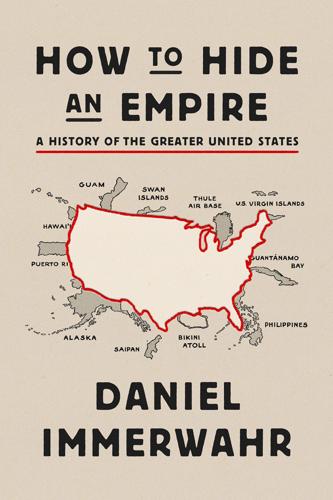
How to Hide an Empire: A History of the Greater United States
by
Daniel Immerwahr
Published 19 Feb 2019
Saipan functioned as a sort of standing loophole. Starting in 1995, as stories of its exploited workers made their way to the mainland, members of Congress sought to close it. Over the next decade or so, they would submit at least twenty-nine bills to change some part of the relevant law. Twice the Senate voted unanimously for wage and immigration reforms, only to have the bills die in the House Committee on Resources. A 1999 House bill had 243 cosponsors, a substantial majority. But it, too, died. The Northern Marianas government and the garment manufacturers, it turned out, had hired a lobbyist to defend their lucrative arrangement. A really, really good lobbyist.
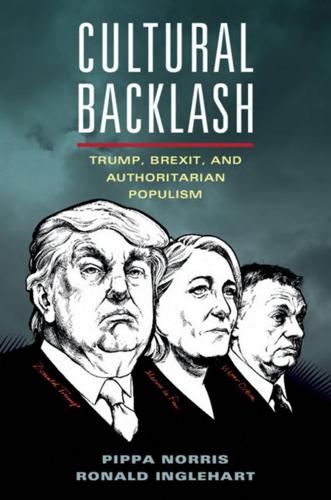
Cultural Backlash: Trump, Brexit, and Authoritarian Populism
by
Pippa Norris
and
Ronald Inglehart
Published 31 Dec 2018
Perspectives on Politics 4 (3): 495–505. 45. John Sides and Jack Citrin. 2007. ‘European opinion about immigration: The role of identities, interests and information.’ British Journal of Political Science 37 (3): 477–504. 46. Jack Citrin, Donald P. Green, C. Muste, and C. Wong. 1997. ‘Public opinion towards immigration reform: The role of economic motivations.’ Journal of Politics 59: 858–881; V.M. Esses, L.M. Jackson, and T.L. Armstrong. 1998. ‘Intergroup competition and attitudes toward immigrants and immigration: An instrumental model of group conflict.’ Journal of Social Issues 54: 699–724; G. Lahav. 2004. Immigration and Politics in the New Europe.
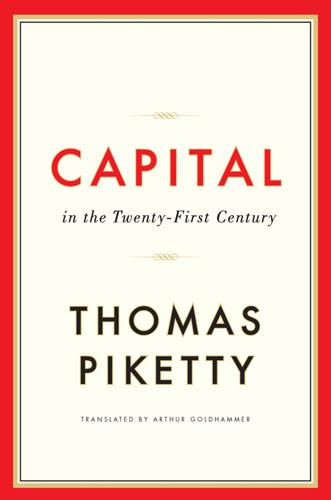
Capital in the Twenty-First Century
by
Thomas Piketty
Published 10 Mar 2014
Chapter 14 proposes a rethinking of the progressive income tax based on past experience and recent trends. Chapter 15 describes what a progressive tax on capital adapted to twenty-first century conditions might look like and compares this idealized tool to other types of regulation that might emerge from the political process, ranging from a wealth tax in Europe to capital controls in China, immigration reform in the United States, and revival of protectionism in many countries. Chapter 16 deals with the pressing question of public debt and the related issue of the optimal accumulation of public capital at a time when natural capital may be deteriorating. One final word. It would have been quite presumptuous in 1913 to publish a book called “Capital in the Twentieth Century.”

Bourgeois Dignity: Why Economics Can't Explain the Modern World
by
Deirdre N. McCloskey
Published 15 Nov 2011
The farmers complain because without immigrants, legal or illegal, they are unable to harvest their crops. Openness to immigration was, indeed, an important part of the liberal rope, as against the xenophobia we see from time to time even in a liberal Europe and United States. (The comedian Steven Colbert testified to a congressional hearing on immigration reform on September 24, 2010, that “My grandfather did not travel across four thousand miles of the Atlantic Ocean to see this country overrun by immigrants. He did it because he killed a man back in Ireland.”) The journalist Álvaro Vargas Llosa notes that because of Milton Friedman and others making the Smithian-liberal case in the twentieth century, “arguing for tariffs against competition for the sake of protecting an industry has lost its prestige and comes at a price for those who dare speak openly in such terms.”

The Rise and Fall of American Growth: The U.S. Standard of Living Since the Civil War (The Princeton Economic History of the Western World)
by
Robert J. Gordon
Published 12 Jan 2016
Policy solutions include immigration, to raise the number of tax-paying workers, together with tax reforms that would raise revenue and improve tax equity. A carbon tax, desirable on environmental grounds to reduce carbon emissions, has the side benefit of generating substantial revenue to help alleviate the fiscal headwind. Immigration Reform of immigration can be accomplished in a way that raises the average skill level of the working-age population and that thus contributes to the growth of labor productivity. One avenue for reform would be to end the practice of denying residency to foreign-born graduates of U.S. universities, a “self-imposed brain drain.”

Southwest USA Travel Guide
by
Lonely Planet
It has its gorgeous, iconic sites, but it’s the road that breathes life into a trip. Take Route 66 into Flagstaff for a dose of mom-and-pop friendliness. Channel the state’s mining past on a twisting drive through rugged Jerome. Reflect on Native American history as you drive below a mesa-top Hopi village. Political controversies – such as immigration reform and budget slashing – have grabbed headlines recently, but these hot-button issues need perspective. Politicians are temporary. But the sunset beauty of the Grand Canyon, the saguaro-dotted deserts of Tucson and the red rocks of Sedona... they’re here for the duration and hoping you’ll stop by, regardless of the politics.

Eastern USA
by
Lonely Planet
The South, more than any other region, is a culture unto itself; over half of all black Americans live here. These examples are just a fraction of the complex whole. The East, like the rest of the country, can never quite decide if the continual influx of newcomers is its saving grace or what will eventually strain society to the breaking point. ‘Immigration reform’ has been a Washington buzzword for over a decade. Some people believe the nation’s current system deals with illegal immigrants (there are 11 million of them, compared to 470,000 legal immigrants) too leniently – that we should deport immigrants who are here unlawfully and fine employers who hire them.

USA Travel Guide
by
Lonely, Planet
Immigrants currently make up about 12% of the population. About 470,000 newcomers enter the US legally each year, with the majority from Mexico, followed by Asia and Europe. Another 11 million or so are in the country illegally. This is the issue that makes Americans edgy, especially as it gets politicized. ‘Immigration reform’ has been a Washington buzzword for more than a decade. Some people believe the nation’s current system deals with illegal immigrants too leniently – that walls should be built on the border, immigrants who are here unlawfully should be deported and employers who hire them should be fined. Other Americans think those rules are too harsh – that immigrants who have been here for years working, contributing to society and abiding by the law deserve amnesty.